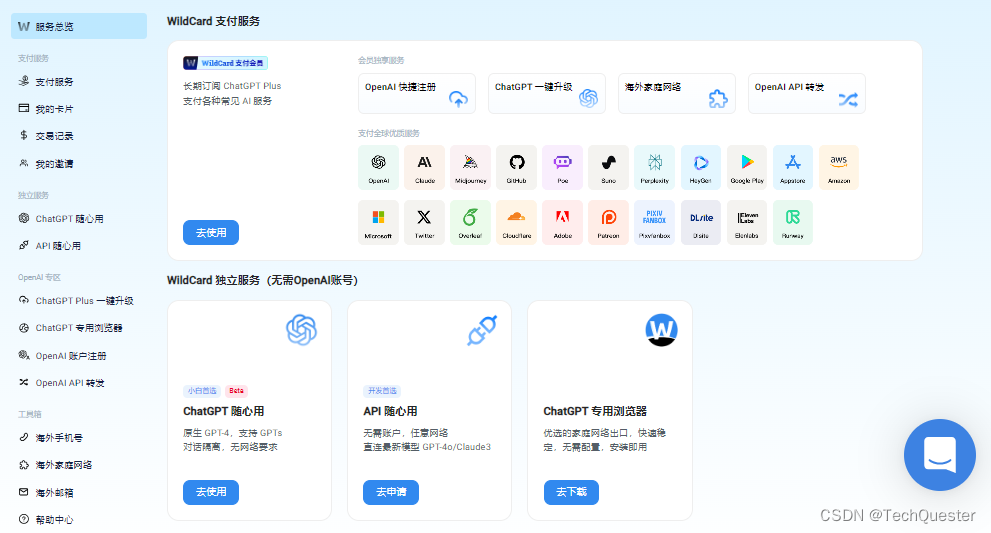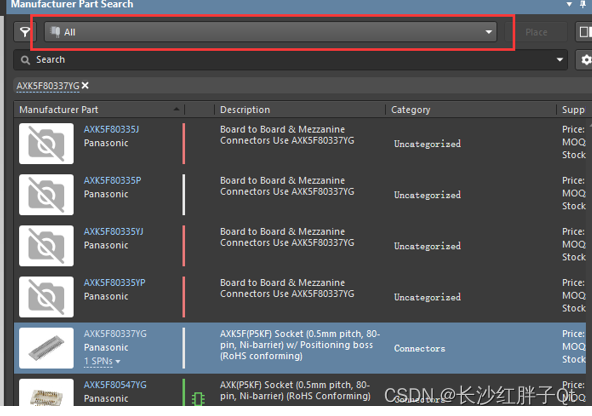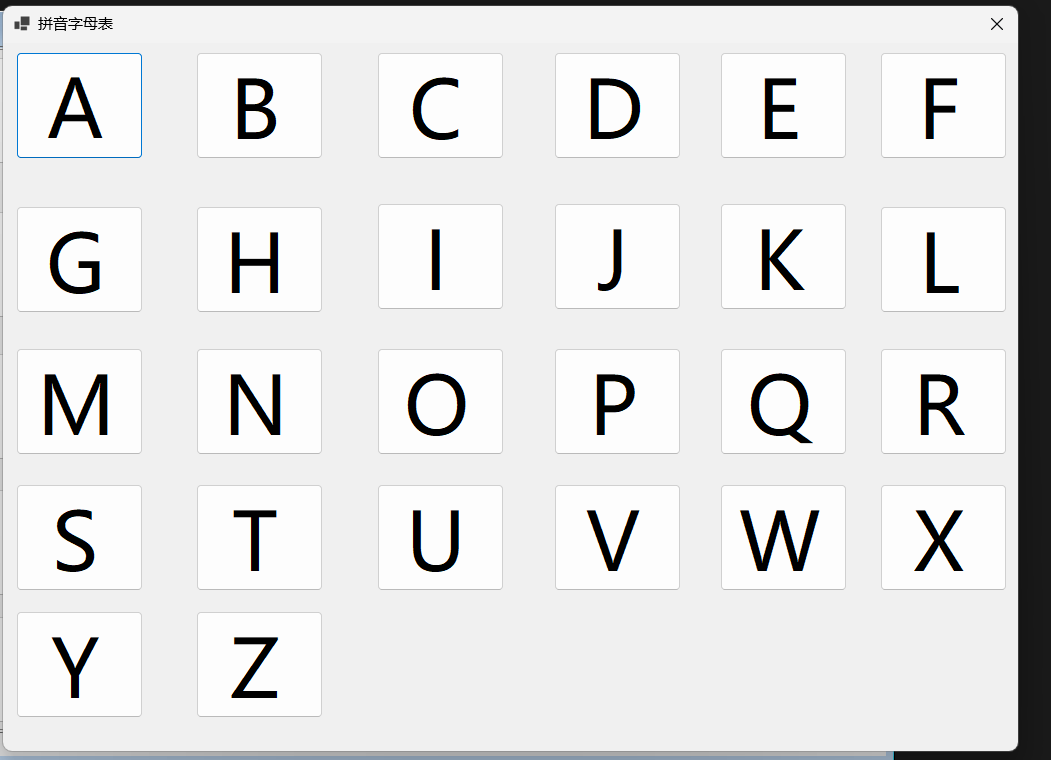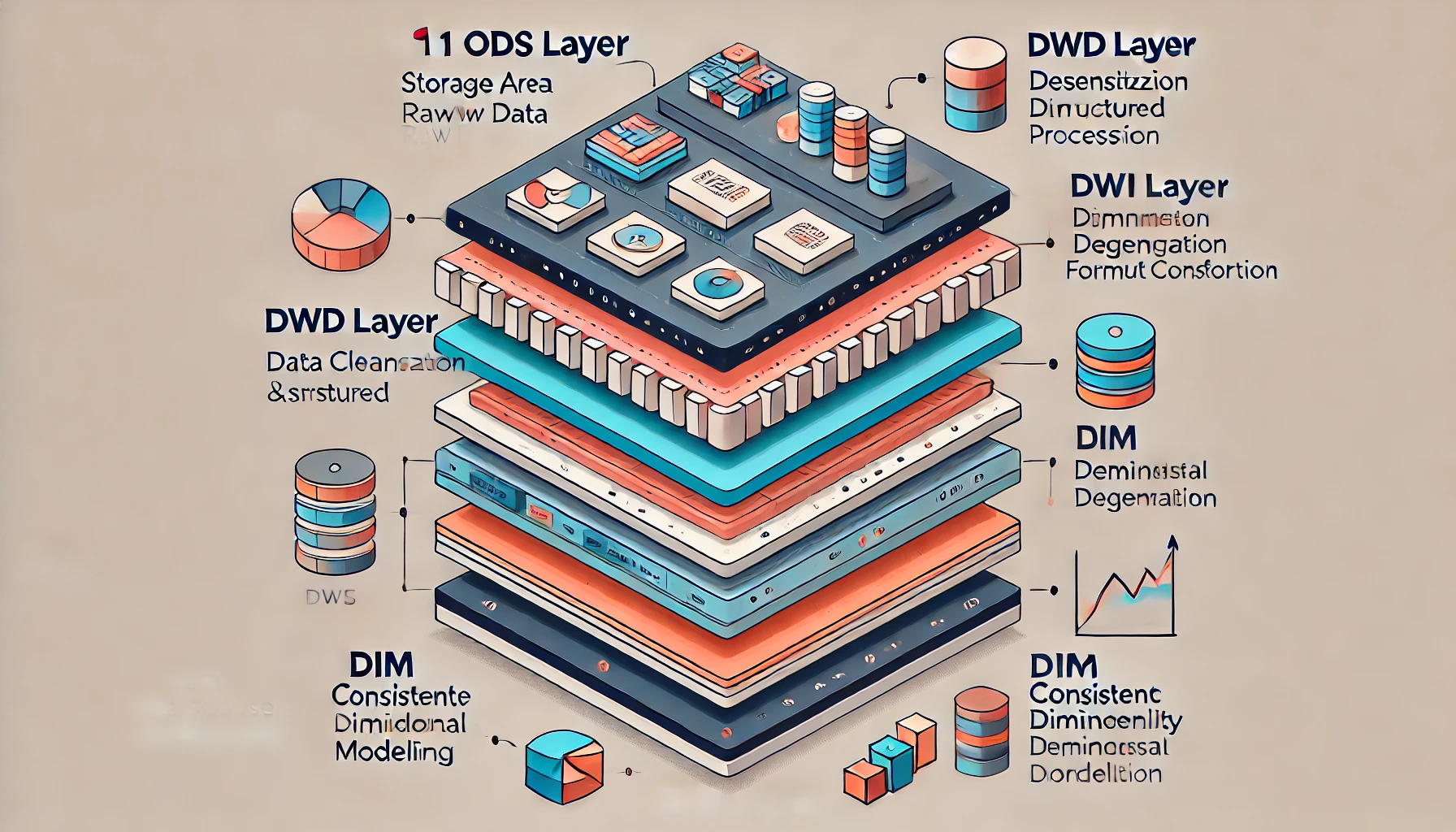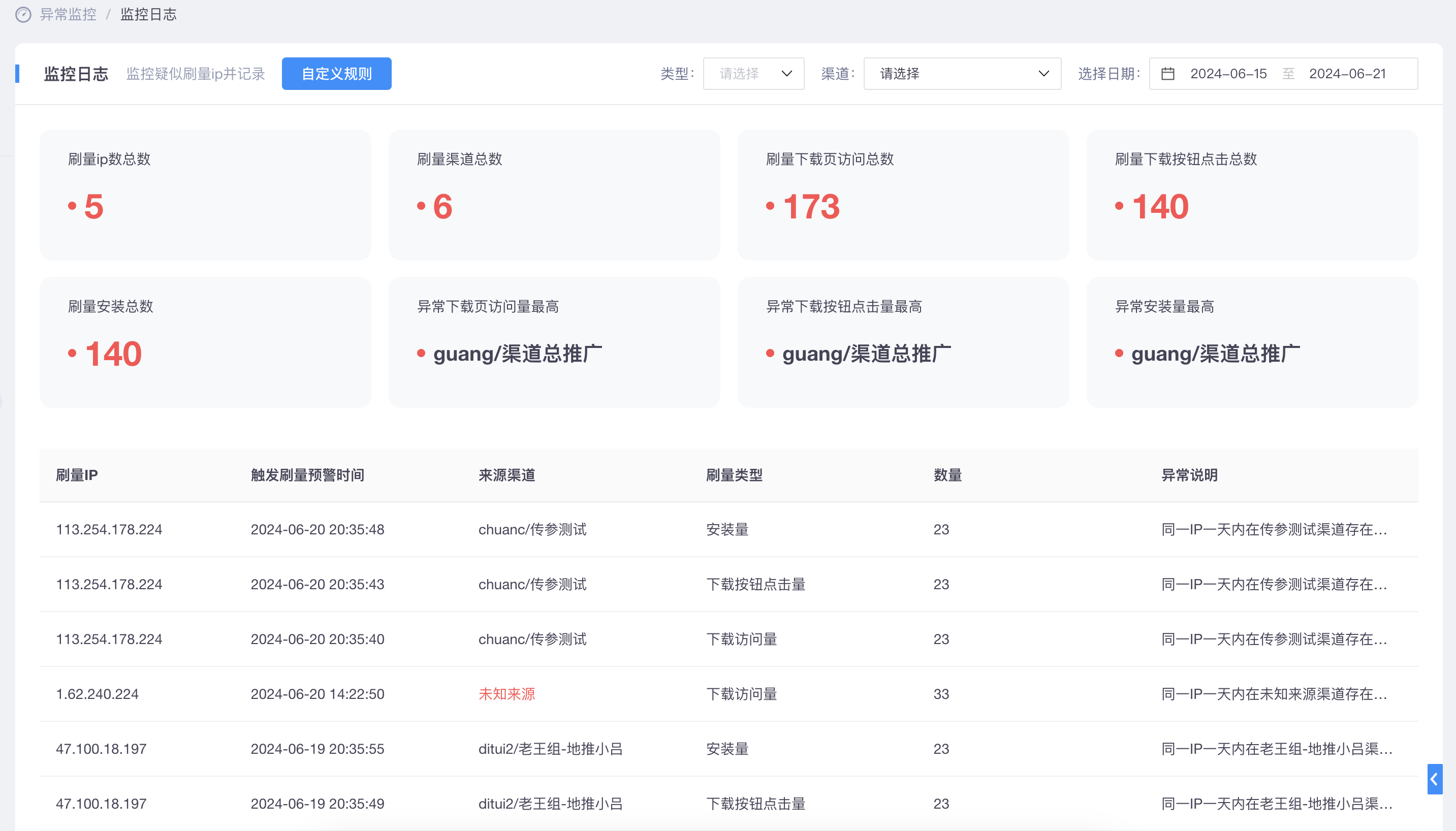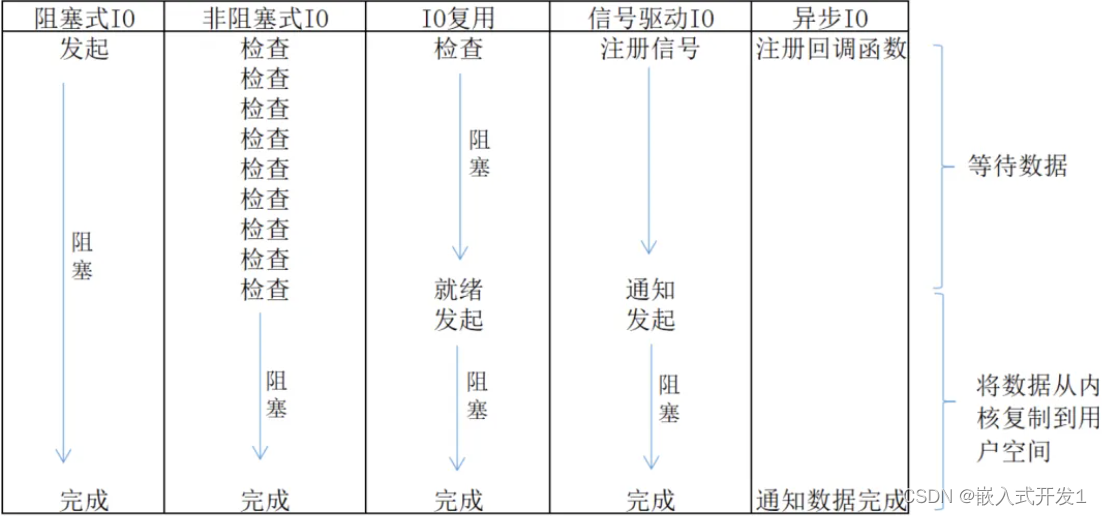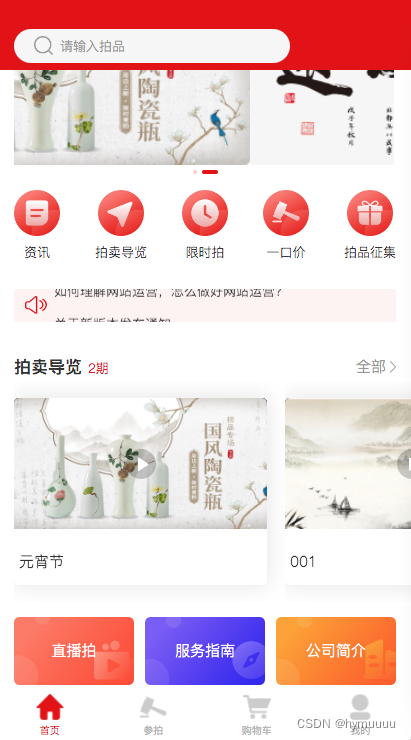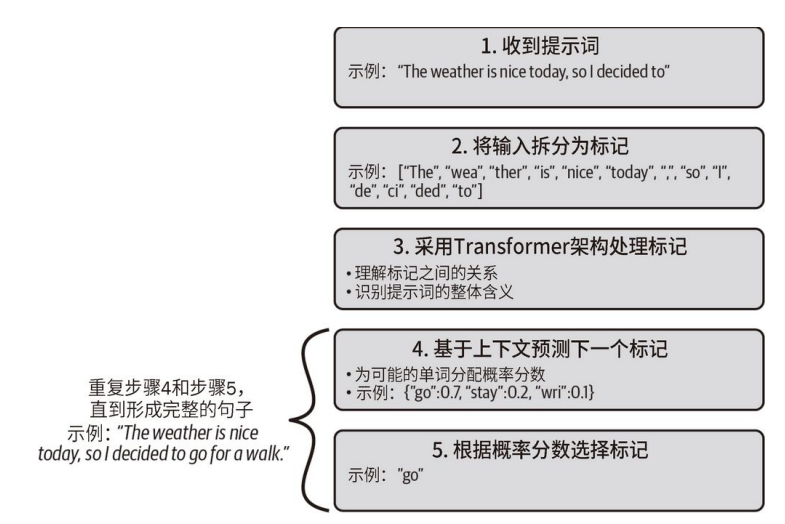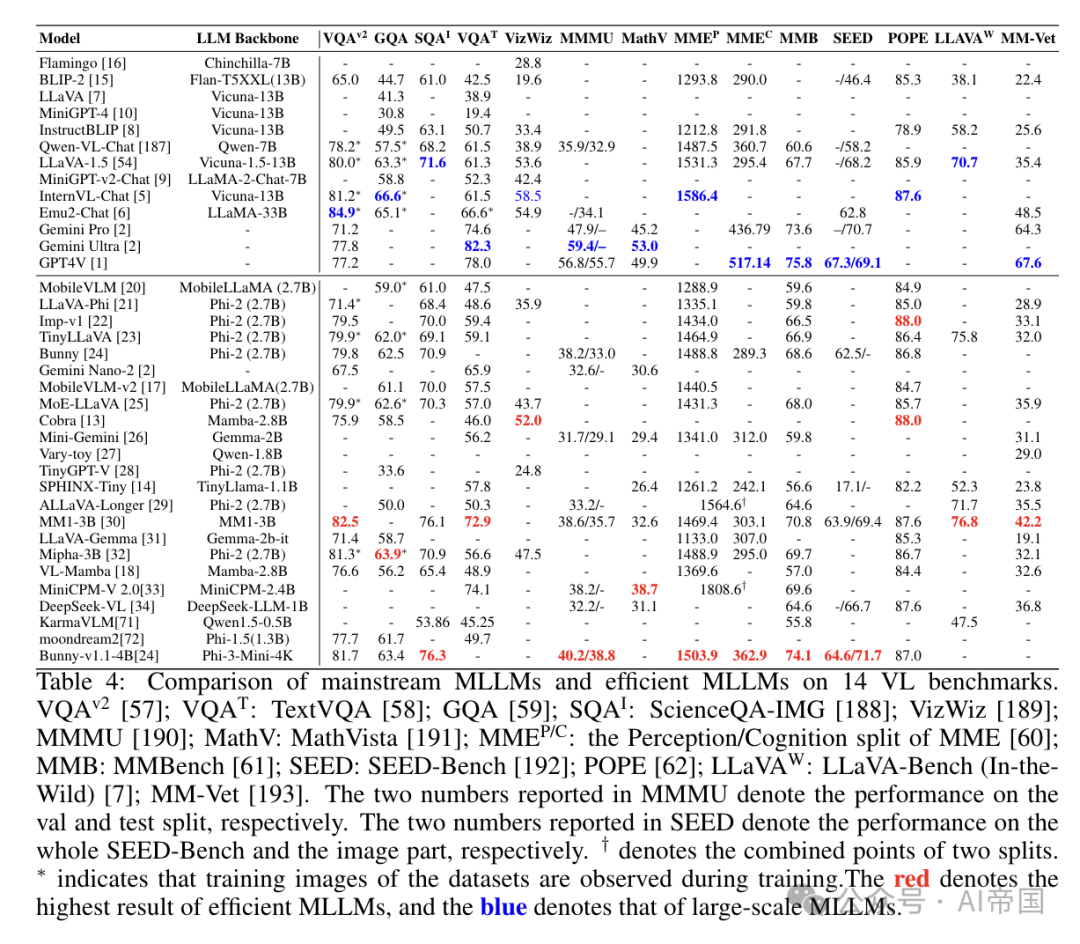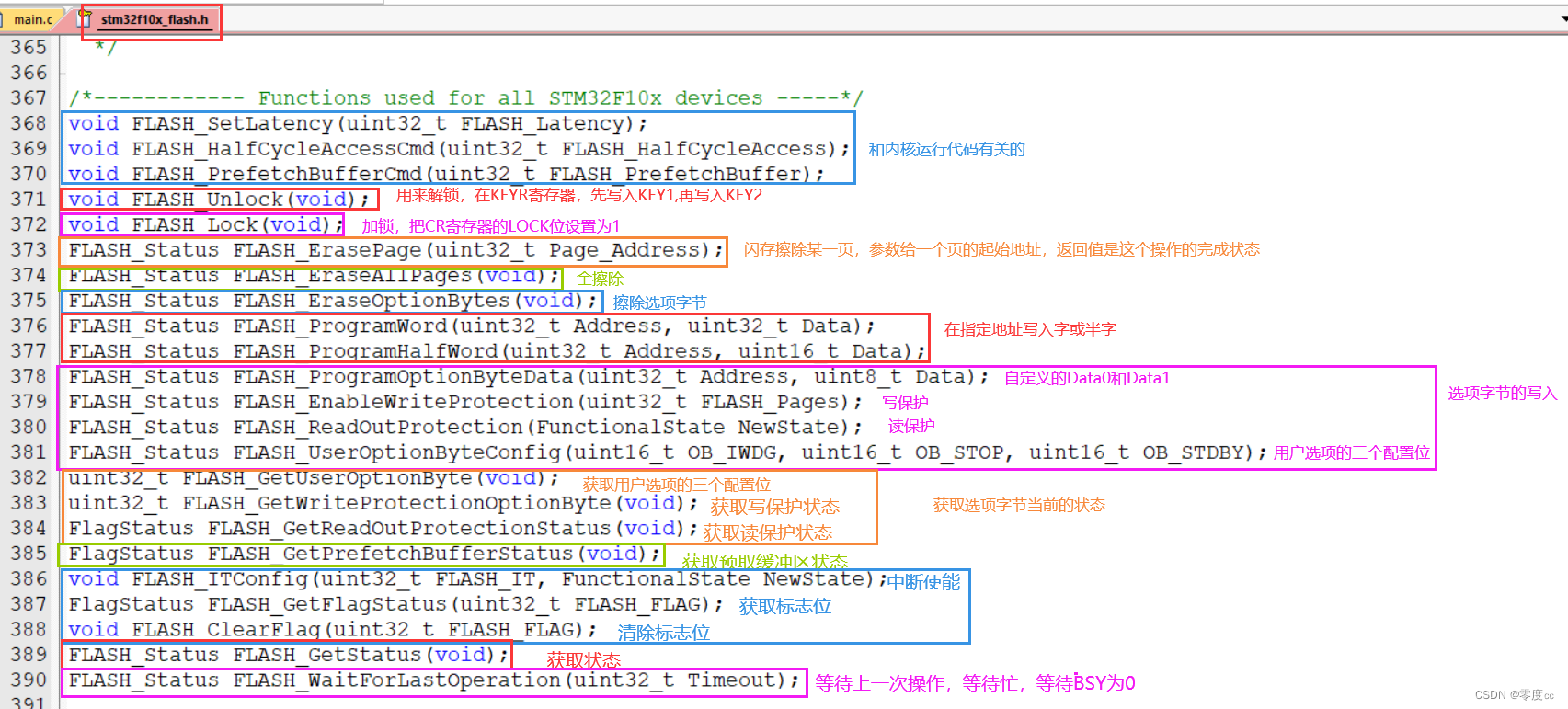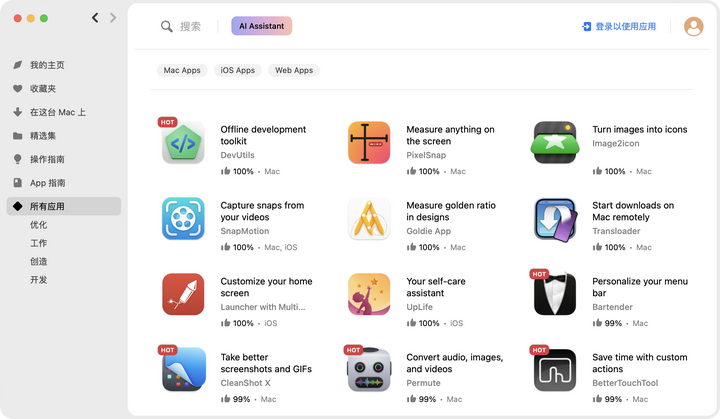二、SpringFramework实战指南
目录
- 一、技术体系结构
- 1.1 总体技术体系
- 1.2 框架概念和理解
- 二、SpringFramework介绍
- 2.1 Spring 和 SpringFramework概念
- 2.2 SpringFramework主要功能模块
- 2.3 SpringFramework 主要优势
- 三、Spring IoC容器和核心概念
- 3.1 组件和组件管理概念
- 3.2 Spring IoC容器和容器实现
- 3.3 Spring IoC / DI概念总结
- 四、Spring IoC实践和应用
- 4.1 Spring IoC / DI 实现步骤
- 4.2 基于XML配置方式组件管理
- 4.2.1 实验一: 组件(Bean)信息声明配置(IoC)
- 4.2.2 实验二: 组件(Bean)依赖注入配置(DI)
- 4.2.3 实验三: IoC容器创建和使用
- 4.2.4 实验四: 高级特性:组件(Bean)作用域和周期方法配置
- 4.2.5 实验五: 高级特性:FactoryBean特性和使用
- 4.2.6 实验六: 基于XML方式整合三层架构组件
- 4.3 基于 注解 方式管理 Bean
- 4.3.1 实验一: Bean注解标记和扫描 (IoC)
- 4.3.2 实验二: 组件(Bean)作用域和周期方法注解
- 4.3.3 实验三: Bean属性赋值:引用类型自动装配 (DI)
- 4.3.4 实验四: Bean属性赋值:基本类型属性赋值 (DI)
- 4.3.5 实验五: 基于注解+XML方式整合三层架构组件
- 4.4 基于 配置类 方式管理 Bean
- 4.4.1 完全注解开发理解
- 4.4.2 实验一:配置类和扫描注解
- 4.4.3 实验二:@Bean定义组件
- 4.4.4 实验三:高级特性:@Bean注解细节
- 4.4.5 实验四:高级特性:@Import扩展
- 4.4.6 实验五:基于注解+配置类方式整合三层架构组件
- 4.5 三种配置方式总结
- 4.5.1 XML方式配置总结
- 4.5.2 XML+注解方式配置总结
- 4.5.3 完全注解方式配置总结
- 4.6 整合Spring5-Test5搭建测试环境
- 五、Spring AOP面向切面编程
- 5.1 场景设定和问题复现
- 5.2 解决技术代理模式
- 5.3 面向切面编程思维(AOP)
- 5.4 Spring AOP框架介绍和关系梳理
- 5.5 Spring AOP基于注解方式实现和细节
- 5.5.1 Spring AOP底层技术组成
- 5.5.2 初步实现
- 5.5.3 获取通知细节信息
- 5.5.4 切点表达式语法
- 5.5.5 重用(提取)切点表达式
- 5.5.6 环绕通知
- 5.5.7 切面优先级设置
- 5.5.8 CGLib动态代理生效
- 5.5.9 注解实现小结
- 5.6 Spring AOP基于XML方式实现(了解)
- 5.7 Spring AOP对获取Bean的影响理解
- 5.7.1 根据类型装配 bean
- 5.7.2 使用总结
- 六、Spring 声明式事务
- 6.1 声明式事务概念
- 6.1.1 编程式事务
- 6.1.2 声明式事务
- 6.1.3 Spring事务管理器
- 6.2 基于注解的声明式事务
- 6.2.1 准备工作
- 6.2.2 基本事务控制
- 6.2.3 事务属性:只读
- 6.2.4 事务属性:超时时间
- 6.2.5 事务属性:事务异常
- 6.2.6 事务属性:事务隔离级别
- 6.2.7 事务属性:事务传播行为
- 6.1 声明式事务概念
- 七、Spring核心掌握总结
一、技术体系结构
1.1 总体技术体系
-
单一架构
一个项目,一个工程,导出为一个war包,在一个Tomcat上运行。也叫all in one。
单一架构,项目主要应用技术框架为:Spring , SpringMVC , Mybatis
-
分布式架构
一个项目(对应 IDEA 中的一个 project),拆分成很多个模块,每个模块是一个 IDEA 中的一个 module。每一个工程都是运行在自己的 Tomcat 上。模块之间可以互相调用。每一个模块内部可以看成是一个单一架构的应用。

分布式架构,项目主要应用技术框架:SpringBoot (SSM), SpringCloud , 中间件等
1.2 框架概念和理解
框架( Framework )是一个集成了基本结构、规范、设计模式、编程语言和程序库等基础组件的软件系统,它可以用来构建更高级别的应用程序。框架的设计和实现旨在解决特定领域中的常见问题,帮助开发人员更高效、更稳定地实现软件开发目标。

框架的优点包括以下几点:
- 提高开发效率:框架提供了许多预先设计好了的组件和工具,能够帮助开发人员快速进行开发。相较于传统手写代码,在框架提供的规范化环境中,开发者可以更快地实现项目的各种要求。
- 降低开发成本:框架的提供标准化的编程语言、数据操作等代码片段,避免了重复开发的问题,降低了开发成本,提供深度优化的系统,降低了维护成本,增强了系统的可靠性。
- 提高应用程序的稳定性:框架通常经过了很长时间的开发和测试,其中的许多组件、代码片段和设计模式都得到了验证。重复利用这些组件有助于减少bug的出现,从而提高了应用程序的稳定性。
- 提供标准化的解决方案:框架通常是针对某个特定领域的,通过提供标准化的解决方案,可以为开发人员提供一种共同的语言和思想基础,有助于更好地沟通和协作。
框架的缺点包括以下几个方面:
- 学习成本高:框架通常具有特定的语言和编程范式。对于开发人员而言,需要花费时间学习其背后的架构、模式和逻辑,这对于新手而言可能会耗费较长时间。
- 可能存在局限性:虽然框架提高了开发效率并可以帮助开发人员解决常见问题,但是在某些情况下,特定的应用需求可能超出框架的范围,从而导致应用程序无法满足要求。开发人员可能需要更多的控制权和自由度,同时需要在框架和应用程序之间进行权衡取舍。
- 版本变更和兼容性问题:框架的版本发布和迭代通常会导致代码库的大规模变更,进而导致应用程序出现兼容性问题和漏洞。当框架变更时,需要考虑框架是否向下兼容,以及如何进行适当的测试、迁移和升级。
- 架构风险:框架涉及到很多抽象和概念,如果开发者没有足够的理解和掌握其架构,可能会导致系统出现设计和架构缺陷,从而影响系统的健康性和安全性。
站在文件结构的角度理解框架,可以将框架总结:框架 = jar包+配置文件
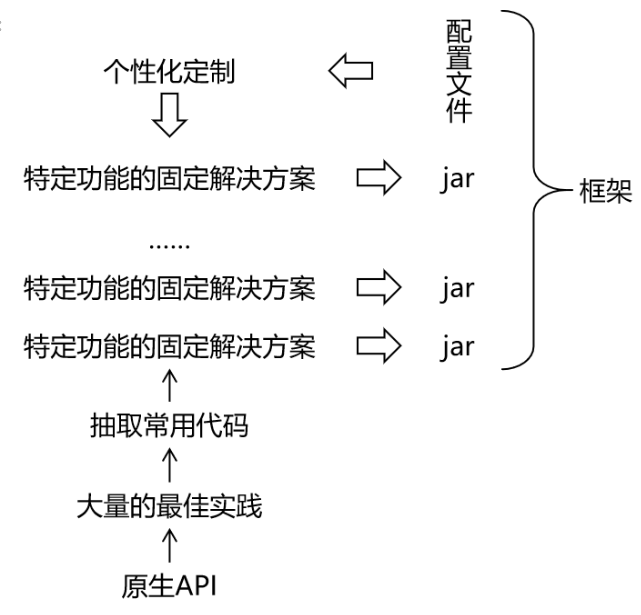
莎士比亚说,“一千个观众眼中有一千个哈姆雷特” 即仁者见仁,智者见智.说每个人都会对作品有不同的理解,每个人对待任何事物都有自己的看法,同样的技术解决同样的问题会产生不同流程和风格的解决方案,而采用一种框架其实就是限制用户必须使用其规定的方案来实现,可以降低程序员之间沟通以及日后维护的成本!
常用的单一架构JavaEE项目框架演进,从SSH、SSH2过渡到了SSM:SpringMVC、Spring、MyBatis。
总之,框架已经对基础的代码进行了封装并提供相应的API,开发者在使用框架是直接调用封装好的API可以省去很多代码编写,从而提高工作效率和开发速度。
二、SpringFramework介绍
2.1 Spring 和 SpringFramework概念
https://spring.io/projects
广义的 Spring:Spring 技术栈(全家桶)
广义上的 Spring 泛指以 Spring Framework 为基础的 Spring 技术栈。
经过十多年的发展,Spring 已经不再是一个单纯的应用框架,而是逐渐发展成为一个由多个不同子项目(模块)组成的成熟技术,例如 Spring Framework、Spring MVC、SpringBoot、Spring Cloud、Spring Data、Spring Security 等,其中 Spring Framework 是其他子项目的基础。
这些子项目涵盖了从企业级应用开发到云计算等各方面的内容,能够帮助开发人员解决软件发展过程中不断产生的各种实际问题,给开发人员带来了更好的开发体验。
狭义的 Spring:Spring Framework(基础框架)
狭义的 Spring 特指 Spring Framework,通常我们将它称为 Spring 框架。
Spring Framework(Spring框架)是一个开源的应用程序框架,由SpringSource公司开发,最初是为了解决企业级开发中各种常见问题而创建的。它提供了很多功能,例如:依赖注入(Dependency Injection)、面向切面编程(AOP)、声明式事务管理(TX)等。其主要目标是使企业级应用程序的开发变得更加简单和快速,并且Spring框架被广泛应用于Java企业开发领域。
Spring全家桶的其他框架都是以SpringFramework框架为基础!
对比理解:
QQ 和 腾讯
腾讯 = Spring
QQ = SpringFramework
2.2 SpringFramework主要功能模块
SpringFramework框架结构图:

| 功能模块 | 功能介绍 |
|---|---|
| Core Container | 核心容器,在 Spring 环境下使用任何功能都必须基于 IOC 容器。 |
| AOP&Aspects | 面向切面编程 |
| TX | 声明式事务管理。 |
| Spring MVC | 提供了面向Web应用程序的集成功能。 |
2.3 SpringFramework 主要优势
- 丰富的生态系统:Spring 生态系统非常丰富,支持许多模块和库,如 Spring Boot、Spring Security、Spring Cloud 等等,可以帮助开发人员快速构建高可靠性的企业应用程序。
- 模块化的设计:框架组件之间的松散耦合和模块化设计使得 Spring Framework 具有良好的可重用性、可扩展性和可维护性。开发人员可以轻松地选择自己需要的模块,根据自己的需求进行开发。
- 简化 Java 开发:Spring Framework 简化了 Java 开发,提供了各种工具和 API,可以降低开发复杂度和学习成本。同时,Spring Framework 支持各种应用场景,包括 Web 应用程序、RESTful API、消息传递、批处理等等。
- 不断创新和发展:Spring Framework 开发团队一直在不断创新和发展,保持与最新技术的接轨,为开发人员提供更加先进和优秀的工具和框架。
因此,这些优点使得 Spring Framework 成为了一个稳定、可靠、且创新的框架,为企业级 Java 开发提供了一站式的解决方案。
Spring 使创建 Java 企业应用程序变得容易。它提供了在企业环境中采用 Java 语言所需的一切,支持 Groovy 和 Kotlin 作为 JVM 上的替代语言,并且可以根据应用程序的需求灵活地创建多种架构。从Spring Framework 6.0.6开始,Spring 需要 Java 17+。
三、Spring IoC容器和核心概念
3.1 组件和组件管理概念
-
3.1.1 什么是组件?
回顾常规的三层架构处理请求流程:
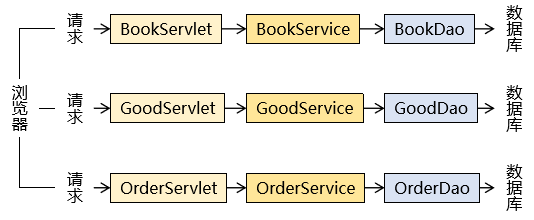
整个项目就是由各种组件搭建而成的:
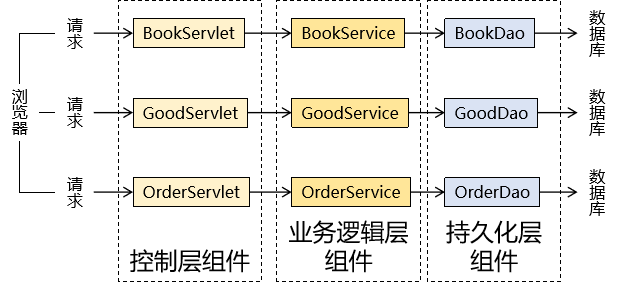
-
3.1.2 我们的期待
- 有人替我们创建组件的对象
- 有人帮我们保存组件的对象
- 有人帮助我们自动组装
- 有人替我们管理事务
- 有人协助我们整合其他框架
- …
-
3.1.3 Spring充当组件管理角色(IoC)
那么谁帮我们完成我们的期待,帮我们管理组件呢?
当然是Spring 框架了!
组件可以完全交给Spring 框架进行管理,Spring框架替代了程序员原有的new对象和对象属性赋值动作等!
Spring具体的组件管理动作包含:
- 组件对象实例化
- 组件属性属性赋值
- 组件对象之间引用
- 组件对象存活周期管理
- …
我们只需要编写元数据(配置文件)告知Spring 管理哪些类组件和他们的关系即可!
注意:组件是映射到应用程序中所有可重用组件的Java对象,应该是可复用的功能对象! - 组件一定是对象
- 对象不一定是组件
综上所述,Spring 充当一个组件容器,创建、管理、存储组件,减少了我们的编码压力,让我们更加专注进行业务编写!
-
3.1.4 组件交给Spring管理优势!
- 降低了组件之间的耦合性:Spring IoC容器通过依赖注入机制,将组件之间的依赖关系削弱,减少了程序组件之间的耦合性,使得组件更加松散地耦合。
- 提高了代码的可重用性和可维护性:将组件的实例化过程、依赖关系的管理等功能交给Spring IoC容器处理,使得组件代码更加模块化、可重用、更易于维护。
- 方便了配置和管理:Spring IoC容器通过XML文件或者注解,轻松的对组件进行配置和管理,使得组件的切换、替换等操作更加的方便和快捷。
- 交给Spring管理的对象(组件),方可享受Spring框架的其他功能(AOP,声明事务管理)等
3.2 Spring IoC容器和容器实现
-
3.2.1 普通和复杂容器
普通容器
生活中的普通容器
e’g :水杯
普通容器只能用来存储,没有更多功能。
程序中的普通容器- 数组
- 集合:List
- 集合:Set
复杂容器
生活中的复杂容器
eg:政府机构
政府管理我们的一生,生老病死都和政府有关。
程序中的复杂容器
Servlet 容器能够管理 Servlet(init,service,destroy)、Filter、Listener 这样的组件的一生,所以它是一个复杂容器。名称 时机 次数 创建对象 默认情况:接收到第一次请求 修改启动顺序后:Web应用启动过程中 一次 初始化操作 创建对象之后 一次 处理请求 接收到请求 多次 销毁操作 Web应用卸载之前 一次 我们即将要学习的 SpringIoC 容器也是一个复杂容器。它们不仅要负责创建组件的对象、存储组件的对象,还要负责调用组件的方法让它们工作,最终在特定情况下销毁组件。 总结:Spring管理组件的容器,就是一个复杂容器,不仅存储组件,也可以管理组件之间依赖关系,并且创建和销毁组件等! -
3.2.2 SpringIoC容器介绍
Spring IoC 容器,负责实例化、配置和组装 bean(组件)。容器通过读取配置元数据来获取有关要实例化、配置和组装组件的指令。配置元数据以 XML、Java 注解或 Java 代码形式表现。它允许表达组成应用程序的组件以及这些组件之间丰富的相互依赖关系。
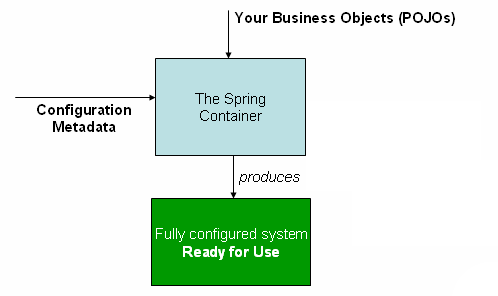
上图显示了 Spring 容器工作原理的高级视图。应用程序类与配置元数据相结合,您拥有完全配置且可执行的系统或应用程序。
-
3.2.3 SpringIoC容器具体接口和实现类
SpringIoc容器接口:
BeanFactory接口提供了一种高级配置机制,能够管理任何类型的对象,它是SpringIoC容器标准化超接口!ApplicationContext是BeanFactory的子接口。它扩展了以下功能:- 更容易与 Spring 的 AOP 功能集成
- 消息资源处理(用于国际化)
- 特定于应用程序给予此接口实现,例如Web 应用程序的
WebApplicationContext
简而言之,BeanFactory提供了配置框架和基本功能,而ApplicationContext添加了更多特定于企业的功能。ApplicationContext是BeanFactory的完整超集!
ApplicationContext容器实现类:

类型名 简介 ClassPathXmlApplicationContext 通过读取类路径下的 XML 格式的配置文件创建 IOC 容器对象 FileSystemXmlApplicationContext 通过文件系统路径读取 XML 格式的配置文件创建 IOC 容器对象 AnnotationConfigApplicationContext 通过读取Java配置类创建 IOC 容器对象 WebApplicationContext 专门为 Web 应用准备,基于 Web 环境创建 IOC 容器对象,并将对象引入存入 ServletContext 域中。 -
3.2.4 SpringIoC容器管理配置方式
Spring IoC 容器使用多种形式的配置元数据。此配置元数据表示您作为应用程序开发人员如何告诉 Spring 容器实例化、配置和组装应用程序中的对象。
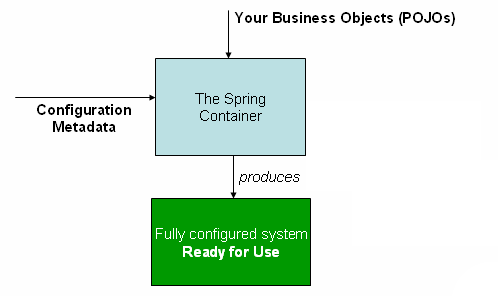
Spring框架提供了多种配置方式:XML配置方式、注解方式和Java配置类方式
- XML配置方式:是Spring框架最早的配置方式之一,通过在XML文件中定义Bean及其依赖关系、Bean的作用域等信息,让Spring IoC容器来管理Bean之间的依赖关系。该方式从Spring框架的第一版开始提供支持。
- 注解方式:从Spring 2.5版本开始提供支持,可以通过在Bean类上使用注解来代替XML配置文件中的配置信息。通过在Bean类上加上相应的注解(如@Component, @Service, @Autowired等),将Bean注册到Spring IoC容器中,这样Spring IoC容器就可以管理这些Bean之间的依赖关系。
- Java配置类方式:从Spring 3.0版本开始提供支持,通过Java类来定义Bean、Bean之间的依赖关系和配置信息,从而代替XML配置文件的方式。Java配置类是一种使用Java编写配置信息的方式,通过@Configuration、@Bean等注解来实现Bean和依赖关系的配置。
为了迎合当下开发环境,我们将以配置类+注解方式为主进行讲解!
3.3 Spring IoC / DI概念总结
-
IoC容器
Spring IoC 容器,负责实例化、配置和组装 bean(组件)核心容器。容器通过读取配置元数据来获取有关要实例化、配置和组装组件的指令。
-
IoC(Inversion of Control)控制反转
IoC 主要是针对对象的创建和调用控制而言的,也就是说,当应用程序需要使用一个对象时,不再是应用程序直接创建该对象,而是由 IoC 容器来创建和管理,即控制权由应用程序转移到 IoC 容器中,也就是“反转”了控制权。这种方式基本上是通过依赖查找的方式来实现的,即 IoC 容器维护着构成应用程序的对象,并负责创建这些对象。
-
DI (Dependency Injection) 依赖注入
DI 是指在组件之间传递依赖关系的过程中,将依赖关系在容器内部进行处理,这样就不必在应用程序代码中硬编码对象之间的依赖关系,实现了对象之间的解耦合。在 Spring 中,DI 是通过 XML 配置文件或注解的方式实现的。它提供了三种形式的依赖注入:构造函数注入、Setter 方法注入和接口注入。
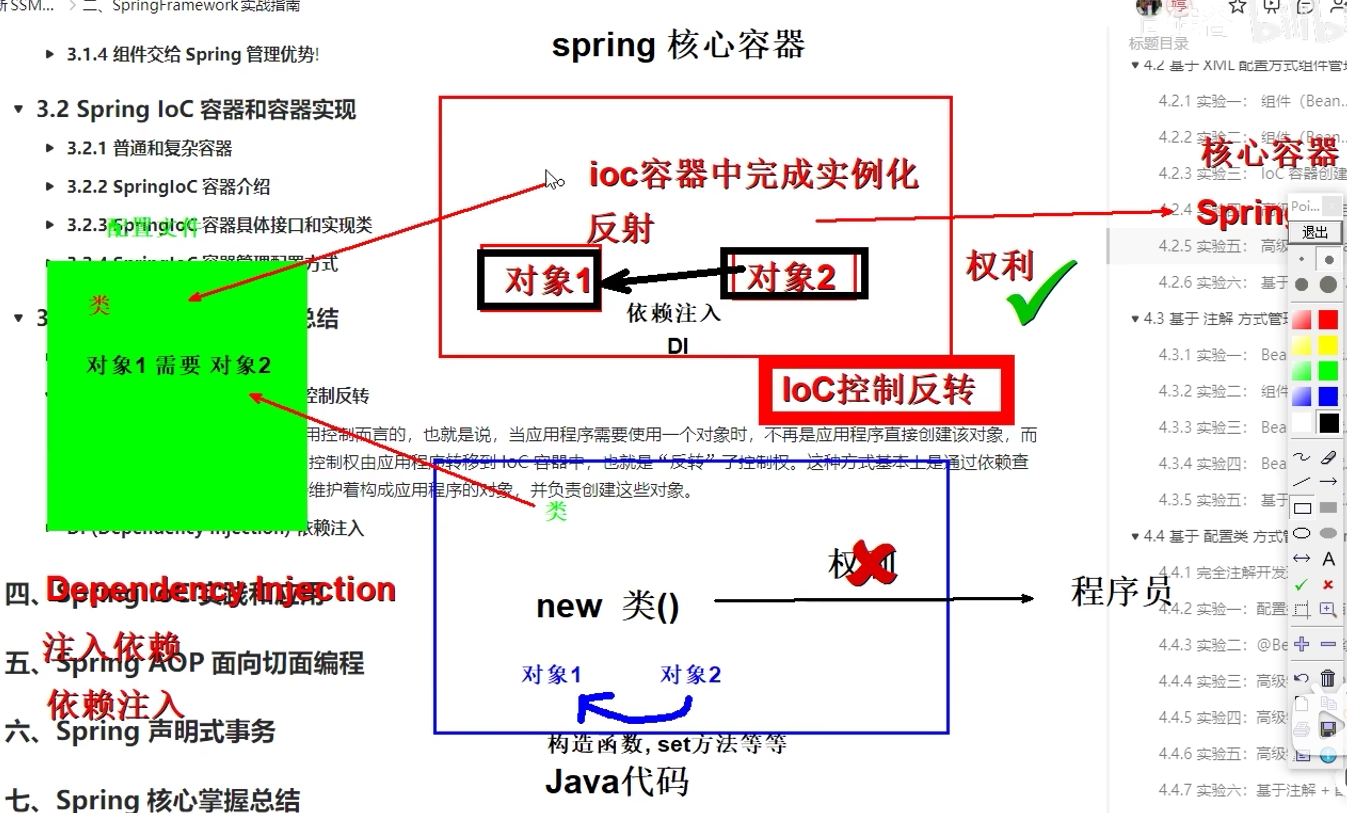
四、Spring IoC实践和应用
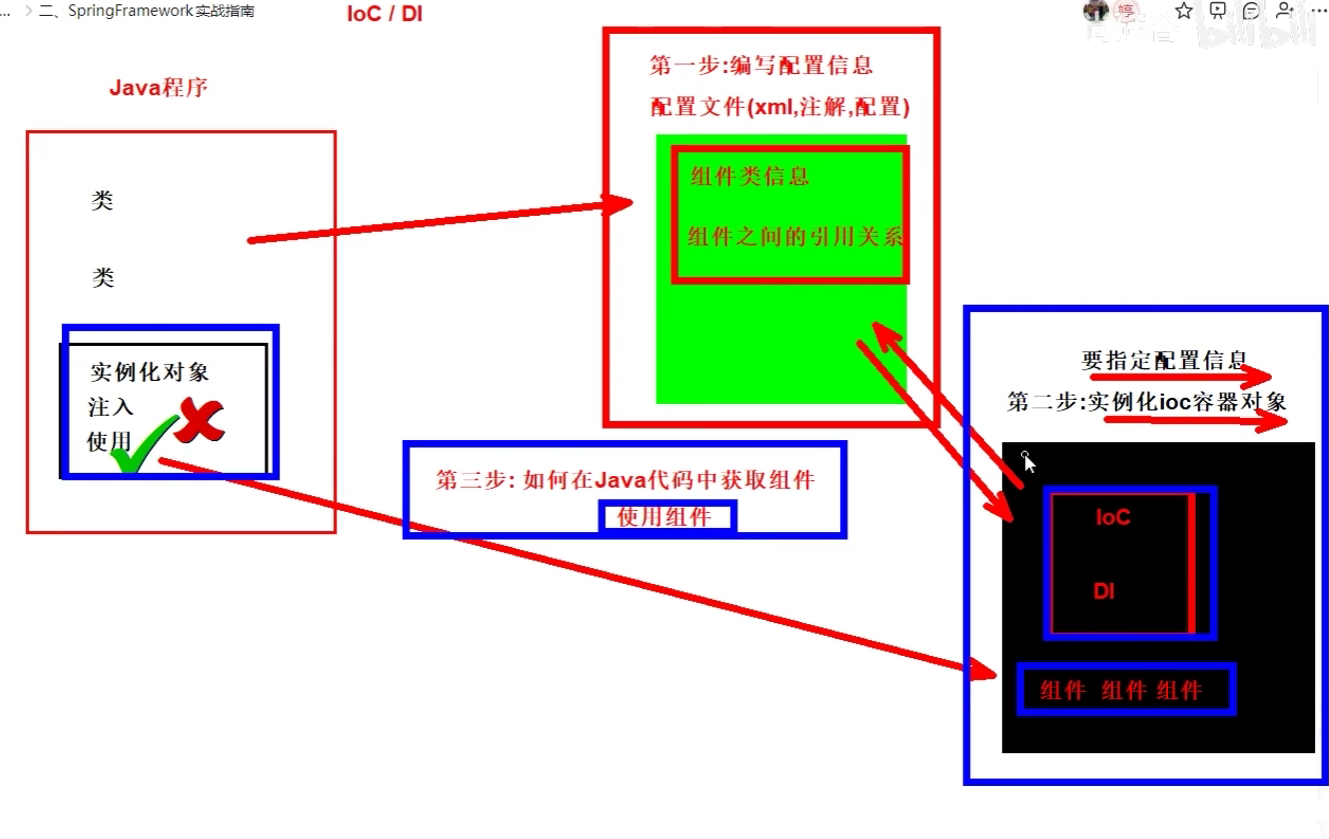
4.1 Spring IoC / DI 实现步骤
我们总结下,组件交给Spring IoC容器管理,并且获取和使用的基本步骤!
-
配置元数据(配置)
配置元数据,既是编写交给SpringIoC容器管理组件的信息,配置方式有三种。
基于 XML 的配置元数据的基本结构:
<bean id=“…” [1] class=“…” [2]>
<!-- collaborators and configuration for this bean go here -->
</bean><?xml version="1.0" encoding="UTF-8"?> <!-- 此处要添加一些约束,配置文件的标签并不是随意命名 --> <beans xmlns="http://www.springframework.org/schema/beans" xmlns:xsi="http://www.w3.org/2001/XMLSchema-instance" xsi:schemaLocation="http://www.springframework.org/schema/beans https://www.springframework.org/schema/beans/spring-beans.xsd"> <bean id="..." [1] class="..." [2]> <!-- collaborators and configuration for this bean go here --> </bean> <bean id="..." class="..."> <!-- collaborators and configuration for this bean go here --> </bean> <!-- more bean definitions go here --> </beans>Spring IoC 容器管理一个或多个组件。这些 组件是使用你提供给容器的配置元数据(例如,以 XML
<bean/>定义的形式)创建的。<bean /> 标签 == 组件信息声明
id属性是标识单个 Bean 定义的字符串。class属性定义 Bean 的类型并使用完全限定的类名。
-
实例化IoC容器
提供给
ApplicationContext构造函数的位置路径是资源字符串地址,允许容器从各种外部资源(如本地文件系统、JavaCLASSPATH等)加载配置元数据。我们应该选择一个合适的容器实现类,进行IoC容器的实例化工作:
//实例化ioc容器,读取外部配置文件,最终会在容器内进行ioc和di动作 ApplicationContext context = new ClassPathXmlApplicationContext("services.xml", "daos.xml"); -
获取Bean(组件)
ApplicationContext是一个高级工厂的接口,能够维护不同 bean 及其依赖项的注册表。通过使用方法T getBean(String name, Class<T> requiredType),您可以检索 bean 的实例。允许读取 Bean 定义并访问它们,如以下示例所示:
//创建ioc容器对象,指定配置文件,ioc也开始实例组件对象 ApplicationContext context = new ClassPathXmlApplicationContext("services.xml", "daos.xml"); //获取ioc容器的组件对象 PetStoreService service = context.getBean("petStore", PetStoreService.class); //使用组件对象 List<String> userList = service.getUsernameList();
4.2 基于XML配置方式组件管理
4.2.1 实验一: 组件(Bean)信息声明配置(IoC)
-
目标
Spring IoC 容器管理一个或多个 bean(也即是组件)。这些 Bean 是使用您提供给容器的配置元数据创建的(例如,以 XML
<bean/>定义的形式)。我们学习,如何通过定义XML配置文件,声明组件类信息,交给 Spring 的 IoC 容器进行组件管理!
-
思路
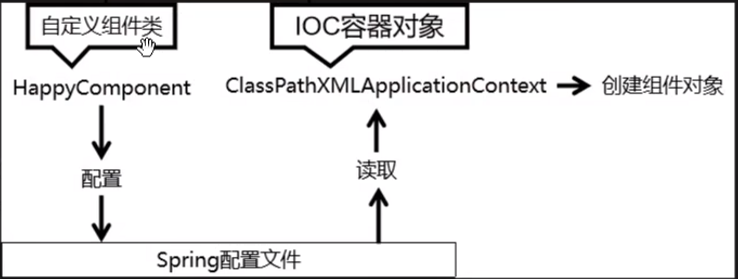
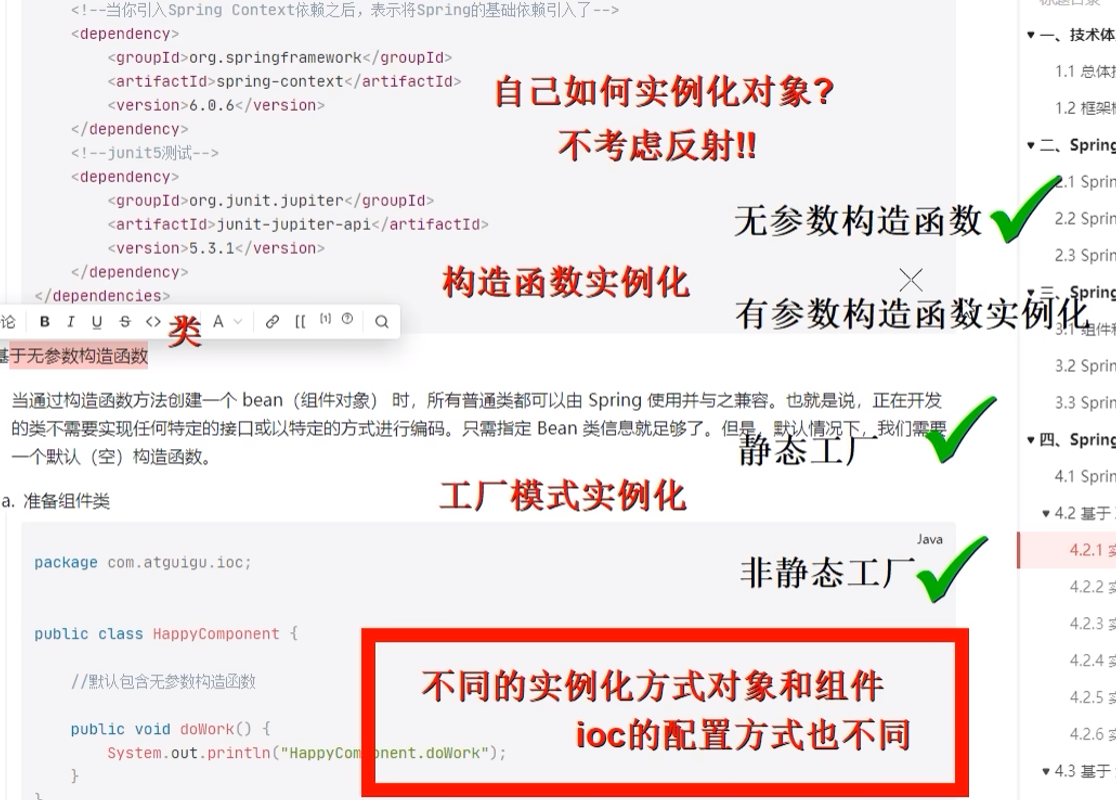
-
准备项目
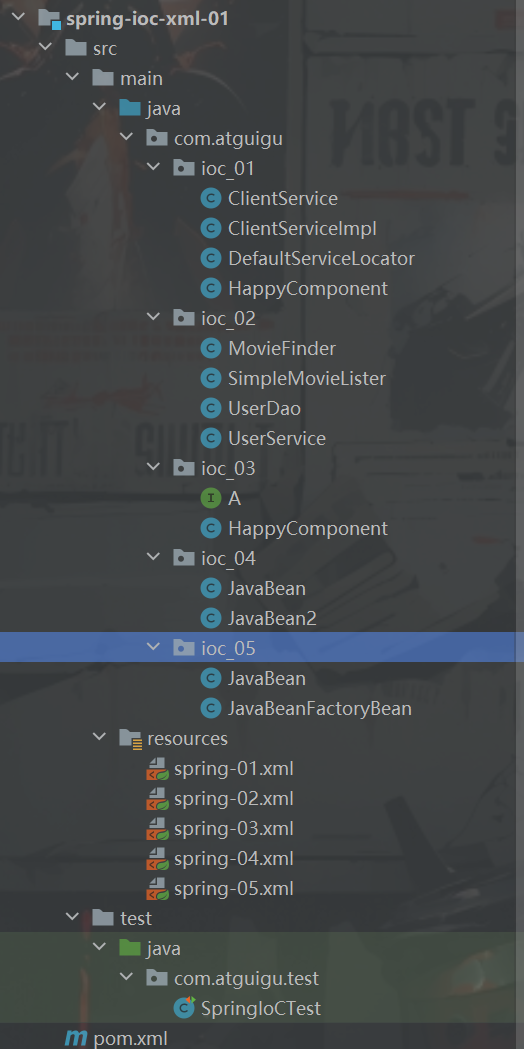
-
创建maven工程(spring-ioc-xml-01)
-
导入SpringIoC相关依赖
pom.xml
<dependencies> <!--spring context依赖--> <!--当你引入Spring Context依赖之后,表示将Spring的基础依赖引入了--> <dependency> <groupId>org.springframework</groupId> <artifactId>spring-context</artifactId> <version>6.0.6</version> </dependency> <!--junit5测试--> <dependency> <groupId>org.junit.jupiter</groupId> <artifactId>junit-jupiter-api</artifactId> <version>5.3.1</version> </dependency> </dependencies>
-
-
基于无参数构造函数
当通过构造函数方法创建一个 bean(组件对象) 时,所有普通类都可以由 Spring 使用并与之兼容。也就是说,正在开发的类不需要实现任何特定的接口或以特定的方式进行编码。只需指定 Bean 类信息就足够了。但是,默认情况下,我们需要一个默认(空)构造函数。
下面:
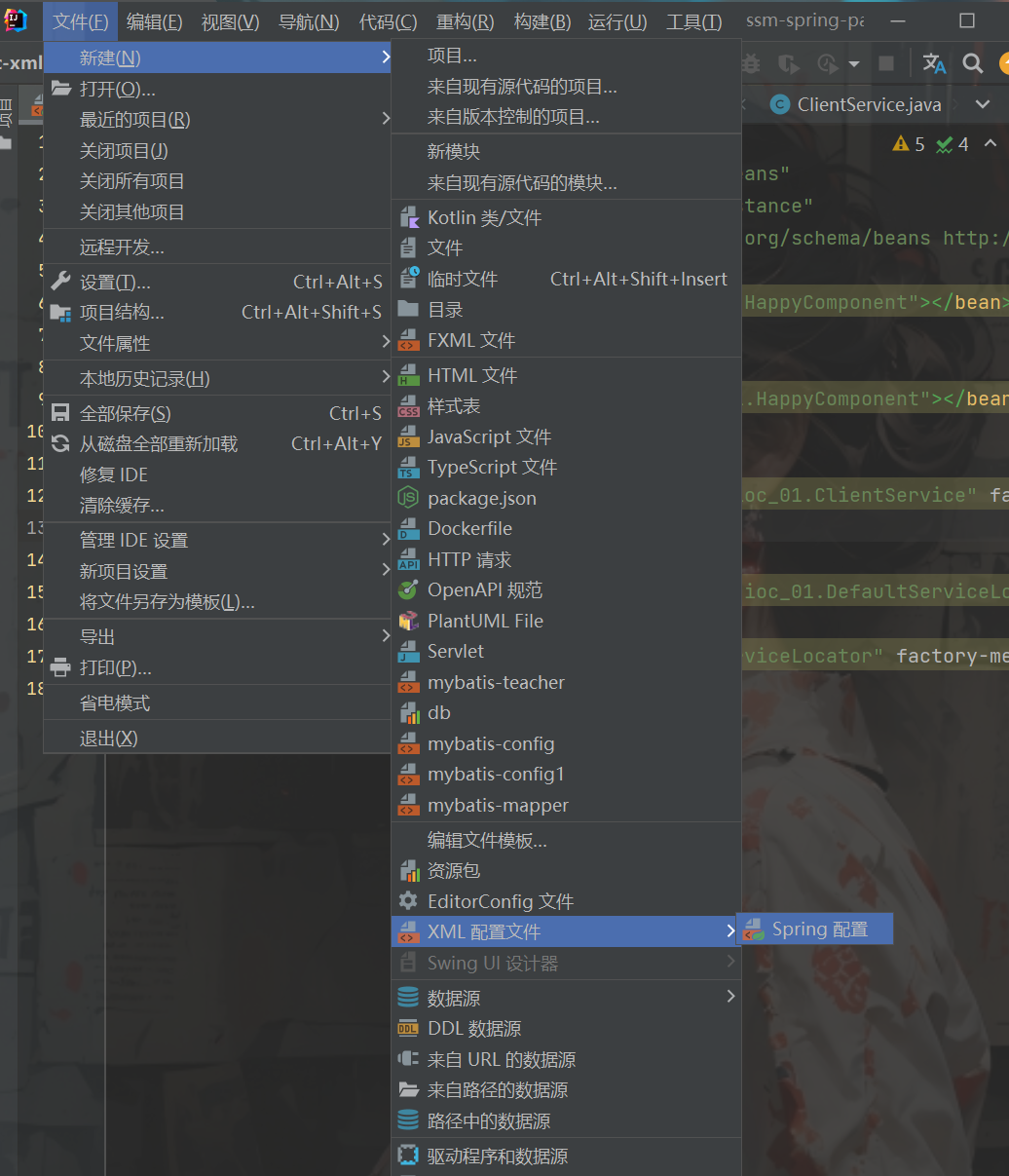
- 准备组件类
package com.atguigu.ioc; public class HappyComponent { //默认包含无参数构造函数 public void doWork() { System.out.println("HappyComponent.doWork"); } } ``` 2. xml配置文件编写 创建携带spring约束的xml配置文件 编写配置文件: 对应上面的那个图片 文件:resources/spring-bean-01.xml ```java <!-- 实验一 [重要]创建bean --> <bean id="happyComponent" class="com.atguigu.ioc.HappyComponent"/> ``` - bean标签:通过配置bean标签告诉IOC容器需要创建对象的组件信息 - id属性:bean的唯一标识,方便后期获取Bean! - class属性:组件类的全限定符! - 注意:要求当前组件类必须包含无参数构造函数! -
基于静态工厂方法实例化
除了使用构造函数实例化对象,还有一类是通过工厂模式实例化对象。接下来我们讲解如何定义使用静态工厂方法创建Bean的配置 !
-
准备组件类
public class ClientService { private static ClientService clientService = new ClientService(); private ClientService() {} public static ClientService createInstance() { return clientService; } } -
xml配置文件编写
文件:resources/spring-bean-01.xml
<bean id="clientService" class="examples.ClientService" factory-method="createInstance"/>- class属性:指定工厂类的全限定符!
- factory-method: 指定静态工厂方法,注意,该方法必须是static方法。
-
-
基于实例工厂方法实例化
接下来我们讲解下如何定义使用实例工厂方法创建Bean的配置 !
-
准备组建类
public class DefaultServiceLocator { private static ClientServiceImplclientService = new ClientServiceImpl(); public ClientService createClientServiceInstance() { return clientService; } } -
xml配置文件编写
文件:resources/spring-bean-01.xml
<!-- 将工厂类进行ioc配置 --> <bean id="serviceLocator" class="examples.DefaultServiceLocator"> </bean> <!-- 根据工厂对象的实例工厂方法进行实例化组件对象 --> <bean id="clientService" factory-bean="serviceLocator" factory-method="createClientServiceInstance"/>- factory-bean属性:指定当前容器中工厂Bean 的名称。
- factory-method: 指定实例工厂方法名。注意,实例方法必须是非static的!
-
-
图解IoC配置流程
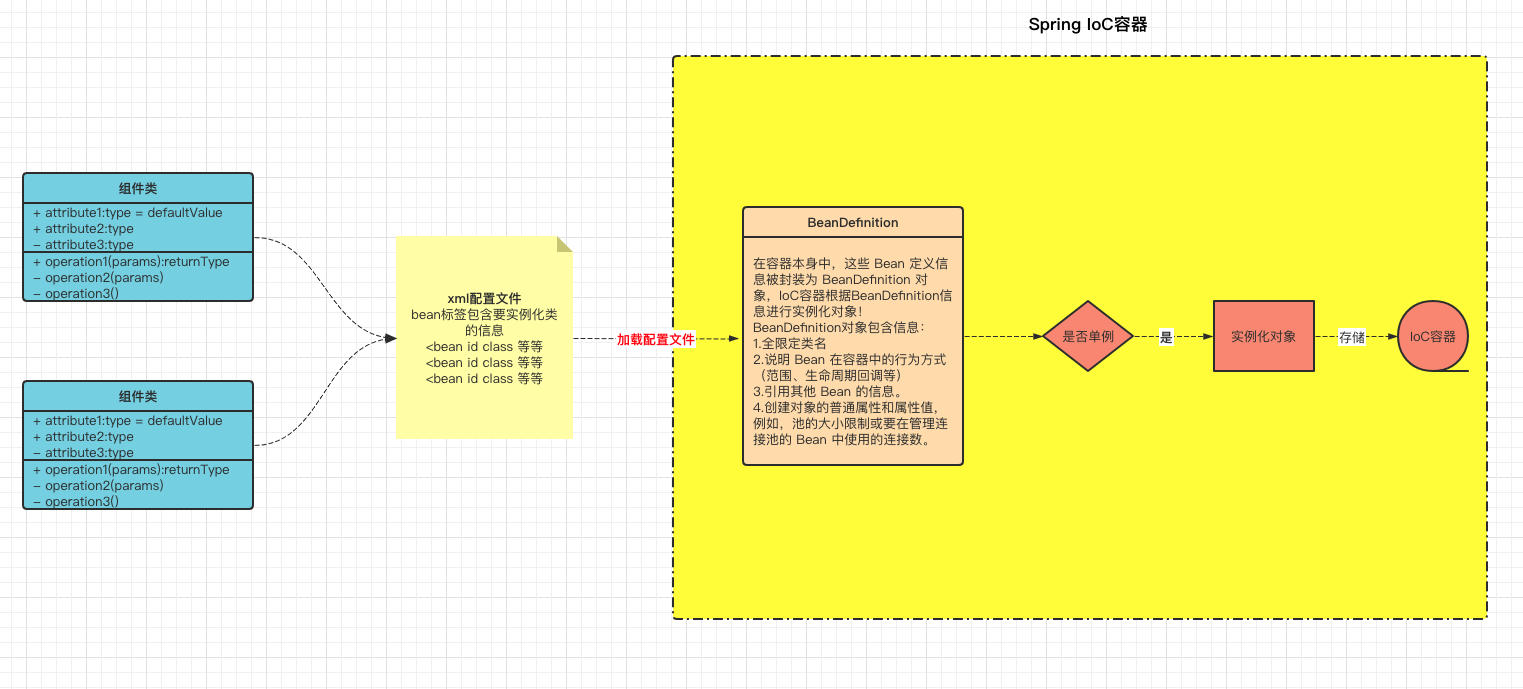
知识点汇总
<?xml version="1.0" encoding="UTF-8"?>
<beans xmlns="http://www.springframework.org/schema/beans"
xmlns:xsi="http://www.w3.org/2001/XMLSchema-instance" xmlns:p="http://www.springframework.org/schema/p"
xsi:schemaLocation="http://www.springframework.org/schema/beans http://www.springframework.org/schema/beans/spring-beans.xsd">
<!-- 1.可以使用无参数构造函数实例化的组件,如何进行ioc配置呢
<bean - 一个组件信息 - 一个组件对象
id 组件的标识 唯一 方便后期读取
class 组件的类的权限定符
将一个组件类 - 声明两个组件信息 - [默认是单例模式] - 会实例化两个组件对象
new
new
-->
<bean id="happyComponent1" class="com.atguigu.ioc_01.HappyComponent" />
<bean id="happyComponent2" class="com.atguigu.ioc_01.HappyComponent" />
<!-- 2. 静态工厂类如何声明工厂方法进行ioc的配置
<bean
id = "组件的标识"
class = "工厂类的全限定符"
factory-method = "静态工厂方法"
-->
<bean id="clientService" class="com.atguigu.ioc_01.ClientService" factory-method="createInstance" />
<!-- 3. 非静态工厂如何声明ioc配置-->
<!--3.1 配置工厂类的组件信息 -->
<bean id="defaultServiceLocator" class="com.atguigu.ioc_01.DefaultServiceLocator" />
<!--3.2 通过指定非静态工厂对象和方法名 来配置生成的ioc信息 -->
<bean id="clientService2" factory-bean="defaultServiceLocator" factory-method="createClientServiceInstance" />
</beans>
4.2.2 实验二: 组件(Bean)依赖注入配置(DI)
-
目标
通过配置文件,实现IoC容器中Bean之间的引用(依赖注入DI配置)。
主要涉及注入场景:基于构造函数的依赖注入和基于 Setter 的依赖注入。
-
思路
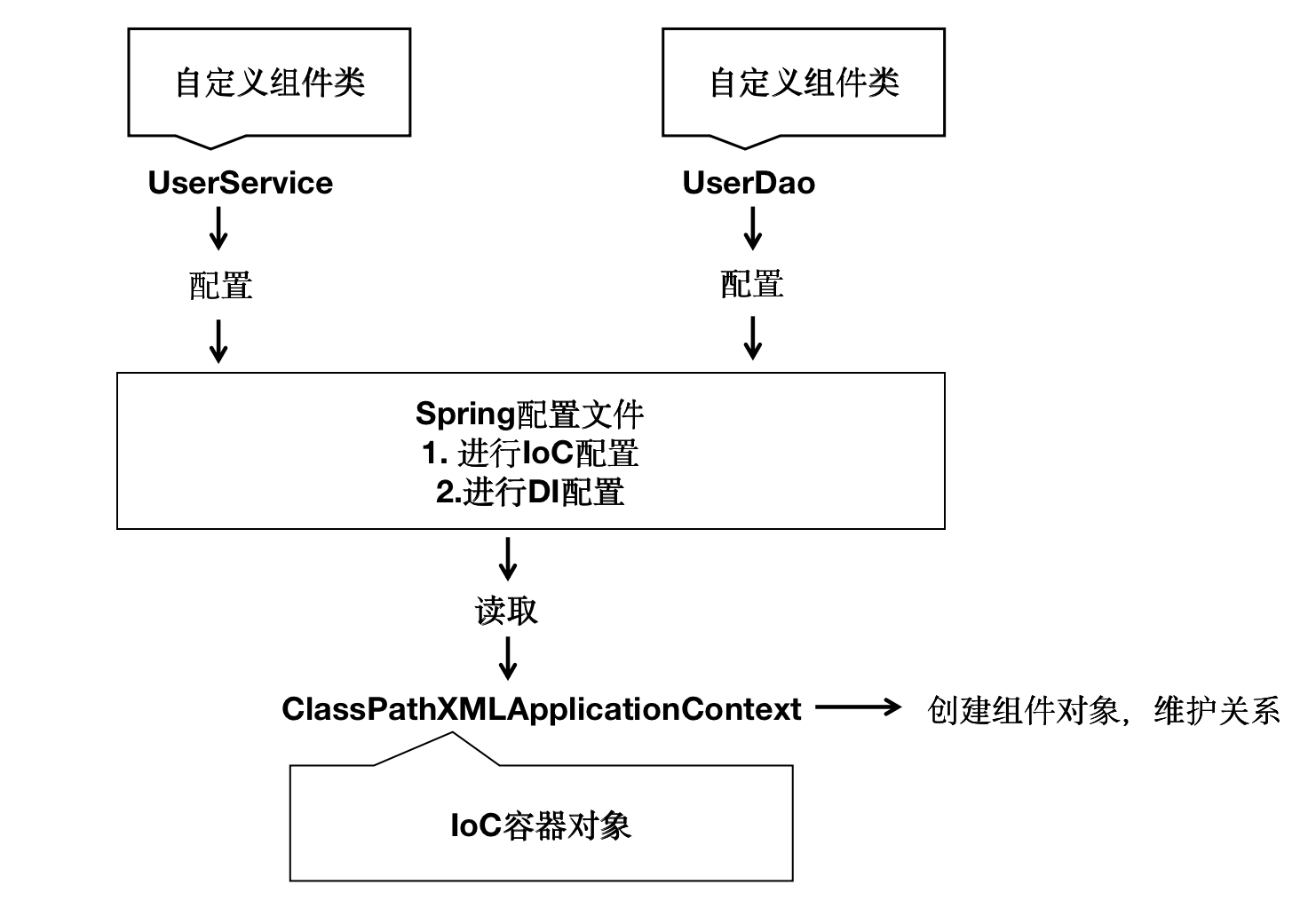
-
基于构造函数的依赖注入(单个构造参数)
-
介绍
基于构造函数的 DI 是通过容器调用具有多个参数的构造函数来完成的,每个参数表示一个依赖项。
下面的示例演示一个只能通过构造函数注入进行依赖项注入的类!
-
准备组件类
public class UserDao { } public class UserService { private UserDao userDao; public UserService(UserDao userDao) { this.userDao = userDao; } } -
编写配置文件
文件:resources/spring-02.xml
<beans> <!-- 引用类bean声明 --> <bean id="userService" class="x.y.UserService"> <!-- 构造函数引用 --> <constructor-arg ref="userDao"/> </bean> <!-- 被引用类bean声明 --> <bean id="userDao" class="x.y.UserDao"/> </beans>- constructor-arg标签:可以引用构造参数 ref引用其他bean的标识。
-
-
基于构造函数的依赖注入(多构造参数解析)
-
介绍
基于构造函数的 DI 是通过容器调用具有多个参数的构造函数来完成的,每个参数表示一个依赖项。
下面的示例演示通过构造函数注入多个参数,参数包含其他bean和基本数据类型!
-
准备组件类
public class UserDao { } public class UserService { private UserDao userDao; private int age; private String name; public UserService(int age , String name ,UserDao userDao) { this.userDao = userDao; this.age = age; this.name = name; } } -
编写配置文件
<!-- 场景1: 多参数,可以按照相应构造函数的顺序注入数据 --> <beans> <bean id="userService" class="x.y.UserService"> <!-- value直接注入基本类型值 --> <constructor-arg value="18"/> <constructor-arg value="赵伟风"/> <constructor-arg ref="userDao"/> </bean> <!-- 被引用类bean声明 --> <bean id="userDao" class="x.y.UserDao"/> </beans> <!-- 场景2: 多参数,可以按照相应构造函数的名称注入数据 --> <beans> <bean id="userService" class="x.y.UserService"> <!-- value直接注入基本类型值 --> <constructor-arg name="name" value="赵伟风"/> <constructor-arg name="userDao" ref="userDao"/> <constructor-arg name="age" value="18"/> </bean> <!-- 被引用类bean声明 --> <bean id="userDao" class="x.y.UserDao"/> </beans> <!-- 场景2: 多参数,可以按照相应构造函数的角标注入数据 index从0开始 构造函数(0,1,2....) --> <beans> <bean id="userService" class="x.y.UserService"> <!-- value直接注入基本类型值 --> <constructor-arg index="1" value="赵伟风"/> <constructor-arg index="2" ref="userDao"/> <constructor-arg index="0" value="18"/> </bean> <!-- 被引用类bean声明 --> <bean id="userDao" class="x.y.UserDao"/> </beans>- constructor-arg标签:指定构造参数和对应的值
- constructor-arg标签:name属性指定参数名、index属性指定参数角标、value属性指定普通属性值
-
-
基于Setter方法依赖注入
-
介绍
开发中,除了构造函数注入(DI)更多的使用的Setter方法进行注入!
下面的示例演示一个只能使用纯 setter 注入进行依赖项注入的类。
-
准备组件类
public Class MovieFinder{ } public class SimpleMovieLister { private MovieFinder movieFinder; private String movieName; public void setMovieFinder(MovieFinder movieFinder) { this.movieFinder = movieFinder; } public void setMovieName(String movieName){ this.movieName = movieName; } // business logic that actually uses the injected MovieFinder is omitted... } -
编写配置文件
<bean id="simpleMovieLister" class="examples.SimpleMovieLister"> <!-- setter方法,注入movieFinder对象的标识id name = 属性名 ref = 引用bean的id值 --> <property name="movieFinder" ref="movieFinder" /> <!-- setter方法,注入基本数据类型movieName name = 属性名 value= 基本类型值 --> <property name="movieName" value="消失的她"/> </bean> <bean id="movieFinder" class="examples.MovieFinder"/>- property标签: 可以给setter方法对应的属性赋值
- property 标签: name属性代表set方法标识、ref代表引用bean的标识id、value属性代表基本属性值
-
总结:
依赖注入(DI)包含引用类型和基本数据类型,同时注入的方式也有多种!主流的注入方式为setter方法注入和构造函数注入,两种注入语法都需要掌握!
需要特别注意:引用其他bean,使用ref属性。直接注入基本类型值,使用value属性。
回顾汇总

<?xml version="1.0" encoding="UTF-8"?>
<beans xmlns="http://www.springframework.org/schema/beans"
xmlns:xsi="http://www.w3.org/2001/XMLSchema-instance"
xsi:schemaLocation="http://www.springframework.org/schema/beans http://www.springframework.org/schema/beans/spring-beans.xsd">
<!-- 引用和被引用的组件 必须全部在ioc容器! 不能乡愁!!-->
<!-- 1. 单个构造参数注入 -->
<!--
springioc容器是一个高级容器,内部会有缓存动作! 1. 先创建对象[ioc] 2.再进行属性赋值 [di]
所以先后顺序无所谓但不知道为撒,我用jdk8要有一定的顺序
-->
<bean id="userService" class="com.atguigu.ioc_02.UserService" >
<!--构造参数传值 di的配置
<constructor-arg 构造参数传值的 di配置
value = 直接属性值 String name ="二狗子" int age = "18"
ref = 引用其他的bean beanId值
-->
<constructor-arg ref="userDao"/>
</bean>
<!-- 步骤1: 将他们都存放在ioc容器 [ioc]-->
<bean id="userDao" class="com.atguigu.ioc_02.UserDao" />
<!-- 2.多个构造参数注入 -->
<bean id="userService1" class="com.atguigu.ioc_02.UserService">
<!-- 方案1: 构造参数的顺序填写值 value 直接赋值 ref 引用其他的beanid
不推荐-->
<constructor-arg value="18"/>
<constructor-arg value="二狗子"/>
<constructor-arg ref="userDao"/>
</bean>
<bean id="userService2" class="com.atguigu.ioc_02.UserService">
<!-- 方案2: 构造参数的名称填写,不用考虑顺序 name = 构造参数的名字 [推荐]-->
<constructor-arg name="name" value="二狗子"/>
<constructor-arg name="age" value="18"/>
<constructor-arg name="userDao" ref="userDao"/>
</bean>
<bean id="userService2" class="com.atguigu.ioc_02.UserService">
<!-- 方案3: 构造参数的参数的下角标指定填写,不用考虑顺序 index = 构造参数的下角标 从左到右 从0开始
age = 0 name = 1 userDao = 2
了解-->
<constructor-arg index="1" value="二狗子"/>
<constructor-arg index="0" value="18"/>
<constructor-arg index="2" ref="userDao"/>
</bean>
<!-- 3. 触发setter方法进行注入 -->
<bean id="movieFinder" class="com.atguigu.ioc_02.MovieFinder" />
<bean id="simpleMovieLister" class="com.atguigu.ioc_02.SimpleMovieLister">
<!--
name-> 属性名 setter方法的 去set和首字母小写的值! 调用set方法的名
setMovieFinder -> movieFinder
value | ref 二选一 value="直接属性值" ref ="其他bean的Id"
-->
<property name="movieName" value="消失的她" />
<property name="movieFinder" ref="movieFinder" />
</bean>
</beans>
<?xml version="1.0" encoding="UTF-8"?>
<beans xmlns="http://www.springframework.org/schema/beans"
xmlns:xsi="http://www.w3.org/2001/XMLSchema-instance"
xmlns:context="http://www.springframework.org/schema/context"
xsi:schemaLocation="http://www.springframework.org/schema/beans http://www.springframework.org/schema/beans/spring-beans.xsd http://www.springframework.org/schema/context https://www.springframework.org/schema/context/spring-context.xsd">
<context:property-placeholder location="classpath:jdbc.properties" />
<!-- druid -->
<bean id="dataSource" class="com.alibaba.druid.pool.DruidDataSource">
<property name="url" value="${atguigu.url}" />
<property name="driverClassName" value="${atguigu.driver}" />
<property name="username" value="${atguigu.username}" />
<property name="password" value="${atguigu.password}" />
</bean>
<!-- jdbcTemplate-->
<bean id="jdbcTemplate" class="org.springframework.jdbc.core.JdbcTemplate">
<property name="dataSource" ref="dataSource" />
</bean>
<!-- dao 配置 di jdbcTemplate-->
<bean id="studentDao" class="com.atguigu.dao.impl.StudentDaoImpl">
<property name="jdbcTemplate" ref="jdbcTemplate" />
</bean>
<!-- service 配置 di dao-->
<bean id="studentService" class="com.atguigu.service.impl.StudentServiceImpl">
<property name="studentDao" ref="studentDao" />
</bean>
<!-- controller 配置 di service-->
<bean id="studentController" class="com.atguigu.controller.StudentController">
<property name="studentService" ref="studentService" />
</bean>
</beans>
4.2.3 实验三: IoC容器创建和使用
-
介绍
上面的实验只是讲解了如何在XML格式的配置文件编写IoC和DI配置!
如图:
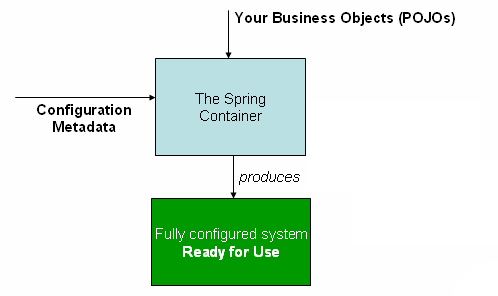
想要配置文件中声明组件类信息真正的进行实例化成Bean对象和形成Bean之间的引用关系,我们需要声明IoC容器对象,读取配置文件,实例化组件和关系维护的过程都是在IoC容器中实现的!
-
容器实例化
//方式1:实例化并且指定配置文件 //参数:String...locations 传入一个或者多个配置文件 ApplicationContext context = new ClassPathXmlApplicationContext("services.xml", "daos.xml"); //方式2:先实例化,再指定配置文件,最后刷新容器触发Bean实例化动作 [springmvc源码和contextLoadListener源码方式] ApplicationContext context = new ClassPathXmlApplicationContext(); //设置配置配置文件,方法参数为可变参数,可以设置一个或者多个配置 iocContainer1.setConfigLocations("services.xml", "daos.xml"); //后配置的文件,需要调用refresh方法,触发刷新配置 iocContainer1.refresh(); -
Bean对象读取
//方式1: 根据id获取 //没有指定类型,返回为Object,需要类型转化! HappyComponent happyComponent = (HappyComponent) iocContainer.getBean("bean的id标识"); //使用组件对象 happyComponent.doWork(); //方式2: 根据类型获取 //根据类型获取,但是要求,同类型(当前类,或者之类,或者接口的实现类)只能有一个对象交给IoC容器管理 //配置两个或者以上出现: org.springframework.beans.factory.NoUniqueBeanDefinitionException 问题 HappyComponent happyComponent = iocContainer.getBean(HappyComponent.class); happyComponent.doWork(); //方式3: 根据id和类型获取 HappyComponent happyComponent = iocContainer.getBean("bean的id标识", HappyComponent.class); happyComponent.doWork(); 根据类型来获取bean时,在满足bean唯一性的前提下,其实只是看:『对象 instanceof 指定的类型』的返回结果, 只要返回的是true就可以认定为和类型匹配,能够获取到。
汇总回顾
<?xml version="1.0" encoding="UTF-8"?>
<beans xmlns="http://www.springframework.org/schema/beans"
xmlns:xsi="http://www.w3.org/2001/XMLSchema-instance"
xsi:schemaLocation="http://www.springframework.org/schema/beans http://www.springframework.org/schema/beans/spring-beans.xsd">
<!--组件的信息 ioc的配置 -> applicationContext读取了 -> 实例化对象
ioc的配置一定是实现类! 真正要进行实例化!
-->
<bean id="happyComponent" class="com.atguigu.ioc_03.HappyComponent" />
<!-- <bean id="happyComponent1" class="com.atguigu.ioc_03.HappyComponent" />-->
</beans>
package com.atguigu.test;
import com.atguigu.ioc_03.A;
import com.atguigu.ioc_03.HappyComponent;
import com.atguigu.ioc_04.JavaBean2;
import com.atguigu.ioc_05.JavaBean;
import org.junit.jupiter.api.Test;
import org.springframework.context.ApplicationContext;
import org.springframework.context.support.ClassPathXmlApplicationContext;
/**
* projectName: com.atguigu.test
*
* @author: 赵伟风
* description: ioc容器创建和读取组件的测试类
*/
public class SpringIoCTest {
/**
* 讲解如何创建ioc容器并且读取配置文件
*/
public void createIoC(){
//创建容器 选择合适的容器实现即可!
/**
* 接口
* BeanFactory
*
* ApplicationContext
*
* 实现类
* 可以直接通过构造函数实例化!
* ClassPathXmlApplicationContext 读取类路径下的xml配置方式 classes
* FileSystemXmlApplicationContext 读取指定文件位置的xml配置方式
* AnnotationConfigApplicationContext 读取配置类方式的ioc容器
* WebApplicationContext web项目专属的配置的ioc容器
*
*/
//方式1: 直接创建容器并且指定配置文件即可 [推荐]
// 构造函数(String...配置文件) 可以填写一个或者多个
// ioc di
ApplicationContext applicationContext = new ClassPathXmlApplicationContext("spring-03.xml");
//方式2: 先创建ioc容器对象,再指定配置文件,再刷新!
//源码的配置过程! 创建容器 [spring] 和 配置文件指定分开 [自己指定]
ClassPathXmlApplicationContext applicationContext1 = new ClassPathXmlApplicationContext();
applicationContext1.setConfigLocations("spring-03.xml"); //外部配置文件的设置
applicationContext1.refresh(); //调用ioc和di的流程
}
/**
* 讲解如何在IoC容器中获取组件Bean
*/
@Test
public void getBeanFromIoC(){
//1.创建ioc容器对象
ClassPathXmlApplicationContext applicationContext = new ClassPathXmlApplicationContext();
applicationContext.setConfigLocations("spring-03.xml");
applicationContext.refresh(); //ioc di的动作
//2.读取ioc容器的组件
//方案1: 直接根据beanId获取即可 返回值类型是Object 需要强转 [不推荐]
HappyComponent happyComponent = (HappyComponent) applicationContext.getBean("happyComponent");
//方案2: 根据beanId,同时指定bean的类型 Class
HappyComponent happyComponent1 = applicationContext.getBean("happyComponent", HappyComponent.class);
//方案3: 直接根据类型获取
//TODO: 根据bean的类型获取,同一个类型,在ioc容器中只能有一个bean!!!
//TODO: 如果ioc容器存在多个同类型的Bean 会出现: NoUniqueBeanDefinitionException
//TODO: ioc的配置一定是实现类,但是可以根据接口类型获取值! getBean(类型); instanceof ioc容器的类型 == true
A happyComponent2 = applicationContext.getBean(A.class);
happyComponent2.doWork();
System.out.println(happyComponent == happyComponent1);
System.out.println(happyComponent2 == happyComponent1);
}
4.2.4 实验四: 高级特性:组件(Bean)作用域和周期方法配置
- 组件周期方法配置
-
周期方法概念
我们可以在组件类中定义方法,然后当IoC容器实例化和销毁组件对象的时候进行调用!这两个方法我们成为生命周期方法!
类似于Servlet的init/destroy方法,我们可以在周期方法完成初始化和释放资源等工作。
-
周期方法声明
public class BeanOne { //周期方法要求: 方法命名随意,但是要求方法必须是 public void 无形参列表 public void init() { // 初始化逻辑 } } public class BeanTwo { public void cleanup() { // 释放资源逻辑 } } -
周期方法配置
<beans> <bean id="beanOne" class="examples.BeanOne" init-method="init" /> <bean id="beanTwo" class="examples.BeanTwo" destroy-method="cleanup" /> </beans>
-
- 组件作用域配置
-
Bean作用域概念
<bean标签声明Bean,只是将Bean的信息配置给SpringIoC容器!在IoC容器中,这些
<bean标签对应的信息转成Spring内部BeanDefinition对象,BeanDefinition对象内,包含定义的信息(id,class,属性等等)!这意味着,
BeanDefinition与类概念一样,SpringIoC容器可以可以根据BeanDefinition对象反射创建多个Bean对象实例。具体创建多少个Bean的实例对象,由Bean的作用域Scope属性指定!
-
作用域可选值
取值 含义 创建对象的时机 默认值 singleton 在 IOC 容器中,这个 bean 的对象始终为单实例 IOC 容器初始化时 是 prototype 这个 bean 在 IOC 容器中有多个实例 获取 bean 时 否 如果是在WebApplicationContext环境下还会有另外两个作用域(但不常用): 取值 含义 创建对象的时机 默认值 ------- ---------- ------- — request 请求范围内有效的实例 每次请求 否 session 会话范围内有效的实例 每次会话 否 -
作用域配置
配置scope范围
<!--bean的作用域 准备两个引用关系的组件类即可!! --> <!-- scope属性:取值singleton(默认值),bean在IOC容器中只有一个实例,IOC容器初始化时创建对象 --> <!-- scope属性:取值prototype,bean在IOC容器中可以有多个实例,getBean()时创建对象 --> <bean id="happyMachine8" scope="prototype" class="com.atguigu.ioc.HappyMachine"> <property name="machineName" value="happyMachine"/> </bean> <bean id="happyComponent8" scope="singleton" class="com.atguigu.ioc.HappyComponent"> <property name="componentName" value="happyComponent"/> </bean> -
作用域测试
@Test public void testExperiment08() { ApplicationContext iocContainer = new ClassPathXmlApplicationContext("配置文件名"); HappyMachine bean = iocContainer.getBean(HappyMachine.class); HappyMachine bean1 = iocContainer.getBean(HappyMachine.class); //多例对比 false System.out.println(bean == bean1); HappyComponent bean2 = iocContainer.getBean(HappyComponent.class); HappyComponent bean3 = iocContainer.getBean(HappyComponent.class); //单例对比 true System.out.println(bean2 == bean3); }
-
汇总回顾
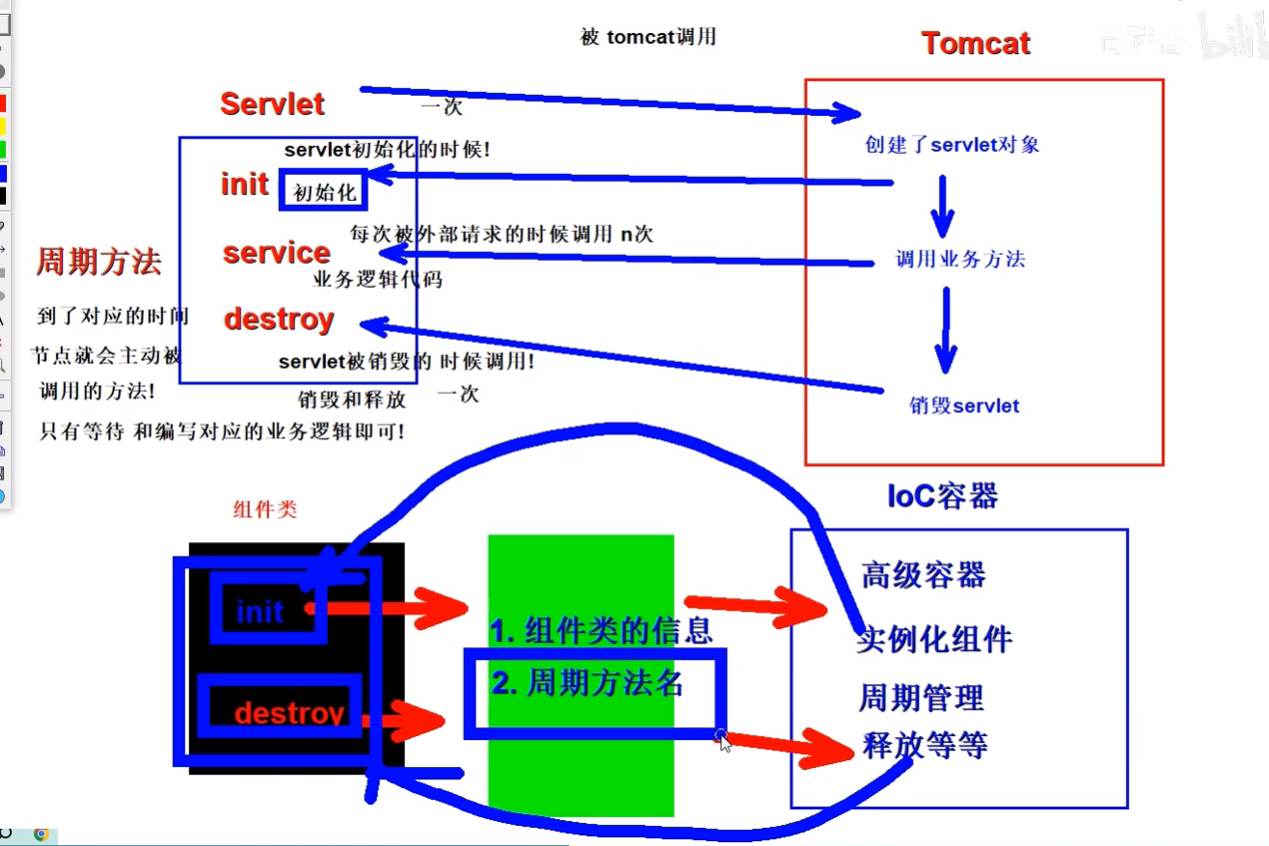
package com.atguigu.ioc_04;
*/**
\* ** projectName: com.atguigu.ioc_04
\* **
\* *** **@author:** *赵伟风
\* ** description:
\* **/
*public class JavaBean {
*/**
\* *** *必须是**public* *必须是* *void* *返回值 必须是无参数的**!
\* *** *命名随意**!
\* *** *初始化方法* *->* *初始化业务逻辑即可**!!
\* **/
\* public void init(){
System.*out*.println("JavaBean.init");
}
*/**
\* *** *销毁方法
\* **/
\* public void clear(){
System.*out*.println("JavaBean.clear");
}
}
<?xml version="1.0" encoding="UTF-8"?>
<beans xmlns="http://www.springframework.org/schema/beans"
xmlns:xsi="http://www.w3.org/2001/XMLSchema-instance"
xsi:schemaLocation="http://www.springframework.org/schema/beans http://www.springframework.org/schema/beans/spring-beans.xsd">
<!--
init-method = "初始化方法名"
destroy-method = "销毁方法名"
spring ioc容器就会在对应的时间节点回调对应的方法,我们可以在其中写对应的业务就可以啦!
-->
<bean id="javaBean" class="com.atguigu.ioc_04.JavaBean" init-method="init" destroy-method="clear" />
<!-- 声明一个组件信息! 默认就是单例模式 一个<bean - beanDefinition - 组件对象 getBean一次就会创建一个组件对象-->
<bean id="javaBean2" class="com.atguigu.ioc_04.JavaBean2" scope="prototype"/>
</beans>
@Test
public void test_04(){
//1.创建ioc容器 就会进行组件对象的实例化 -> init
ClassPathXmlApplicationContext applicationContext
= new ClassPathXmlApplicationContext("spring-04.xml");
//ioc -> 容器去调用 destroy
//ioc会立即释放,死了!
JavaBean2 bean = applicationContext.getBean(JavaBean2.class);
JavaBean2 bean1 = applicationContext.getBean(JavaBean2.class);
System.out.println(bean == bean1);
//2.正常结束ioc容器
applicationContext.close();
}

<!-- 声明一个组件信息! 默认就是单例模式 一个<bean - beanDefinition - 组件对象 getBean一次就会创建一个组件对象-->
<bean id="javaBean2" class="com.atguigu.ioc_04.JavaBean2" scope="prototype"/>
</beans>
JavaBean2 bean = applicationContext.getBean(JavaBean2.class);
JavaBean2 bean1 = applicationContext.getBean(JavaBean2.class);
System.out.println(bean == bean1);
4.2.5 实验五: 高级特性:FactoryBean特性和使用
-
FactoryBean简介
FactoryBean接口是Spring IoC容器实例化逻辑的可插拔性点。用于配置复杂的Bean对象,可以将创建过程存储在
FactoryBean的getObject方法!FactoryBean<T>接口提供三种方法:-
T getObject():返回此工厂创建的对象的实例。该返回值会被存储到IoC容器!
-
boolean isSingleton():如果此
FactoryBean返回单例,则返回true,否则返回false。此方法的默认实现返回true(注意,lombok插件使用,可能影响效果)。 -
Class<?> getObjectType(): 返回getObject()方法返回的对象类型,如果事先不知道类型,则返回null。

-
-
FactoryBean使用场景
- 代理类的创建
- 第三方框架整合
- 复杂对象实例化等
-
Factorybean应用
- 准备FactoryBean实现类
// 实现FactoryBean接口时需要指定泛型 // 泛型类型就是当前工厂要生产的对象的类型 public class HappyFactoryBean implements FactoryBean<HappyMachine> { private String machineName; public String getMachineName() { return machineName; } public void setMachineName(String machineName) { this.machineName = machineName; } @Override public HappyMachine getObject() throws Exception { // 方法内部模拟创建、设置一个对象的复杂过程 HappyMachine happyMachine = new HappyMachine(); happyMachine.setMachineName(this.machineName); return happyMachine; } @Override public Class<?> getObjectType() { // 返回要生产的对象的类型 return HappyMachine.class; } } - 配置FactoryBean实现类
<!-- FactoryBean机制 --> <!-- 这个bean标签中class属性指定的是HappyFactoryBean,但是将来从这里获取的bean是HappyMachine对象 --> <bean id="happyMachine7" class="com.atguigu.ioc.HappyFactoryBean"> <!-- property标签仍然可以用来通过setXxx()方法给属性赋值 --> <property name="machineName" value="iceCreamMachine"/> </bean> - 测试读取FactoryBean和FactoryBean.getObject对象
@Test public void testExperiment07() { ApplicationContext iocContainer = new ClassPathXmlApplicationContext("spring-bean-07.xml"); //注意: 直接根据声明FactoryBean的id,获取的是getObject方法返回的对象 HappyMachine happyMachine = iocContainer.getBean("happyMachine7",HappyMachine.class); System.out.println("happyMachine = " + happyMachine); //如果想要获取FactoryBean对象, 直接在id前添加&符号即可! &happyMachine7 这是一种固定的约束 Object bean = iocContainer.getBean("&happyMachine7"); System.out.println("bean = " + bean); }
- 准备FactoryBean实现类
-
FactoryBean和BeanFactory区别
**FactoryBean **是 Spring 中一种特殊的 bean,可以在 getObject() 工厂方法自定义的逻辑创建Bean!是一种能够生产其他 Bean 的 Bean。FactoryBean 在容器启动时被创建,而在实际使用时则是通过调用 getObject() 方法来得到其所生产的 Bean。因此,FactoryBean 可以自定义任何所需的初始化逻辑,生产出一些定制化的 bean。
一般情况下,整合第三方框架,都是通过定义FactoryBean实现!!!
BeanFactory 是 Spring 框架的基础,其作为一个顶级接口定义了容器的基本行为,例如管理 bean 的生命周期、配置文件的加载和解析、bean 的装配和依赖注入等。BeanFactory 接口提供了访问 bean 的方式,例如 getBean() 方法获取指定的 bean 实例。它可以从不同的来源(例如 Mysql 数据库、XML 文件、Java 配置类等)获取 bean 定义,并将其转换为 bean 实例。同时,BeanFactory 还包含很多子类(例如,ApplicationContext 接口)提供了额外的强大功能。
总的来说,FactoryBean 和 BeanFactory 的区别主要在于前者是用于创建 bean 的接口,它提供了更加灵活的初始化定制功能,而后者是用于管理 bean 的框架基础接口,提供了基本的容器功能和 bean 生命周期管理。
汇总回顾
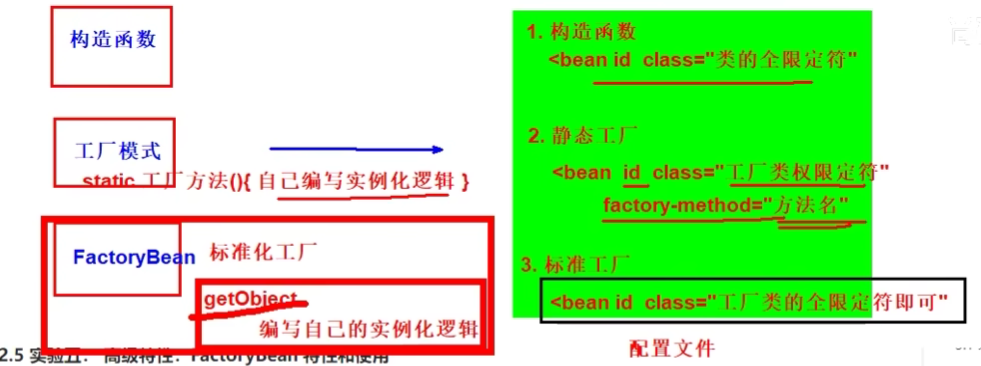

package com.jovey.ioc_05;
import org.springframework.beans.factory.FactoryBean;
/**
* projectName: com.atguigu.ioc_05
*
* @author: 赵伟风
* description: 制造JavaBean的工厂bean对象
*
* 步骤:
* 1. 实现FactoryBean接口 <返回值泛型>
*/
public class JavaBeanFactoryBean implements FactoryBean<JavaBean> {
private String value;
public void setValue(String value) {
this.value = value;
}
@Override
public JavaBean getObject() throws Exception {
//使用你自己的方式实例化对象就可以了!
JavaBean javaBean = new JavaBean();
javaBean.setName(value);
return javaBean;
}
@Override
public Class<?> getObjectType() {
return JavaBean.class;
}
}
<?xml version="1.0" encoding="UTF-8"?>
<beans xmlns="http://www.springframework.org/schema/beans"
xmlns:xsi="http://www.w3.org/2001/XMLSchema-instance"
xsi:schemaLocation="http://www.springframework.org/schema/beans http://www.springframework.org/schema/beans/spring-beans.xsd">
<!--
id -> getObject方法返回的对象的标识
工厂bean的标识 &id值
Class -> factoryBean标准化工厂类
-->
<bean id="javaBean" class="com.atguigu.ioc_05.JavaBeanFactoryBean" >
<!-- 此位置的属性: JavaBean工厂类配置 而不是getObject方法-->
<property name="value" value="二狗子" />
</bean>
</beans>
@Test
public void test_05(){
//1.创建ioc容器 就会进行组件对象的实例化 -> init
ClassPathXmlApplicationContext applicationContext
= new ClassPathXmlApplicationContext("spring-05.xml");
//2.读取组件
JavaBean javaBean = applicationContext.getBean("javaBean", JavaBean.class);
System.out.println("javaBean = " + javaBean);
//TODO: FactoryBean工厂也会加入到ioc容器! 名字 &id
Object bean = applicationContext.getBean("&javaBean");
System.out.println("bean = " + bean);
//3.正常结束ioc容器
applicationContext.close();
}
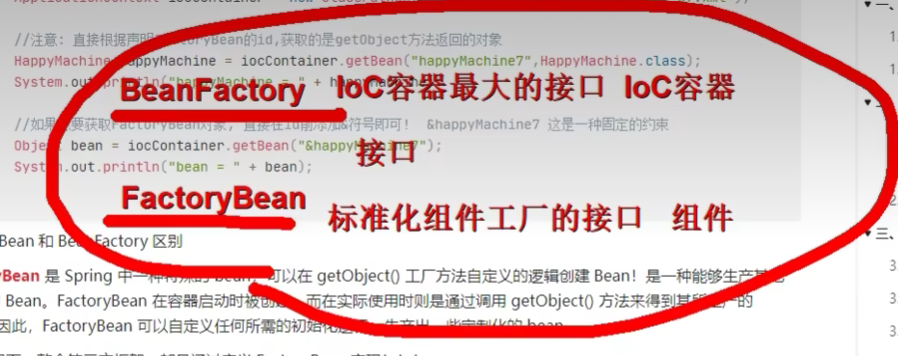
4.2.6 实验六: 基于XML方式整合三层架构组件
-
需求分析
搭建一个三层架构案例,模拟查询全部学生(学生表)信息,持久层使用JdbcTemplate和Druid技术,使用XML方式进行组件管理!

-
数据库准备
create database studb; use studb; CREATE TABLE students ( id INT PRIMARY KEY, name VARCHAR(50) NOT NULL, gender VARCHAR(10) NOT NULL, age INT, class VARCHAR(50) ); INSERT INTO students (id, name, gender, age, class) VALUES (1, '张三', '男', 20, '高中一班'), (2, '李四', '男', 19, '高中二班'), (3, '王五', '女', 18, '高中一班'), (4, '赵六', '女', 20, '高中三班'), (5, '刘七', '男', 19, '高中二班'), (6, '陈八', '女', 18, '高中一班'), (7, '杨九', '男', 20, '高中三班'), (8, '吴十', '男', 19, '高中二班'); -
项目准备
-
项目创建
spring-xml-practice-02
-
依赖导入
<dependencies> <!--spring context依赖--> <!--当你引入SpringContext依赖之后,表示将Spring的基础依赖引入了--> <dependency> <groupId>org.springframework</groupId> <artifactId>spring-context</artifactId> <version>6.0.6</version> </dependency> <!-- 数据库驱动和连接池--> <dependency> <groupId>mysql</groupId> <artifactId>mysql-connector-java</artifactId> <version>8.0.25</version> </dependency> <dependency> <groupId>com.alibaba</groupId> <artifactId>druid</artifactId> <version>1.2.8</version> </dependency> <!-- spring-jdbc --> <dependency> <groupId>org.springframework</groupId> <artifactId>spring-jdbc</artifactId> <version>6.0.6</version> </dependency> </dependencies> -
实体类准备
public class Student { private Integer id; private String name; private String gender; private Integer age; private String classes; public Integer getId() { return id; } public void setId(Integer id) { this.id = id; } public String getName() { return name; } public void setName(String name) { this.name = name; } public String getGender() { return gender; } public void setGender(String gender) { this.gender = gender; } public Integer getAge() { return age; } public void setAge(Integer age) { this.age = age; } public String getClasses() { return classes; } public void setClasses(String classes) { this.classes = classes; } @Override public String toString() { return "Student{" + "id=" + id + ", name='" + name + '\'' + ", gender='" + gender + '\'' + ", age=" + age + ", classes='" + classes + '\'' + '}'; } }
-
-
JdbcTemplate技术讲解
为了在特定领域帮助我们简化代码,Spring 封装了很多 『Template』形式的模板类。例如:RedisTemplate、RestTemplate 等等,包括我们今天要学习的 JdbcTemplate。
jdbc.properties
提取数据库连接信息atguigu.url=jdbc:mysql://localhost:3306/studb atguigu.driver=com.mysql.cj.jdbc.Driver atguigu.username=root atguigu.password=rootspringioc配置文件
<?xml version="1.0" encoding="UTF-8"?> <beans xmlns="http://www.springframework.org/schema/beans" xmlns:xsi="http://www.w3.org/2001/XMLSchema-instance" xmlns:context="http://www.springframework.org/schema/context" xsi:schemaLocation="http://www.springframework.org/schema/beans http://www.springframework.org/schema/beans/spring-beans.xsd http://www.springframework.org/schema/context https://www.springframework.org/schema/context/spring-context.xsd"> <!-- 导入外部属性文件 --> <context:property-placeholder location="classpath:jdbc.properties" /> <!-- 配置数据源 --> <bean id="druidDataSource" class="com.alibaba.druid.pool.DruidDataSource"> <property name="url" value="${atguigu.url}"/> <property name="driverClassName" value="${atguigu.driver}"/> <property name="username" value="${atguigu.username}"/> <property name="password" value="${atguigu.password}"/> </bean> <!-- 配置 JdbcTemplate --> <bean id="jdbcTemplate" class="org.springframework.jdbc.core.JdbcTemplate"> <!-- 装配数据源 --> <property name="dataSource" ref="druidDataSource"/> </bean> </beans>基于jdbcTemplate的CRUD使用
public class JdbcTemplateTest { /** * 使用jdbcTemplate进行DML动作 */ @Test public void testDML(){ ApplicationContext applicationContext = new ClassPathXmlApplicationContext("spring-ioc.xml"); JdbcTemplate jdbcTemplate = applicationContext.getBean(JdbcTemplate.class); //TODO 执行插入一条学员数据 String sql = "insert into students (id,name,gender,age,class) values (?,?,?,?,?);"; /* 参数1: sql语句 参数2: 可变参数,占位符的值 */ int rows = jdbcTemplate.update(sql, 9,"十一", "男", 18, "二年三班"); System.out.println("rows = " + rows); } /** * 查询单条实体对象 * public class Student { * private Integer id; * private String name; * private String gender; * private Integer age; * private String classes; */ @Test public void testDQLForPojo(){ String sql = "select id , name , age , gender , class as classes from students where id = ? ;"; ApplicationContext applicationContext = new ClassPathXmlApplicationContext("spring-ioc.xml"); JdbcTemplate jdbcTemplate = applicationContext.getBean(JdbcTemplate.class); //根据id查询 Student student = jdbcTemplate.queryForObject(sql, (rs, rowNum) -> { //自己处理结果映射 Student stu = new Student(); stu.setId(rs.getInt("id")); stu.setName(rs.getString("name")); stu.setAge(rs.getInt("age")); stu.setGender(rs.getString("gender")); stu.setClasses(rs.getString("classes")); return stu; }, 2); System.out.println("student = " + student); } /** * 查询实体类集合 */ @Test public void testDQLForListPojo(){ String sql = "select id , name , age , gender , class as classes from students ;"; ApplicationContext applicationContext = new ClassPathXmlApplicationContext("spring-ioc.xml"); JdbcTemplate jdbcTemplate = applicationContext.getBean(JdbcTemplate.class); /* query可以返回集合! BeanPropertyRowMapper就是封装好RowMapper的实现,要求属性名和列名相同即可 */ List<Student> studentList = jdbcTemplate.query(sql, new BeanPropertyRowMapper<>(Student.class)); System.out.println("studentList = " + studentList); } } -
三层架构搭建和实现
- 持久层
//接口 public interface StudentDao { /** * 查询全部学生数据 * @return */ List<Student> queryAll(); } //实现类 public class StudentDaoImpl implements StudentDao { private JdbcTemplate jdbcTemplate; public void setJdbcTemplate(JdbcTemplate jdbcTemplate) { this.jdbcTemplate = jdbcTemplate; } /** * 查询全部学生数据 * @return */ @Override public List<Student> queryAll() { String sql = "select id , name , age , gender , class as classes from students ;"; /* query可以返回集合! BeanPropertyRowMapper就是封装好RowMapper的实现,要求属性名和列名相同即可 */ List<Student> studentList = jdbcTemplate.query(sql, new BeanPropertyRowMapper<>(Student.class)); return studentList; } } - 业务层
//接口 public interface StudentService { /** * 查询全部学员业务 * @return */ List<Student> findAll(); } //实现类 public class StudentServiceImpl implements StudentService { private StudentDao studentDao; public void setStudentDao(StudentDao studentDao) { this.studentDao = studentDao; } /** * 查询全部学员业务 * @return */ @Override public List<Student> findAll() { List<Student> studentList = studentDao.queryAll(); return studentList; } } - 表述层
public class StudentController { private StudentService studentService; public void setStudentService(StudentService studentService) { this.studentService = studentService; } public void findAll(){ List<Student> studentList = studentService.findAll(); System.out.println("studentList = " + studentList); } }
- 持久层
-
三层架构IoC配置
<?xml version="1.0" encoding="UTF-8"?> <beans xmlns="http://www.springframework.org/schema/beans" xmlns:xsi="http://www.w3.org/2001/XMLSchema-instance" xmlns:context="http://www.springframework.org/schema/context" xsi:schemaLocation="http://www.springframework.org/schema/beans http://www.springframework.org/schema/beans/spring-beans.xsd http://www.springframework.org/schema/context https://www.springframework.org/schema/context/spring-context.xsd"> <!-- 导入外部属性文件 --> <context:property-placeholder location="classpath:jdbc.properties" /> <!-- 配置数据源 --> <bean id="druidDataSource" class="com.alibaba.druid.pool.DruidDataSource"> <property name="url" value="${atguigu.url}"/> <property name="driverClassName" value="${atguigu.driver}"/> <property name="username" value="${atguigu.username}"/> <property name="password" value="${atguigu.password}"/> </bean> <!-- 配置 JdbcTemplate --> <bean id="jdbcTemplate" class="org.springframework.jdbc.core.JdbcTemplate"> <!-- 装配数据源 --> <property name="dataSource" ref="druidDataSource"/> </bean> <bean id="studentDao" class="com.atguigu.dao.impl.StudentDaoImpl"> <property name="jdbcTemplate" ref="jdbcTemplate" /> </bean> <bean id="studentService" class="com.atguigu.service.impl.StudentServiceImpl"> <property name="studentDao" ref="studentDao" /> </bean> <bean id="studentController" class="com.atguigu.controller.StudentController"> <property name="studentService" ref="studentService" /> </bean> </beans> -
运行测试
public class ControllerTest { @Test public void testRun(){ ApplicationContext applicationContext = new ClassPathXmlApplicationContext("spring-ioc.xml"); StudentController studentController = applicationContext.getBean(StudentController.class); studentController.findAll(); } } -
XMLIoC方式问题总结
- 注入的属性必须添加setter方法、代码结构乱!
- 配置文件和Java代码分离、编写不是很方便!
- XML配置文件解析效率低
回顾汇总
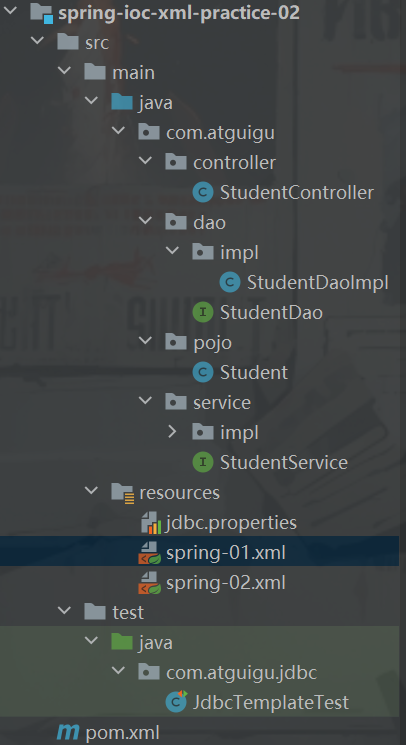
package com.atguigu.jdbc;
import com.alibaba.druid.pool.DruidAbstractDataSource;
import com.alibaba.druid.pool.DruidDataSource;
import com.atguigu.controller.StudentController;
import com.atguigu.pojo.Student;
import org.junit.jupiter.api.Test;
import org.springframework.context.ApplicationContext;
import org.springframework.context.support.ClassPathXmlApplicationContext;
import org.springframework.jdbc.core.BeanPropertyRowMapper;
import org.springframework.jdbc.core.JdbcTemplate;
import org.springframework.jdbc.core.RowMapper;
import java.sql.ResultSet;
import java.sql.SQLException;
import java.util.List;
/**
* projectName: com.atguigu.jdbc
*
* @author: 赵伟风
* description: 测试javaTemplate如何使用
*/
public class JdbcTemplateTest {
public void testForJava(){
/**
* JdbcTemplate 简化数据库的crud 不提供连接池
* |
* DruidDataSource 负责连接的创建和数据库驱动的注册等等
*/
//0.创建一个连接池对象
DruidDataSource dataSource = new DruidDataSource();
dataSource.setUrl("jdbc:mysql:///studb"); //url地址
dataSource.setDriverClassName("com.mysql.cj.jdbc.Driver"); //jdbc驱动
dataSource.setUsername("root"); //账号
dataSource.setPassword("root"); //密码
//1.实例化对象即可
JdbcTemplate jdbcTemplate = new JdbcTemplate();
jdbcTemplate.setDataSource(dataSource);
//2.调用方法即可
// jdbcTemplate.update() DDL DML DCL ... 非查询语句
// jdbcTemplate.queryForObject() DQL 查询单个对象
// jdbcTemplate.query() DQL 查询集合
}
/**
* 通过ioc容器读取配置的JdbcTemplate组件
*/
@Test
public void testForIoC(){
//1.创建ioc容器
ApplicationContext applicationContext
= new ClassPathXmlApplicationContext("spring-01.xml");
//2.获取jdbcTemplate组件
JdbcTemplate jdbcTemplate = applicationContext.getBean(JdbcTemplate.class);
//3.进行数据库的curd动作
//3.1 插入 删除 和 修改 DML update
String sql = "insert into students (id,name,gender,age,class) values (?,?,?,?,?) ";
/**
* 参数1: String sql 可以带占位符 ? ?只能替代值 不能替代关键字和容器名
* 参数2: Object...param 传入占位符的值 顺序 从左开始对象
* 返回值: int 影响函数
*/
int rows = jdbcTemplate.update(sql,9,"二狗子","男",18,"三年二班");
System.out.println("rows = " + rows);
//3.2 查询单条数据
//根据id查询学生数据 返回一个对应的实体对象
sql = "select * from students where id = ? ;";
/**
* 参数1: sql语句 可以使用?
* 参数2: RowMapper 列名和属性名的映射器接口
* 参数3: Object...param 可以变参数 占位符的值
* 返回值 rowMapper指定的对象
*/
Student student1 = jdbcTemplate.queryForObject(sql, (rs, rowNum) -> {
//rs 结果集
//rowNum 行数
//rs结果集中获取列的值 赋值给实体类对象即可
Student student = new Student();
student.setId(rs.getInt("id"));
student.setName(rs.getString("name"));
student.setAge(rs.getInt("age"));
student.setGender(rs.getString("gender"));
student.setClasses(rs.getString("class"));
return student;
}, 1);
System.out.println("student1 = " + student1);
//3.3 查询所有学生数据
sql = "select id , name ,gender , age , class as classes from students ;";
//TODO: BeanPropertyRowMapper帮助我们自动映射列和属性值!要求列名和属性名一致!不一致 起别名!
List<Student> studentList = jdbcTemplate.query(sql, new BeanPropertyRowMapper<Student>(Student.class));
System.out.println("studentList = " + studentList);
}
/**
* 从ioc容器中获取controller并且调用业务! 内部都是ioc容器进行组装
*/
@Test
public void testQueryAll(){
//1.创建ioc容器
ClassPathXmlApplicationContext applicationContext
= new ClassPathXmlApplicationContext("spring-02.xml");
//2.获取组件对象
StudentController controller = applicationContext.getBean(StudentController.class);
//3.使用组件对象
controller.findAll();
//4.关闭容器
applicationContext.close();
}
}
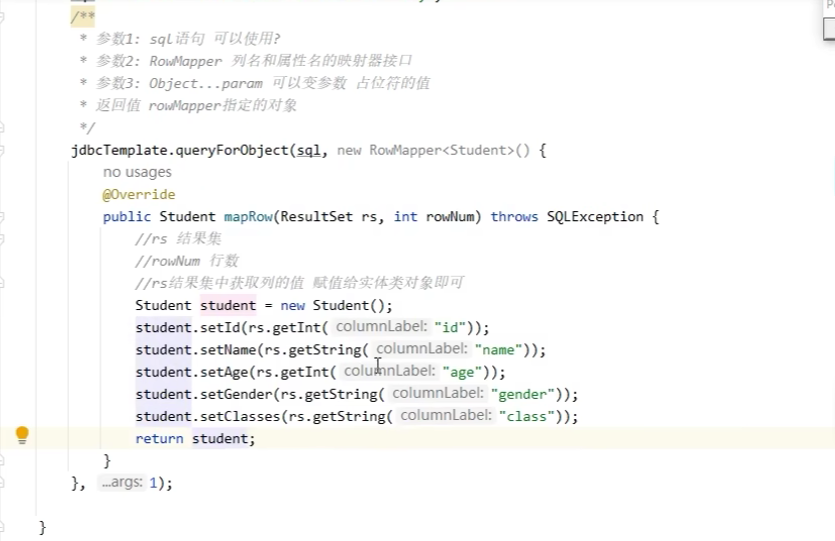
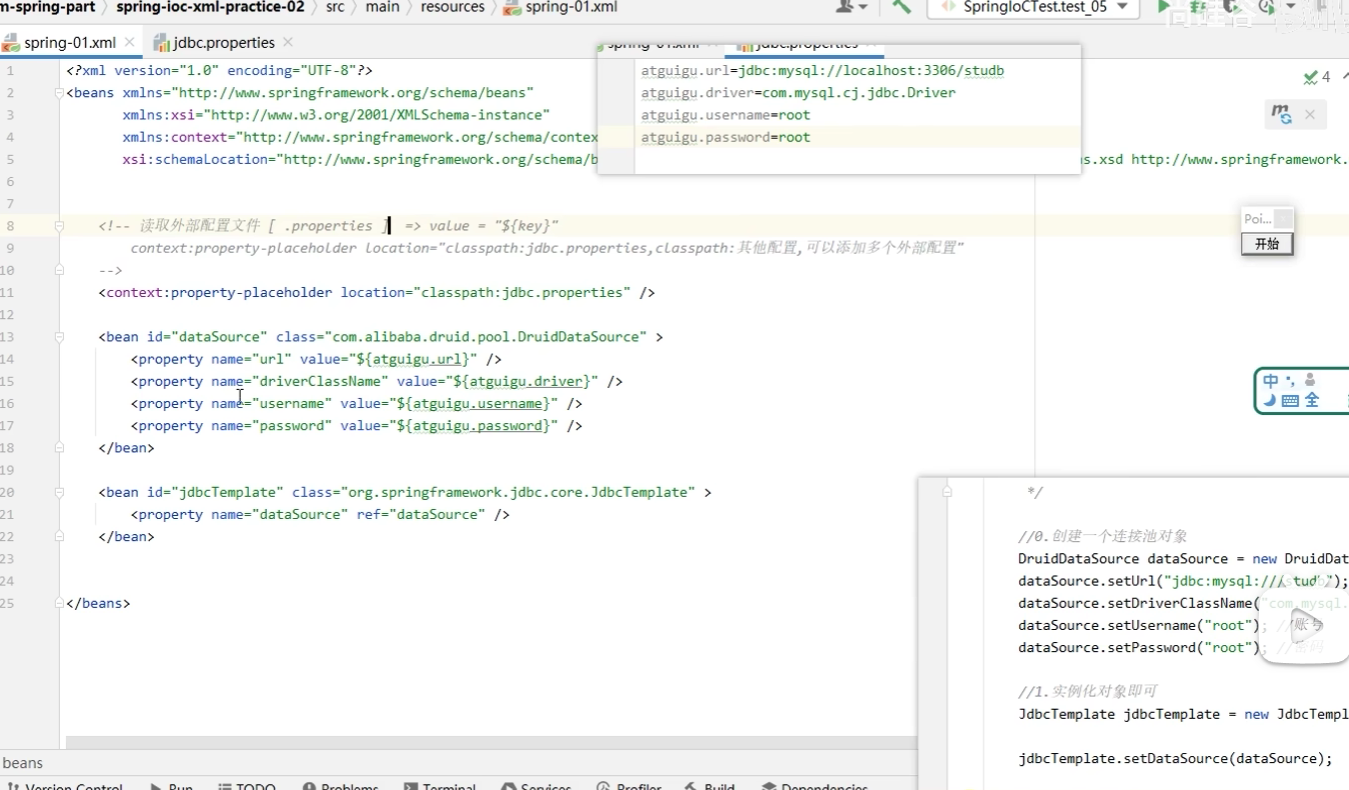
<?xml version="1.0" encoding="UTF-8"?>
<beans xmlns="http://www.springframework.org/schema/beans"
xmlns:xsi="http://www.w3.org/2001/XMLSchema-instance"
xmlns:context="http://www.springframework.org/schema/context"
xsi:schemaLocation="http://www.springframework.org/schema/beans http://www.springframework.org/schema/beans/spring-beans.xsd http://www.springframework.org/schema/context https://www.springframework.org/schema/context/spring-context.xsd">
<!-- 读取外部配置文件 [ .properties ] => value = "${key}"
context:property-placeholder location="classpath:jdbc.properties,classpath:其他配置,可以添加多个外部配置"
-->
<context:property-placeholder location="classpath:jdbc.properties" />
<bean id="dataSource" class="com.alibaba.druid.pool.DruidDataSource" >
<property name="url" value="${atguigu.url}" />
<property name="driverClassName" value="${atguigu.driver}" />
<property name="username" value="${atguigu.username}" />
<property name="password" value="${atguigu.password}" />
</bean>
<bean id="jdbcTemplate" class="org.springframework.jdbc.core.JdbcTemplate" >
<property name="dataSource" ref="dataSource" />
</bean>
</beans>
pojo实体类→dao层(持久层),先接口,再实现类
package com.atguigu.pojo;
public class Student {
private Integer id;
private String name;
private String gender;
private Integer age;
private String classes;
public Integer getId() {
return id;
}
public void setId(Integer id) {
this.id = id;
}
public String getName() {
return name;
}
public void setName(String name) {
this.name = name;
}
public String getGender() {
return gender;
}
public void setGender(String gender) {
this.gender = gender;
}
public Integer getAge() {
return age;
}
public void setAge(Integer age) {
this.age = age;
}
public String getClasses() {
return classes;
}
public void setClasses(String classes) {
this.classes = classes;
}
@Override
public String toString() {
return "Student{" +
"id=" + id +
", name='" + name + '\'' +
", gender='" + gender + '\'' +
", age=" + age +
", classes='" + classes + '\'' +
'}';
}
}
dao层,也是持久层
package com.atguigu.dao;
import com.atguigu.pojo.Student;
import java.util.List;
/**
* projectName: com.atguigu.dao
*
* @author: 赵伟风
* description: 数据层的接口
*/
public interface StudentDao {
/**
* 数据库查询全部学生数据
* @return
*/
List<Student> queryAll();
}
package com.atguigu.dao.impl;
import com.atguigu.dao.StudentDao;
import com.atguigu.pojo.Student;
import org.springframework.jdbc.core.BeanPropertyRowMapper;
import org.springframework.jdbc.core.JdbcTemplate;
import java.util.List;
/**
* projectName: com.atguigu.dao.impl
*
* @author: 赵伟风
* description:
*/
public class StudentDaoImpl implements StudentDao {
private JdbcTemplate jdbcTemplate;
//注入我们的jdbcTemplate对象
public void setJdbcTemplate(JdbcTemplate jdbcTemplate) {
this.jdbcTemplate = jdbcTemplate;
}
/**
* 数据库查询全部学生数据
*
* @return
*/
@Override
public List<Student> queryAll() {
//jdbcTemplate进行数据库的查询 ioc容器进行装配 不要自己去实例化
String sql = "select id , name, gender ,age , class as classes from students ";
List<Student> students = jdbcTemplate.query(sql, new BeanPropertyRowMapper<>(Student.class));
System.out.println("studentDao:"+students);
return students;
}
}
service层也就是业务层
package com.atguigu.service;
import com.atguigu.pojo.Student;
import java.util.List;
/**
* projectName: com.atguigu.service
*
* @author: 赵伟风
* description: 学生业务接口
*/
public interface StudentService {
/**
* 查询所有学员数据业务
* @return
*/
List<Student> findAll();
}
package com.atguigu.service.impl;
import com.atguigu.dao.StudentDao;
import com.atguigu.pojo.Student;
import com.atguigu.service.StudentService;
import java.util.List;
/**
* projectName: com.atguigu.service.impl
*
* @author: 赵伟风
* description:
*/
public class StudentServiceImpl implements StudentService {
private StudentDao studentDao;
public void setStudentDao(StudentDao studentDao) {
this.studentDao = studentDao;
}
/**
* 查询所有学员数据业务
*
* @return
*/
@Override
public List<Student> findAll() {
List<Student> studentList = studentDao.queryAll();
System.out.println("studentService:"+studentList);
return studentList;
}
}
controler层。也即是控制层
package com.atguigu.controller;
import com.atguigu.pojo.Student;
import com.atguigu.service.StudentService;
import java.util.List;
/**
* projectName: com.atguigu.controller
*
* @author: 赵伟风
* description:
*/
public class StudentController {
private StudentService studentService;
public void setStudentService(StudentService studentService) {
this.studentService = studentService;
}
public void findAll(){
List<Student> all = studentService.findAll();
System.out.println("最终学员数据:"+all);
}
}
然后再到resource层去设置映射
<?xml version="1.0" encoding="UTF-8"?>
<beans xmlns="http://www.springframework.org/schema/beans"
xmlns:xsi="http://www.w3.org/2001/XMLSchema-instance"
xmlns:context="http://www.springframework.org/schema/context"
xsi:schemaLocation="http://www.springframework.org/schema/beans http://www.springframework.org/schema/beans/spring-beans.xsd http://www.springframework.org/schema/context https://www.springframework.org/schema/context/spring-context.xsd">
<context:property-placeholder location="classpath:jdbc.properties" />
<!-- druid -->
<bean id="dataSource" class="com.alibaba.druid.pool.DruidDataSource">
<property name="url" value="${atguigu.url}" />
<property name="driverClassName" value="${atguigu.driver}" />
<property name="username" value="${atguigu.username}" />
<property name="password" value="${atguigu.password}" />
</bean>
<!-- jdbcTemplate-->
<bean id="jdbcTemplate" class="org.springframework.jdbc.core.JdbcTemplate">
<property name="dataSource" ref="dataSource" />
</bean>
<!-- dao 配置 di jdbcTemplate-->
<bean id="studentDao" class="com.atguigu.dao.impl.StudentDaoImpl">
<property name="jdbcTemplate" ref="jdbcTemplate" />
</bean>
<!-- service 配置 di dao-->
<bean id="studentService" class="com.atguigu.service.impl.StudentServiceImpl">
<property name="studentDao" ref="studentDao" />
</bean>
<!-- controller 配置 di service-->
<bean id="studentController" class="com.atguigu.controller.StudentController">
<property name="studentService" ref="studentService" />
</bean>
</beans>
最后是在前端操作处来对controler层进行调用
/**
* 从ioc容器中获取controller并且调用业务! 内部都是ioc容器进行组装
*/
@Test
public void testQueryAll(){
//1.创建ioc容器
ClassPathXmlApplicationContext applicationContext
= new ClassPathXmlApplicationContext("spring-02.xml");
//2.获取组件对象
StudentController controller = applicationContext.getBean(StudentController.class);
//3.使用组件对象
controller.findAll();
//4.关闭容器
applicationContext.close();
}
4.3 基于 注解 方式管理 Bean
4.3.1 实验一: Bean注解标记和扫描 (IoC)
-
注解理解
和 XML 配置文件一样,注解本身并不能执行,注解本身仅仅只是做一个标记,具体的功能是框架检测到注解标记的位置,然后针对这个位置按照注解标记的功能来执行具体操作。
本质上:所有一切的操作都是 Java 代码来完成的,XML 和注解只是告诉框架中的 Java 代码如何执行。
举例:元旦联欢会要布置教室,蓝色的地方贴上元旦快乐四个字,红色的地方贴上拉花,黄色的地方贴上气球。

班长做了所有标记,同学们来完成具体工作。墙上的标记相当于我们在代码中使用的注解,后面同学们做的工作,相当于框架的具体操作。
-
扫描理解
Spring 为了知道程序员在哪些地方标记了什么注解,就需要通过扫描的方式,来进行检测。然后根据注解进行后续操作。
-
准备Spring项目和组件
-
准备项目pom.xml
<dependencies> <!--spring context依赖--> <!--当你引入Spring Context依赖之后,表示将Spring的基础依赖引入了--> <dependency> <groupId>org.springframework</groupId> <artifactId>spring-context</artifactId> <version>6.0.6</version> </dependency> <!--junit5测试--> <dependency> <groupId>org.junit.jupiter</groupId> <artifactId>junit-jupiter-api</artifactId> <version>5.3.1</version> </dependency> </dependencies> -
准备组件类
普通组件
/** * projectName: com.atguigu.components * * description: 普通的组件 */ public class CommonComponent { }Controller组件
/** * projectName: com.atguigu.components * * description: controller类型组件 */ public class XxxController { }Service组件
/** * projectName: com.atguigu.components * * description: service类型组件 */ public class XxxService { }Dao组件
/** * projectName: com.atguigu.components * * description: dao类型组件 */ public class XxxDao { }
-
-
组件添加标记注解
-
组件标记注解和区别
Spring 提供了以下多个注解,这些注解可以直接标注在 Java 类上,将它们定义成 Spring Bean。
注解 说明 @Component 该注解用于描述 Spring 中的 Bean,它是一个泛化的概念,仅仅表示容器中的一个组件(Bean),并且可以作用在应用的任何层次,例如 Service 层、Dao 层等。 使用时只需将该注解标注在相应类上即可。 @Repository 该注解用于将数据访问层(Dao 层)的类标识为 Spring 中的 Bean,其功能与 @Component 相同。 @Service 该注解通常作用在业务层(Service 层),用于将业务层的类标识为 Spring 中的 Bean,其功能与 @Component 相同。 @Controller 该注解通常作用在控制层(如SpringMVC 的 Controller),用于将控制层的类标识为 Spring 中的 Bean,其功能与 @Component 相同。 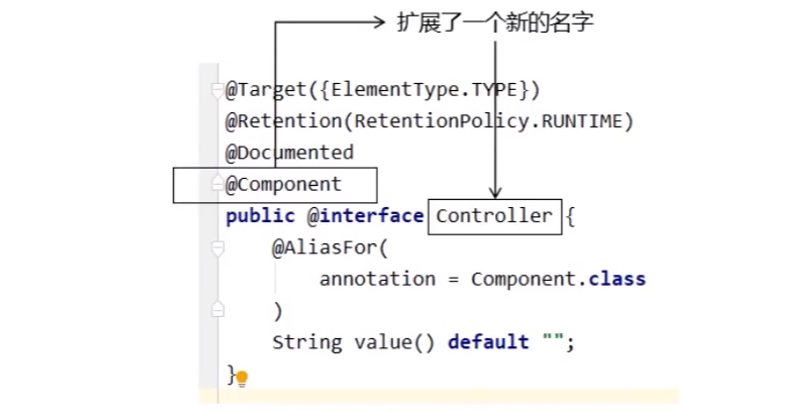
通过查看源码我们得知,@Controller、@Service、@Repository这三个注解只是在@Component注解的基础上起了三个新的名字。 对于Spring使用IOC容器管理这些组件来说没有区别,也就是语法层面没有区别。所以@Controller、@Service、@Repository这三个注解只是给开发人员看的,让我们能够便于分辨组件的作用。
注意:虽然它们本质上一样,但是为了代码的可读性、程序结构严谨!我们肯定不能随便胡乱标记。
-
使用注解标记
普通组件
/** * projectName: com.atguigu.components * * description: 普通的组件 */ @Component public class CommonComponent { }Controller组件
/** * projectName: com.atguigu.components * * description: controller类型组件 */ @Controller public class XxxController { }Service组件
/** * projectName: com.atguigu.components * * description: service类型组件 */ @Service public class XxxService { }Dao组件
/** * projectName: com.atguigu.components * * description: dao类型组件 */ @Repository public class XxxDao { }
-
-
配置文件确定扫描范围
情况1:基本扫描配置
<?xml version="1.0" encoding="UTF-8"?> <beans xmlns="http://www.springframework.org/schema/beans" xmlns:xsi="http://www.w3.org/2001/XMLSchema-instance" xmlns:context="http://www.springframework.org/schema/context" xsi:schemaLocation="http://www.springframework.org/schema/beans http://www.springframework.org/schema/beans/spring-beans.xsd http://www.springframework.org/schema/context https://www.springframework.org/schema/context/spring-context.xsd"> <!-- 配置自动扫描的包 --> <!-- 1.包要精准,提高性能! 2.会扫描指定的包和子包内容 3.多个包可以使用,分割 例如: com.atguigu.controller,com.atguigu.service等 --> <context:component-scan base-package="com.atguigu.components"/> </beans>情况2:指定排除组件
<!-- 情况三:指定不扫描的组件 --> <context:component-scan base-package="com.atguigu.components"> <!-- context:exclude-filter标签:指定排除规则 --> <!-- type属性:指定根据什么来进行排除,annotation取值表示根据注解来排除 --> <!-- expression属性:指定排除规则的表达式,对于注解来说指定全类名即可 --> <context:exclude-filter type="annotation" expression="org.springframework.stereotype.Controller"/> </context:component-scan>情况3:指定扫描组件
<!-- 情况四:仅扫描指定的组件 --> <!-- 仅扫描 = 关闭默认规则 + 追加规则 --> <!-- use-default-filters属性:取值false表示关闭默认扫描规则 --> <context:component-scan base-package="com.atguigu.ioc.components" use-default-filters="false"> <!-- context:include-filter标签:指定在原有扫描规则的基础上追加的规则 --> <context:include-filter type="annotation" expression="org.springframework.stereotype.Controller"/> </context:component-scan> -
组件BeanName问题
在我们使用 XML 方式管理 bean 的时候,每个 bean 都有一个唯一标识——id 属性的值,便于在其他地方引用。现在使用注解后,每个组件仍然应该有一个唯一标识。
默认情况:
类名首字母小写就是 bean 的 id。例如:SoldierController 类对应的 bean 的 id 就是 soldierController。
使用value属性指定:
@Controller(value = "tianDog") public class SoldierController { }当注解中只设置一个属性时,value属性的属性名可以省略:
@Service("smallDog") public class SoldierService { } -
总结
- 注解方式IoC只是标记哪些类要被Spring管理
- 最终,我们还需要XML方式或者后面讲解Java配置类方式指定注解生效的包
- 现阶段配置方式为 注解 (标记)+ XML(扫描)
回顾总结
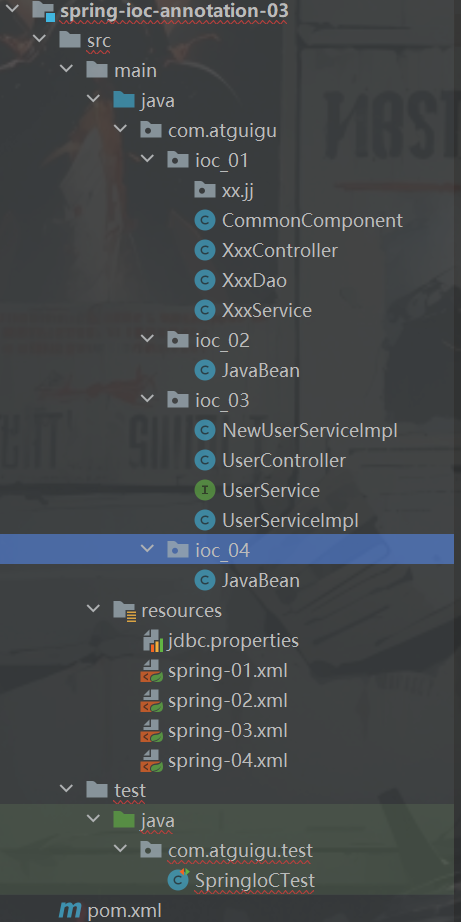

添加注解
扫描包
<?xml version="1.0" encoding="UTF-8"?>
<beans xmlns="http://www.springframework.org/schema/beans"
xmlns:xsi="http://www.w3.org/2001/XMLSchema-instance"
xmlns:context="http://www.springframework.org/schema/context"
xsi:schemaLocation="http://www.springframework.org/schema/beans http://www.springframework.org/schema/beans/spring-beans.xsd http://www.springframework.org/schema/context https://www.springframework.org/schema/context/spring-context.xsd">
<!--1. 普通配置包扫描
base-package 指定ioc容器去哪些包下查找注解类 -> ioc容器
一个包或者多个包 com.atguigu,com.atguigu.xxx 包,包
指定包,相当于指定了子包内的所有类
-->
<!-- <context:component-scan base-package="com.atguigu.ioc_01" />-->
<!-- 2.指定包,但是排除注解 -->
<!-- <context:component-scan base-package="com.atguigu" >-->
<!-- <!– 排除包下的注解–>-->
<!-- <context:exclude-filter type="annotation" expression="org.springframework.stereotype.Repository"/>-->
<!-- <context:exclude-filter type="annotation" expression="org.springframework.stereotype.Controller"/>-->
<!-- </context:component-scan>-->
<!--3.指定包,指定包含注解 -->
<!-- basePackage包下的所有注解都生效!! use-default-filters="false" 指定包的所有注解先不生效! -->
<context:component-scan base-package="com.atguigu" use-default-filters="false">
<!-- 只扫描包下的注解 -->
<context:include-filter type="annotation" expression="org.springframework.stereotype.Repository"/>
</context:component-scan>
</beans>
测试
@Test
public void testIoc_01(){
//1.创建ioc容器
ClassPathXmlApplicationContext applicationContext
= new ClassPathXmlApplicationContext("spring-01.xml");
//2.获取组件
XxxDao bean = applicationContext.getBean(XxxDao.class);
System.out.println("bean = " + bean);
//添加ioc注解,默认的组件名为 类的首字母小写!
Object xxxService = applicationContext.getBean("xxxService");
System.out.println("xxxService = " + xxxService);
//3.close容器
}
排除包
<!-- 2.指定包,但是排除注解 -->
<!-- <context:component-scan base-package="com.atguigu" >-->
<!-- <!– 排除包下的注解–>-->
<!-- <context:exclude-filter type="annotation" expression="org.springframework.stereotype.Repository"/>-->
<!-- <context:exclude-filter type="annotation" expression="org.springframework.stereotype.Controller"/>-->
<!-- </context:component-scan>-->
`
周期方法
package com.atguigu.ioc_02;
import org.springframework.beans.factory.config.ConfigurableBeanFactory;
import org.springframework.context.ConfigurableApplicationContext;
import org.springframework.context.annotation.Scope;
import org.springframework.stereotype.Component;
import javax.annotation.PostConstruct;
import javax.annotation.PreDestroy;
/**
* projectName: com.atguigu.ioc_02
*
* @author: 赵伟风
* description:
*/
//@Scope(scopeName = ConfigurableBeanFactory.SCOPE_SINGLETON) //单例 默认值
@Scope(scopeName = ConfigurableBeanFactory.SCOPE_PROTOTYPE) //多例
@Component // <bean id=javaBean class="JavaBean"
public class JavaBean {
//周期方法命名随意 public void 没有形参
@PostConstruct
public void init(){
System.out.println("JavaBean.init");
}
@PreDestroy
public void destroy(){
System.out.println("JavaBean.destroy");
}
}
配置映射
<?xml version="1.0" encoding="UTF-8"?>
<beans xmlns="http://www.springframework.org/schema/beans"
xmlns:xsi="http://www.w3.org/2001/XMLSchema-instance"
xmlns:context="http://www.springframework.org/schema/context"
xsi:schemaLocation="http://www.springframework.org/schema/beans http://www.springframework.org/schema/beans/spring-beans.xsd http://www.springframework.org/schema/context https://www.springframework.org/schema/context/spring-context.xsd">
<context:component-scan base-package="com.atguigu.ioc_02" />
</beans>
@Test
public void testIoc_02(){
ClassPathXmlApplicationContext applicationContext
= new ClassPathXmlApplicationContext("spring-02.xml");
JavaBean bean = applicationContext.getBean(JavaBean.class);
JavaBean bean1 = applicationContext.getBean(JavaBean.class);
System.out.println(bean == bean1);
applicationContext.close();
}
@Autowired注解细节
controler
package com.atguigu.ioc_03;
import org.springframework.stereotype.Controller;
import org.springframework.stereotype.Service;
/**
* projectName: com.atguigu.ioc_03
*
* @author: 赵伟风
* description:
*/
@Service
public class UserServiceImpl implements UserService{
@Override
public String show() {
return "UserServiceImpl show();";
}
}
service
package com.atguigu.ioc_03;
/**
* projectName: com.atguigu.ioc_03
*
* @author: 赵伟风
* description:
*/
public interface UserService {
public String show();
}
serviceimpl
package com.atguigu.ioc_03;
import org.springframework.stereotype.Controller;
import org.springframework.stereotype.Service;
/**
* projectName: com.atguigu.ioc_03
*
* @author: 赵伟风
* description:
*/
@Service
public class UserServiceImpl implements UserService{
@Override
public String show() {
return "UserServiceImpl show();";
}
}
xml
<?xml version="1.0" encoding="UTF-8"?>
<beans xmlns="http://www.springframework.org/schema/beans"
xmlns:xsi="http://www.w3.org/2001/XMLSchema-instance"
xmlns:context="http://www.springframework.org/schema/context"
xsi:schemaLocation="http://www.springframework.org/schema/beans http://www.springframework.org/schema/beans/spring-beans.xsd http://www.springframework.org/schema/context https://www.springframework.org/schema/context/spring-context.xsd">
<context:component-scan base-package="com.jovey.ioc_03" />
</beans>
@Test
public void testIoc_03() {
ClassPathXmlApplicationContext applicationContext
= new ClassPathXmlApplicationContext("spring-03.xml");
UserController userController = applicationContext.getBean(UserController.class);
//场景1: ioc容器中有一个UserService接口对应的实现类对象!
userController.show();
//场景2: ioc容器没有默认的类型如何处理
// @Autowired 使用它进行装配,【 默认 】情况下至少要求有一个bean! 否则报错! 可以指定佛系装配
//场景3:同一个类型有多个对应的组件 @Autowired也会报错! 无法选择!!
//解决1: 成员属性名指定 @Autowired 多个组件的时候,默认会根据成员属性名查找
//解决2: @Qualifier(value = "userServiceImpl") 使用该注解指定获取bean的id! 不能单独使用必须配合autowired
//优化点: @Autowired(required = true) + @Qualifier(value = "userServiceImpl") == @Resource(name="userServiceImpl")
}
4.3.2 实验二: 组件(Bean)作用域和周期方法注解
- 组件周期方法配置
-
周期方法概念
我们可以在组件类中定义方法,然后当IoC容器实例化和销毁组件对象的时候进行调用!这两个方法我们成为生命周期方法!
类似于Servlet的init/destroy方法,我们可以在周期方法完成初始化和释放资源等工作。
-
周期方法声明
public class BeanOne { //周期方法要求: 方法命名随意,但是要求方法必须是 public void 无形参列表 @PostConstruct //注解制指定初始化方法 public void init() { // 初始化逻辑 } } public class BeanTwo { @PreDestroy //注解指定销毁方法 public void cleanup() { // 释放资源逻辑 } }
-
- 组件作用域配置
-
Bean作用域概念
<bean标签声明Bean,只是将Bean的信息配置给SpringIoC容器!在IoC容器中,这些
<bean标签对应的信息转成Spring内部BeanDefinition对象,BeanDefinition对象内,包含定义的信息(id,class,属性等等)!这意味着,
BeanDefinition与类概念一样,SpringIoC容器可以可以根据BeanDefinition对象反射创建多个Bean对象实例。具体创建多少个Bean的实例对象,由Bean的作用域Scope属性指定!
-
作用域可选值
取值 含义 创建对象的时机 默认值 singleton 在 IOC 容器中,这个 bean 的对象始终为单实例 IOC 容器初始化时 是 prototype 这个 bean 在 IOC 容器中有多个实例 获取 bean 时 否 如果是在WebApplicationContext环境下还会有另外两个作用域(但不常用): 取值 含义 创建对象的时机 默认值 ------- ---------- ------- — request 请求范围内有效的实例 每次请求 否 session 会话范围内有效的实例 每次会话 否 -
作用域配置
@Scope(scopeName = ConfigurableBeanFactory.SCOPE_SINGLETON) //单例,默认值 @Scope(scopeName = ConfigurableBeanFactory.SCOPE_PROTOTYPE) //多例 二选一 public class BeanOne { //周期方法要求: 方法命名随意,但是要求方法必须是 public void 无形参列表 @PostConstruct //注解制指定初始化方法 public void init() { // 初始化逻辑 } }
-
4.3.3 实验三: Bean属性赋值:引用类型自动装配 (DI)
-
设定场景
- SoldierController 需要 SoldierService
- SoldierService 需要 SoldierDao
同时在各个组件中声明要调用的方法。 - SoldierController中声明方法
import org.springframework.stereotype.Controller; @Controller(value = "tianDog") public class SoldierController { private SoldierService soldierService; public void getMessage() { soldierService.getMessage(); } } - SoldierService中声明方法
@Service("smallDog") public class SoldierService { private SoldierDao soldierDao; public void getMessage() { soldierDao.getMessage(); } } - SoldierDao中声明方法
@Repository public class SoldierDao { public void getMessage() { System.out.print("I am a soldier"); } }
-
自动装配实现
-
前提
参与自动装配的组件(需要装配、被装配)全部都必须在IoC容器中。
注意:不区分IoC的方式!XML和注解都可以!
-
@Autowired注解
在成员变量上直接标记@Autowired注解即可,不需要提供setXxx()方法。以后我们在项目中的正式用法就是这样。
-
给Controller装配Service
@Controller(value = "tianDog") public class SoldierController { @Autowired private SoldierService soldierService; public void getMessage() { soldierService.getMessage(); } } -
给Service装配Dao
@Service("smallDog") public class SoldierService { @Autowired private SoldierDao soldierDao; public void getMessage() { soldierDao.getMessage(); } }
-
-
@Autowired注解细节
-
标记位置
-
成员变量
这是最主要的使用方式!
与xml进行bean ref引用不同,他不需要有set方法!
@Service("smallDog") public class SoldierService { @Autowired private SoldierDao soldierDao; public void getMessage() { soldierDao.getMessage(); } } -
构造器
@Controller(value = "tianDog") public class SoldierController { private SoldierService soldierService; @Autowired public SoldierController(SoldierService soldierService) { this.soldierService = soldierService; } …… -
setXxx()方法
@Controller(value = "tianDog") public class SoldierController { private SoldierService soldierService; @Autowired public void setSoldierService(SoldierService soldierService) { this.soldierService = soldierService; } ……
-
-
工作流程
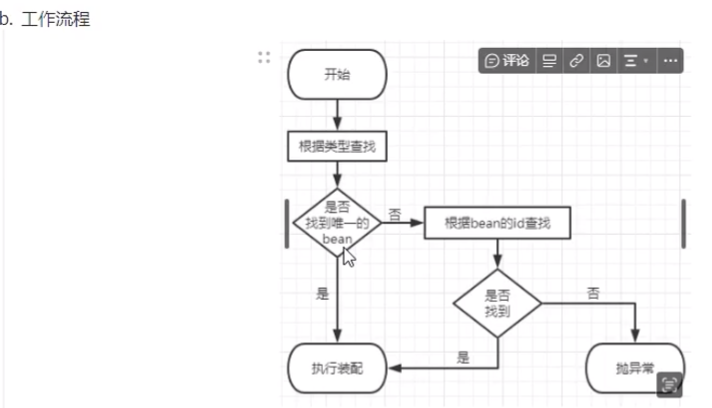
- 首先根据所需要的组件类型到 IOC 容器中查找
- 能够找到唯一的 bean:直接执行装配
- 如果完全找不到匹配这个类型的 bean:装配失败
- 和所需类型匹配的 bean 不止一个
- 没有 @Qualifier 注解:根据 @Autowired 标记位置成员变量的变量名作为 bean 的 id 进行匹配
- 能够找到:执行装配
- 找不到:装配失败
- 使用 @Qualifier 注解:根据 @Qualifier 注解中指定的名称作为 bean 的id进行匹配
- 能够找到:执行装配
- 找不到:装配失败
- 没有 @Qualifier 注解:根据 @Autowired 标记位置成员变量的变量名作为 bean 的 id 进行匹配
@Controller(value = "tianDog") public class SoldierController { @Autowired @Qualifier(value = "maomiService222") // 根据面向接口编程思想,使用接口类型引入Service组件 private ISoldierService soldierService; - 首先根据所需要的组件类型到 IOC 容器中查找
-
-
佛系装配
给 @Autowired 注解设置 required = false 属性表示:能装就装,装不上就不装。但是实际开发时,基本上所有需要装配组件的地方都是必须装配的,用不上这个属性
@Controller(value = "tianDog") public class SoldierController { // 给@Autowired注解设置required = false属性表示:能装就装,装不上就不装 @Autowired(required = false) private ISoldierService soldierService; -
扩展JSR-250注解@Resource
-
理解JSR系列注解
JSR(Java Specification Requests)是Java平台标准化进程中的一种技术规范,而JSR注解是其中一部分重要的内容。按照JSR的分类以及注解语义的不同,可以将JSR注解分为不同的系列,主要有以下几个系列:
- JSR-175: 这个JSR是Java SE 5引入的,是Java注解最早的规范化版本,Java SE 5后的版本中都包含该JSR中定义的注解。主要包括以下几种标准注解:
@Deprecated: 标识一个程序元素(如类、方法或字段)已过时,并且在将来的版本中可能会被删除。@Override: 标识一个方法重写了父类中的方法。@SuppressWarnings: 抑制编译时产生的警告消息。@SafeVarargs: 标识一个有安全性警告的可变参数方法。@FunctionalInterface: 标识一个接口只有一个抽象方法,可以作为lambda表达式的目标。
- JSR-250: 这个JSR主要用于在Java EE 5中定义一些支持注解。该JSR主要定义了一些用于进行对象管理的注解,包括:
@Resource: 标识一个需要注入的资源,是实现Java EE组件之间依赖关系的一种方式。@PostConstruct: 标识一个方法作为初始化方法。@PreDestroy: 标识一个方法作为销毁方法。@Resource.AuthenticationType: 标识注入的资源的身份验证类型。@Resource.AuthenticationType: 标识注入的资源的默认名称。
- JSR-269: 这个JSR主要是Java SE 6中引入的一种支持编译时元数据处理的框架,即使用注解来处理Java源文件。该JSR定义了一些可以用注解标记的注解处理器,用于生成一些元数据,常用的注解有:
@SupportedAnnotationTypes: 标识注解处理器所处理的注解类型。@SupportedSourceVersion: 标识注解处理器支持的Java源码版本。
- JSR-330: 该JSR主要为Java应用程序定义了一个依赖注入的标准,即Java依赖注入标准(javax.inject)。在此规范中定义了多种注解,包括:
@Named: 标识一个被依赖注入的组件的名称。@Inject: 标识一个需要被注入的依赖组件。@Singleton: 标识一个组件的生命周期只有一个唯一的实例。
- JSR-250: 这个JSR主要是Java EE 5中定义一些支持注解。该JSR包含了一些支持注解,可以用于对Java EE组件进行管理,包括:
@RolesAllowed: 标识授权角色@PermitAll: 标识一个活动无需进行身份验证。@DenyAll: 标识不提供针对该方法的访问控制。@DeclareRoles: 声明安全角色。
但是你要理解JSR是Java提供的技术规范,也就是说,他只是规定了注解和注解的含义,JSR并不是直接提供特定的实现,而是提供标准和指导方针,由第三方框架(Spring)和库来实现和提供对应的功能。
-
JSR-250 @Resource注解
@Resource注解也可以完成属性注入。那它和@Autowired注解有什么区别?
- @Resource注解是JDK扩展包中的,也就是说属于JDK的一部分。所以该注解是标准注解,更加具有通用性。(JSR-250标准中制定的注解类型。JSR是Java规范提案。)
- @Autowired注解是Spring框架自己的。
- @Resource注解默认根据Bean名称装配,未指定name时,使用属性名作为name。通过name找不到的话会自动启动通过类型装配。
- @Autowired注解默认根据类型装配,如果想根据名称装配,需要配合@Qualifier注解一起用。
- @Resource注解用在属性上、setter方法上。
- @Autowired注解用在属性上、setter方法上、构造方法上、构造方法参数上。
@Resource注解属于JDK扩展包,所以不在JDK当中,需要额外引入以下依赖:【高于JDK11或低于JDK8需要引入以下依赖】
<dependency> <groupId>jakarta.annotation</groupId> <artifactId>jakarta.annotation-api</artifactId> <version>2.1.1</version> </dependency> -
@Resource使用
@Controller public class XxxController { /** * 1. 如果没有指定name,先根据属性名查找IoC中组件xxxService * 2. 如果没有指定name,并且属性名没有对应的组件,会根据属性类型查找 * 3. 可以指定name名称查找! @Resource(name='test') == @Autowired + @Qualifier(value='test') */ @Resource private XxxService xxxService; //@Resource(name = "指定beanName") //private XxxService xxxService; public void show(){ System.out.println("XxxController.show"); xxxService.show(); } }
-
4.3.4 实验四: Bean属性赋值:基本类型属性赋值 (DI)
@Value 通常用于注入外部化属性
声明外部配置
application.properties
catalog.name=MovieCatalog
xml引入外部配置
<!-- 引入外部配置文件-->
<context:property-placeholder location="application.properties" />
@Value注解读取配置
package com.atguigu.components;
import org.springframework.beans.factory.annotation.Value;
import org.springframework.stereotype.Component;
/**
* projectName: com.atguigu.components
*
* description: 普通的组件
*/
@Component
public class CommonComponent {
/**
* 情况1: ${key} 取外部配置key对应的值!
* 情况2: ${key:defaultValue} 没有key,可以给与默认值
*/
@Value("${catalog:hahaha}")
private String name;
public String getName() {
return name;
}
public void setName(String name) {
this.name = name;
}
}
catalog
汇总回顾
jdbc.properties
xml
<?xml version="1.0" encoding="UTF-8"?>
<beans xmlns="http://www.springframework.org/schema/beans"
xmlns:xsi="http://www.w3.org/2001/XMLSchema-instance"
xmlns:context="http://www.springframework.org/schema/context"
xsi:schemaLocation="http://www.springframework.org/schema/beans http://www.springframework.org/schema/beans/spring-beans.xsd http://www.springframework.org/schema/context https://www.springframework.org/schema/context/spring-context.xsd">
<context:component-scan base-package="com.jovey.ioc_04" />
<context:property-placeholder location="classpath:jdbc.properties" />
<!--
<property name="" value="${}"
-->
</beans>
Bean
package com.jovey.ioc_04;
import org.springframework.beans.factory.annotation.Value;
import org.springframework.stereotype.Component;
/**
* projectName: com.atguigu.ioc_04
*
* @author: 赵伟风
* description:
*/
@Component
public class JavaBean {
/**
* <bean id class
* <property name="name" value="二狗子"
*/
//方案1; 直接赋值
//方案2: 注解赋值 @Value注解 直接赋值 读取外部配置
// 默认值语法 @Value(${key:value默认值})
private String name = "二狗子";
@Value("19")
private int age ;
@Value("${jdbc.username:admin}")
private String username;
@Value("${jdbc.password}")
private String password;
@Override
public String toString() {
return "JavaBean{" +
"name='" + name + '\'' +
", age=" + age +
", username='" + username + '\'' +
", password='" + password + '\'' +
'}';
}
}
eg:启动mysql服务
打开win+r 输入cmd 然后 net start MySQL80
实验五: 基于注解+XML方式整合三层架构组件
先pojo层创建实体类
然后dao层,数据持久层数据
再接着是service服务层
controler控制层
properties资源配置
xml文件配置
然后测试Test
4.3.5 实验五: 基于注解+XML方式整合三层架构组件
基本原理:

-
需求分析
搭建一个三层架构案例,模拟查询全部学生(学生表)信息,持久层使用JdbcTemplate和Druid技术,使用XML+注解方式进行组件管理!
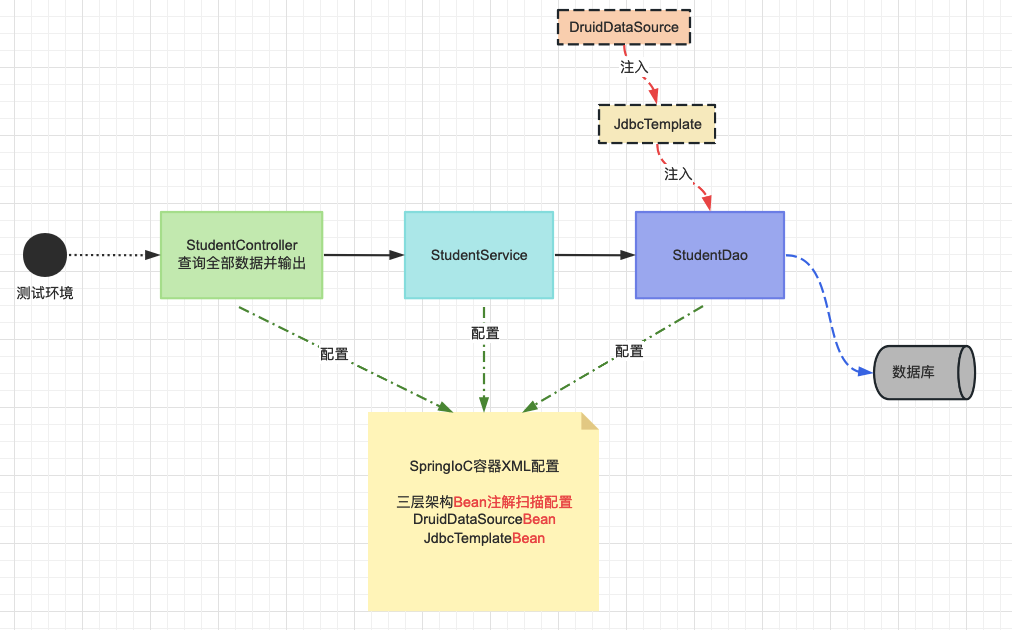
-
数据库准备
create database studb; use studb; CREATE TABLE students ( id INT PRIMARY KEY, name VARCHAR(50) NOT NULL, gender VARCHAR(10) NOT NULL, age INT, class VARCHAR(50) ); INSERT INTO students (id, name, gender, age, class) VALUES (1, '张三', '男', 20, '高中一班'), (2, '李四', '男', 19, '高中二班'), (3, '王五', '女', 18, '高中一班'), (4, '赵六', '女', 20, '高中三班'), (5, '刘七', '男', 19, '高中二班'), (6, '陈八', '女', 18, '高中一班'), (7, '杨九', '男', 20, '高中三班'), (8, '吴十', '男', 19, '高中二班'); -
项目准备
-
项目创建
spring-annotation-practice-04
-
依赖导入
<dependencies> <!--spring context依赖--> <!--当你引入SpringContext依赖之后,表示将Spring的基础依赖引入了--> <dependency> <groupId>org.springframework</groupId> <artifactId>spring-context</artifactId> <version>6.0.6</version> </dependency> <!-- 数据库驱动和连接池--> <dependency> <groupId>mysql</groupId> <artifactId>mysql-connector-java</artifactId> <version>8.0.25</version> </dependency> <dependency> <groupId>com.alibaba</groupId> <artifactId>druid</artifactId> <version>1.2.8</version> </dependency> <dependency> <groupId>jakarta.annotation</groupId> <artifactId>jakarta.annotation-api</artifactId> <version>2.1.1</version> </dependency> <!-- spring-jdbc --> <dependency> <groupId>org.springframework</groupId> <artifactId>spring-jdbc</artifactId> <version>6.0.6</version> </dependency> </dependencies> -
实体类准备
public class Student { private Integer id; private String name; private String gender; private Integer age; private String classes; public Integer getId() { return id; } public void setId(Integer id) { this.id = id; } public String getName() { return name; } public void setName(String name) { this.name = name; } public String getGender() { return gender; } public void setGender(String gender) { this.gender = gender; } public Integer getAge() { return age; } public void setAge(Integer age) { this.age = age; } public String getClasses() { return classes; } public void setClasses(String classes) { this.classes = classes; } @Override public String toString() { return "Student{" + "id=" + id + ", name='" + name + '\'' + ", gender='" + gender + '\'' + ", age=" + age + ", classes='" + classes + '\'' + '}'; } }
-
-
三层架构搭建和实现
- 持久层
//接口 public interface StudentDao { /** * 查询全部学生数据 * @return */ List<Student> queryAll(); } //实现类 @Repository public class StudentDaoImpl implements StudentDao { @Autowired private JdbcTemplate jdbcTemplate; /** * 查询全部学生数据 * @return */ @Override public List<Student> queryAll() { String sql = "select id , name , age , gender , class as classes from students ;"; /* query可以返回集合! BeanPropertyRowMapper就是封装好RowMapper的实现,要求属性名和列名相同即可 */ List<Student> studentList = jdbcTemplate.query(sql, new BeanPropertyRowMapper<>(Student.class)); return studentList; } } - 业务层
//接口 public interface StudentService { /** * 查询全部学员业务 * @return */ List<Student> findAll(); } //实现类 @Service public class StudentServiceImpl implements StudentService { @Autowired private StudentDao studentDao; /** * 查询全部学员业务 * @return */ @Override public List<Student> findAll() { List<Student> studentList = studentDao.queryAll(); return studentList; } } - 表述层
@Controller public class StudentController { @Autowired private StudentService studentService; public void findAll(){ List<Student> studentList = studentService.findAll(); System.out.println("studentList = " + studentList); } }
- 持久层
-
三层架构IoC配置
<?xml version="1.0" encoding="UTF-8"?> <beans xmlns="http://www.springframework.org/schema/beans" xmlns:xsi="http://www.w3.org/2001/XMLSchema-instance" xmlns:context="http://www.springframework.org/schema/context" xsi:schemaLocation="http://www.springframework.org/schema/beans http://www.springframework.org/schema/beans/spring-beans.xsd http://www.springframework.org/schema/context https://www.springframework.org/schema/context/spring-context.xsd"> <!-- 导入外部属性文件 --> <context:property-placeholder location="classpath:jdbc.properties" /> <!-- 配置数据源 --> <bean id="druidDataSource" class="com.alibaba.druid.pool.DruidDataSource"> <property name="url" value="${atguigu.url}"/> <property name="driverClassName" value="${atguigu.driver}"/> <property name="username" value="${atguigu.username}"/> <property name="password" value="${atguigu.password}"/> </bean> <bean class="org.springframework.jdbc.core.JdbcTemplate"> <property name="dataSource" ref="druidDataSource" /> </bean> <!-- 扫描Ioc/DI注解 --> <context:component-scan base-package="com.atguigu.dao,com.atguigu.service,com.atguigu.controller" /> </beans> -
运行测试
public class ControllerTest { @Test public void testRun(){ ApplicationContext applicationContext = new ClassPathXmlApplicationContext("spring-ioc.xml"); StudentController studentController = applicationContext.getBean(StudentController.class); studentController.findAll(); } } -
注解+XML IoC方式问题总结
- 自定义类可以使用注解方式,但是第三方依赖的类依然使用XML方式!
- XML格式解析效率低!
4.4 基于 配置类 方式管理 Bean
4.4.1 完全注解开发理解
Spring 完全注解配置(Fully Annotation-based Configuration)是指通过 Java配置类 代码来配置 Spring 应用程序,使用注解来替代原本在 XML 配置文件中的配置。相对于 XML 配置,完全注解配置具有更强的类型安全性和更好的可读性。
两种方式思维转化:
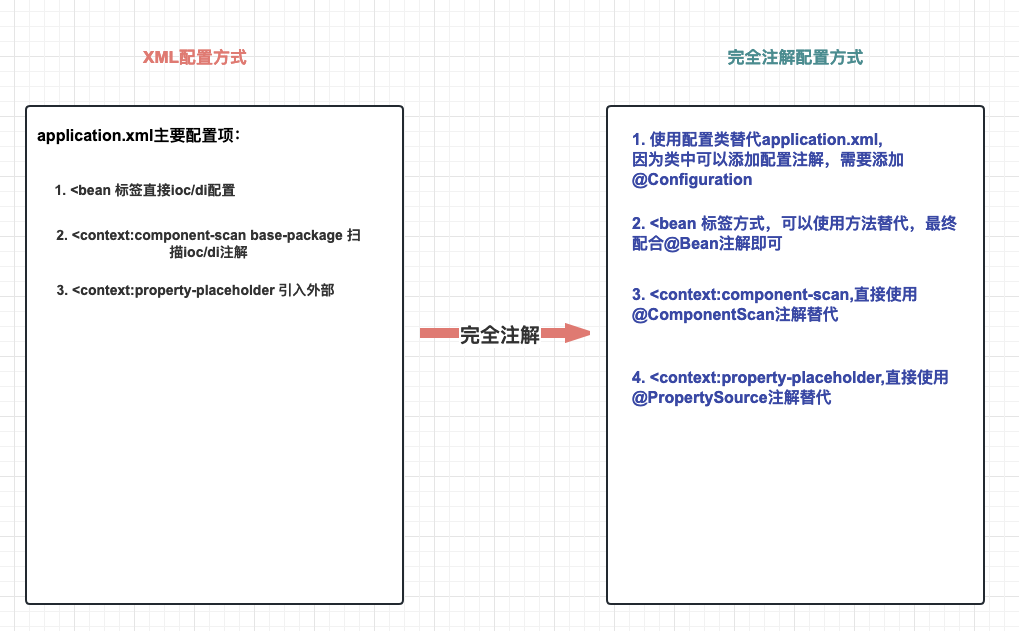
4.4.2 实验一:配置类和扫描注解
xml+注解方式
配置文件application.xml
<?xml version="1.0" encoding="UTF-8"?>
<beans xmlns="http://www.springframework.org/schema/beans"
xmlns:xsi="http://www.w3.org/2001/XMLSchema-instance"
xmlns:context="http://www.springframework.org/schema/context"
xsi:schemaLocation="http://www.springframework.org/schema/beans http://www.springframework.org/schema/beans/spring-beans.xsd http://www.springframework.org/schema/context https://www.springframework.org/schema/context/spring-context.xsd">
<!-- 配置自动扫描的包 -->
<!-- 1.包要精准,提高性能!
2.会扫描指定的包和子包内容
3.多个包可以使用,分割 例如: com.atguigu.controller,com.atguigu.service等
-->
<context:component-scan base-package="com.atguigu.components"/>
<!-- 引入外部配置文件-->
<context:property-placeholder location="application.properties" />
</beans>
测试创建IoC容器
// xml方式配置文件使用ClassPathXmlApplicationContext容器读取
ApplicationContext applicationContext =
new ClassPathXmlApplicationContext("application.xml");
配置类+注解方式(完全注解方式)
配置类
使用 @Configuration 注解将一个普通的类标记为 Spring 的配置类。
import org.springframework.context.annotation.ComponentScan;
import org.springframework.context.annotation.Configuration;
import org.springframework.context.annotation.PropertySource;
//标注当前类是配置类,替代application.xml
@Configuration
//使用注解读取外部配置,替代 <context:property-placeholder标签
@PropertySource("classpath:application.properties")
//使用@ComponentScan注解,可以配置扫描包,替代<context:component-scan标签
@ComponentScan(basePackages = {"com.atguigu.components"})
public class MyConfiguration {
}
测试创建IoC容器
// AnnotationConfigApplicationContext 根据配置类创建 IOC 容器对象
ApplicationContext iocContainerAnnotation =
new AnnotationConfigApplicationContext(MyConfiguration.class);
可以使用 no-arg 构造函数实例化 AnnotationConfigApplicationContext ,然后使用 register() 方法对其进行配置。此方法在以编程方式生成 AnnotationConfigApplicationContext 时特别有用。以下示例演示如何执行此操作:
// AnnotationConfigApplicationContext-IOC容器对象
ApplicationContext iocContainerAnnotation =
new AnnotationConfigApplicationContext();
//外部设置配置类
iocContainerAnnotation.register(MyConfiguration.class);
//刷新后方可生效!!
iocContainerAnnotation.refresh();
总结:
@Configuration指定一个类为配置类,可以添加配置注解,替代配置xml文件
@ComponentScan(basePackages = {“包”,“包”}) 替代<context:component-scan标签实现注解扫描
@PropertySource(“classpath:配置文件地址”) 替代 <context:property-placeholder标签
配合IoC/DI注解,可以进行完整注解开发!
4.4.3 实验二:@Bean定义组件
场景需求:将Druid连接池对象存储到IoC容器
需求分析:第三方jar包的类,添加到ioc容器,无法使用@Component等相关注解!因为源码jar包内容为只读模式!
xml方式实现:
<?xml version="1.0" encoding="UTF-8"?>
<beans xmlns="http://www.springframework.org/schema/beans"
xmlns:xsi="http://www.w3.org/2001/XMLSchema-instance"
xmlns:context="http://www.springframework.org/schema/context"
xsi:schemaLocation="http://www.springframework.org/schema/beans http://www.springframework.org/schema/beans/spring-beans.xsd http://www.springframework.org/schema/context https://www.springframework.org/schema/context/spring-context.xsd">
<!-- 引入外部属性文件 -->
<context:property-placeholder location="classpath:jdbc.properties"/>
<!-- 实验六 [重要]给bean的属性赋值:引入外部属性文件 -->
<bean id="druidDataSource" class="com.alibaba.druid.pool.DruidDataSource">
<property name="url" value="${jdbc.url}"/>
<property name="driverClassName" value="${jdbc.driver}"/>
<property name="username" value="${jdbc.user}"/>
<property name="password" value="${jdbc.password}"/>
</bean>
</beans>
配置类方式实现:
@Bean 注释用于指示方法实例化、配置和初始化要由 Spring IoC 容器管理的新对象。对于那些熟悉 Spring 的 <beans/> XML 配置的人来说, @Bean 注释与 <bean/> 元素起着相同的作用。
//标注当前类是配置类,替代application.xml
@Configuration
//引入jdbc.properties文件
@PropertySource({"classpath:application.properties","classpath:jdbc.properties"})
@ComponentScan(basePackages = {"com.atguigu.components"})
public class MyConfiguration {
//如果第三方类进行IoC管理,无法直接使用@Component相关注解
//解决方案: xml方式可以使用<bean标签
//解决方案: 配置类方式,可以使用方法返回值+@Bean注解
@Bean
public DataSource createDataSource(@Value("${jdbc.user}") String username,
@Value("${jdbc.password}")String password,
@Value("${jdbc.url}")String url,
@Value("${jdbc.driver}")String driverClassName){
//使用Java代码实例化
DruidDataSource dataSource = new DruidDataSource();
dataSource.setUsername(username);
dataSource.setPassword(password);
dataSource.setUrl(url);
dataSource.setDriverClassName(driverClassName);
//返回结果即可
return dataSource;
}
}
4.4.4 实验三:高级特性:@Bean注解细节
-
@Bean生成BeanName问题
@Bean注解源码:
public @interface Bean { //前两个注解可以指定Bean的标识 @AliasFor("name") String[] value() default {}; @AliasFor("value") String[] name() default {}; //autowireCandidate 属性来指示该 Bean 是否候选用于自动装配。 //autowireCandidate 属性默认值为 true,表示该 Bean 是一个默认的装配目标, //可被候选用于自动装配。如果将 autowireCandidate 属性设置为 false,则说明该 Bean 不是默认的装配目标,不会被候选用于自动装配。 boolean autowireCandidate() default true; //指定初始化方法 String initMethod() default ""; //指定销毁方法 String destroyMethod() default "(inferred)"; }指定@Bean的名称:
@Configuration public class AppConfig { @Bean("myThing") //指定名称 public Thing thing() { return new Thing(); } }@Bean注释注释方法。使用此方法在指定为方法返回值的类型的ApplicationContext中注册 Bean 定义。缺省情况下,Bean 名称与方法名称相同。下面的示例演示@Bean方法声明:@Configuration public class AppConfig { @Bean public TransferServiceImpl transferService() { return new TransferServiceImpl(); } }前面的配置完全等同于下面的Spring XML:
<beans> <bean id="transferService" class="com.acme.TransferServiceImpl"/> </beans> -
@Bean 初始化和销毁方法指定
@Bean注解支持指定任意初始化和销毁回调方法,非常类似于 Spring XML 在bean元素上的init-method和destroy-method属性,如以下示例所示:public class BeanOne { public void init() { // initialization logic } } public class BeanTwo { public void cleanup() { // destruction logic } } @Configuration public class AppConfig { @Bean(initMethod = "init") public BeanOne beanOne() { return new BeanOne(); } @Bean(destroyMethod = "cleanup") public BeanTwo beanTwo() { return new BeanTwo(); } } -
@Bean Scope作用域
可以指定使用
@Bean注释定义的 bean 应具有特定范围。您可以使用在 Bean 作用域部分中指定的任何标准作用域。默认作用域为
singleton,但您可以使用@Scope注释覆盖此范围,如以下示例所示:@Configuration public class MyConfiguration { @Bean @Scope("prototype") public Encryptor encryptor() { // ... } } -
@Bean方法之间依赖
准备组件
public class HappyMachine { private String machineName; public String getMachineName() { return machineName; } public void setMachineName(String machineName) { this.machineName = machineName; } }public class HappyComponent { //引用新组件 private HappyMachine happyMachine; public HappyMachine getHappyMachine() { return happyMachine; } public void setHappyMachine(HappyMachine happyMachine) { this.happyMachine = happyMachine; } public void doWork() { System.out.println("HappyComponent.doWork"); } }Java配置类实现:
方案1:
直接调用方法返回 Bean 实例:在一个
@Bean方法中直接调用其他@Bean方法来获取 Bean 实例,虽然是方法调用,也是通过IoC容器获取对应的Bean,例如:@Configuration public class JavaConfig { @Bean public HappyMachine happyMachine(){ return new HappyMachine(); } @Bean public HappyComponent happyComponent(){ HappyComponent happyComponent = new HappyComponent(); //直接调用方法即可! happyComponent.setHappyMachine(happyMachine()); return happyComponent; } }方案2:
参数引用法:通过方法参数传递 Bean 实例的引用来解决 Bean 实例之间的依赖关系,例如:
package com.atguigu.config; import com.atguigu.ioc.HappyComponent; import com.atguigu.ioc.HappyMachine; import org.springframework.context.annotation.Bean; import org.springframework.context.annotation.Configuration; /** * projectName: com.atguigu.config * description: 配置HappyComponent和HappyMachine关系 */ @Configuration public class JavaConfig { @Bean public HappyMachine happyMachine(){ return new HappyMachine(); } /** * 可以直接在形参列表接收IoC容器中的Bean! * 情况1: 直接指定类型即可 * 情况2: 如果有多个bean,(HappyMachine 名称 ) 形参名称等于要指定的bean名称! * 例如: * @Bean * public Foo foo1(){ * return new Foo(); * } * @Bean * public Foo foo2(){ * return new Foo() * } * @Bean * public Component component(Foo foo1 / foo2 通过此处指定引入的bean) */ @Bean public HappyComponent happyComponent(HappyMachine happyMachine){ HappyComponent happyComponent = new HappyComponent(); //赋值 happyComponent.setHappyMachine(happyMachine); return happyComponent; } }
4.4.5 实验四:高级特性:@Import扩展
@Import 注释允许从另一个配置类加载 @Bean 定义,如以下示例所示:
@Configuration
public class ConfigA {
@Bean
public A a() {
return new A();
}
}
@Configuration
@Import(ConfigA.class)
public class ConfigB {
@Bean
public B b() {
return new B();
}
}
现在,在实例化上下文时不需要同时指定 ConfigA.class 和 ConfigB.class ,只需显式提供 ConfigB ,如以下示例所示:
public static void main(String[] args) {
ApplicationContext ctx = new AnnotationConfigApplicationContext(ConfigB.class);
// now both beans A and B will be available...
A a = ctx.getBean(A.class);
B b = ctx.getBean(B.class);
}
此方法简化了容器实例化,因为只需要处理一个类,而不是要求您在构造期间记住可能大量的 @Configuration 类。
4.4.6 实验五:基于注解+配置类方式整合三层架构组件
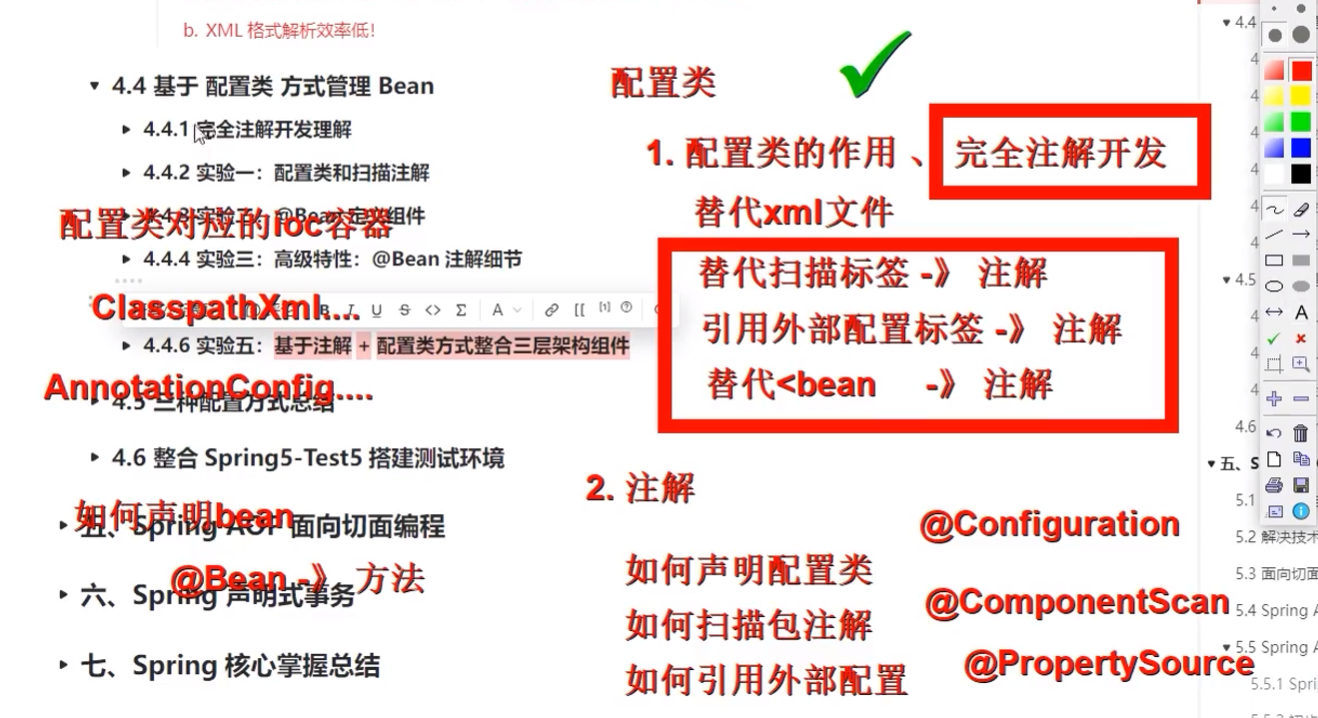
-
需求分析
搭建一个三层架构案例,模拟查询全部学生(学生表)信息,持久层使用JdbcTemplate和Druid技术,使用注解+配置类方式进行组件管理!
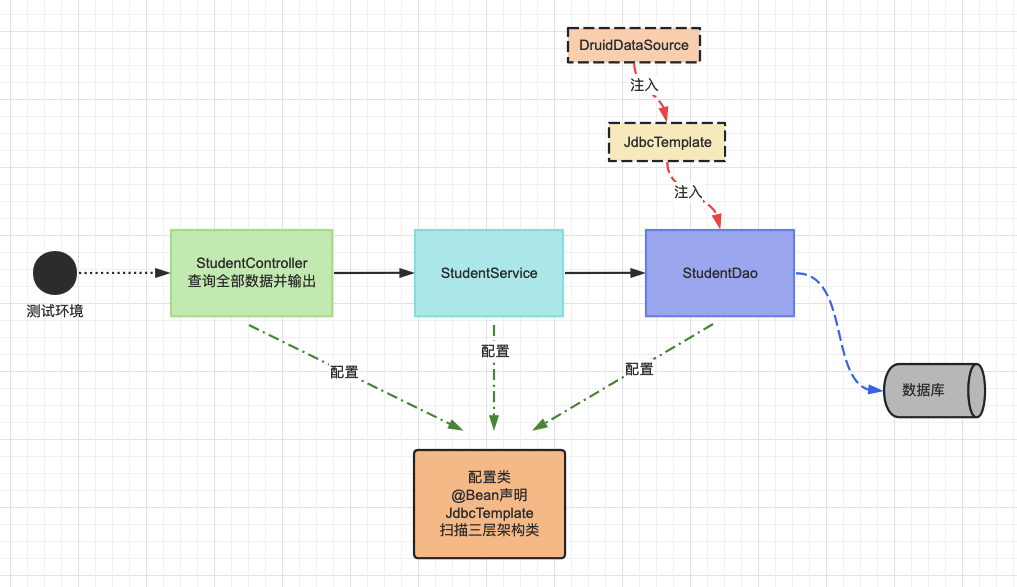
-
数据库准备
create database studb; use studb; CREATE TABLE students ( id INT PRIMARY KEY, name VARCHAR(50) NOT NULL, gender VARCHAR(10) NOT NULL, age INT, class VARCHAR(50) ); INSERT INTO students (id, name, gender, age, class) VALUES (1, '张三', '男', 20, '高中一班'), (2, '李四', '男', 19, '高中二班'), (3, '王五', '女', 18, '高中一班'), (4, '赵六', '女', 20, '高中三班'), (5, '刘七', '男', 19, '高中二班'), (6, '陈八', '女', 18, '高中一班'), (7, '杨九', '男', 20, '高中三班'), (8, '吴十', '男', 19, '高中二班'); -
项目准备
-
项目创建
spring-java-practice-06
-
依赖导入
<dependencies> <!--spring context依赖--> <!--当你引入SpringContext依赖之后,表示将Spring的基础依赖引入了--> <dependency> <groupId>org.springframework</groupId> <artifactId>spring-context</artifactId> <version>6.0.6</version> </dependency> <!-- 数据库驱动和连接池--> <dependency> <groupId>mysql</groupId> <artifactId>mysql-connector-java</artifactId> <version>8.0.25</version> </dependency> <dependency> <groupId>com.alibaba</groupId> <artifactId>druid</artifactId> <version>1.2.8</version> </dependency> <dependency> <groupId>jakarta.annotation</groupId> <artifactId>jakarta.annotation-api</artifactId> <version>2.1.1</version> </dependency> <!-- spring-jdbc --> <dependency> <groupId>org.springframework</groupId> <artifactId>spring-jdbc</artifactId> <version>6.0.6</version> </dependency> </dependencies> -
实体类准备
public class Student { private Integer id; private String name; private String gender; private Integer age; private String classes; public Integer getId() { return id; } public void setId(Integer id) { this.id = id; } public String getName() { return name; } public void setName(String name) { this.name = name; } public String getGender() { return gender; } public void setGender(String gender) { this.gender = gender; } public Integer getAge() { return age; } public void setAge(Integer age) { this.age = age; } public String getClasses() { return classes; } public void setClasses(String classes) { this.classes = classes; } @Override public String toString() { return "Student{" + "id=" + id + ", name='" + name + '\'' + ", gender='" + gender + '\'' + ", age=" + age + ", classes='" + classes + '\'' + '}'; } }
-
-
三层架构搭建和实现
- 持久层
//接口 public interface StudentDao { /** * 查询全部学生数据 * @return */ List<Student> queryAll(); } //实现类 @Repository public class StudentDaoImpl implements StudentDao { @Autowired private JdbcTemplate jdbcTemplate; /** * 查询全部学生数据 * @return */ @Override public List<Student> queryAll() { String sql = "select id , name , age , gender , class as classes from students ;"; /* query可以返回集合! BeanPropertyRowMapper就是封装好RowMapper的实现,要求属性名和列名相同即可 */ List<Student> studentList = jdbcTemplate.query(sql, new BeanPropertyRowMapper<>(Student.class)); return studentList; } } - 业务层
//接口 public interface StudentService { /** * 查询全部学员业务 * @return */ List<Student> findAll(); } //实现类 @Service public class StudentServiceImpl implements StudentService { @Autowired private StudentDao studentDao; /** * 查询全部学员业务 * @return */ @Override public List<Student> findAll() { List<Student> studentList = studentDao.queryAll(); return studentList; } } - 表述层
@Controller public class StudentController { @Autowired private StudentService studentService; public void findAll(){ List<Student> studentList = studentService.findAll(); System.out.println("studentList = " + studentList); } }
- 持久层
-
三层架构IoC配置类
@Configuration @ComponentScan(basePackages = "com.atguigu") @PropertySource("classpath:jdbc.properties") public class JavaConfig { @Value("${atguigu.url}") private String url; @Value("${atguigu.driver}") private String driver; @Value("${atguigu.username}") private String username; @Value("${atguigu.password}") private String password; @Bean(destroyMethod = "close") public DruidDataSource dataSource(){ DruidDataSource dataSource = new DruidDataSource(); dataSource.setUrl(url); dataSource.setDriverClassName(driver); dataSource.setUsername(username); dataSource.setPassword(password); return dataSource; } @Scope(ConfigurableBeanFactory.SCOPE_PROTOTYPE) @Bean public JdbcTemplate jdbcTemplate(DataSource dataSource){ JdbcTemplate jdbcTemplate = new JdbcTemplate(); jdbcTemplate.setDataSource(dataSource); return jdbcTemplate; } } -
运行测试
public class ControllerTest { @Test public void testRun(){ AnnotationConfigApplicationContext applicationContext = new AnnotationConfigApplicationContext(JavaConfig.class); StudentController studentController = applicationContext.getBean(StudentController.class); studentController.findAll(); } } -
注解+配置类 IoC方式总结
- 完全摒弃了XML配置文件
- 自定义类使用IoC和DI注解标记
- 第三方类使用配置类声明方法+@Bean方式处理
- 完全注解方式(配置类+注解)是现在主流配置方式
4.5 三种配置方式总结
4.5.1 XML方式配置总结
- 所有内容写到xml格式配置文件中
- 声明bean通过<bean标签
- <bean标签包含基本信息(id,class)和属性信息 <property name value / ref
- 引入外部的properties文件可以通过<context:property-placeholder
- IoC具体容器实现选择ClassPathXmlApplicationContext对象
4.5.2 XML+注解方式配置总结
- 注解负责标记IoC的类和进行属性装配
- xml文件依然需要,需要通过<context:component-scan标签指定注解范围
- 标记IoC注解:@Component,@Service,@Controller,@Repository
- 标记DI注解:@Autowired @Qualifier @Resource @Value
- IoC具体容器实现选择ClassPathXmlApplicationContext对象
4.5.3 完全注解方式配置总结
- 完全注解方式指的是去掉xml文件,使用配置类 + 注解实现
- xml文件替换成使用@Configuration注解标记的类
- 标记IoC注解:@Component,@Service,@Controller,@Repository
- 标记DI注解:@Autowired @Qualifier @Resource @Value
- <context:component-scan标签指定注解范围使用@ComponentScan(basePackages = {“com.atguigu.components”})替代
- <context:property-placeholder引入外部配置文件使用@PropertySource({“classpath:application.properties”,“classpath:jdbc.properties”})替代
- <bean 标签使用@Bean注解和方法实现
- IoC具体容器实现选择AnnotationConfigApplicationContext对象
4.6 整合Spring5-Test5搭建测试环境
-
整合测试环境作用
好处1:不需要自己创建IOC容器对象了
好处2:任何需要的bean都可以在测试类中直接享受自动装配
-
导入相关依赖
<!--junit5测试--> <dependency> <groupId>org.junit.jupiter</groupId> <artifactId>junit-jupiter-api</artifactId> <version>5.3.1</version> </dependency> <dependency> <groupId>org.springframework</groupId> <artifactId>spring-test</artifactId> <version>6.0.6</version> <scope>test</scope> </dependency> -
整合测试注解使用
//@SpringJUnitConfig(locations = {"classpath:spring-context.xml"}) //指定配置文件xml @SpringJUnitConfig(value = {BeanConfig.class}) //指定配置类 public class Junit5IntegrationTest { @Autowired private User user; @Test public void testJunit5() { System.out.println(user); } }
汇总回顾

package com.atguigu.config;
import com.alibaba.druid.pool.DruidDataSource;
import org.springframework.beans.factory.annotation.Value;
import org.springframework.beans.factory.config.ConfigurableBeanFactory;
import org.springframework.context.annotation.*;
import org.springframework.jdbc.core.JdbcTemplate;
import javax.sql.DataSource;
/**
* projectName: com.atguigu.config
*
* @author: 赵伟风
* description: java的配置类,替代xml配置文件
* 1.包扫描注解配置 @ComponentScan({"com.atguigu.ioc_01","com.atguigu.ioc_02"})
* 2.引用外部的配置文件
* 3.声明第三方依赖的bean组件
*
* 步骤1: 添加 @Configuration 代表我们是配置类
* 步骤2: 实现上面的三个功能注解
*
*/
@ComponentScan({"com.atguigu.ioc_01","com.atguigu.ioc_04"})
@PropertySource("classpath:jdbc.properties")
@Configuration
public class JavaConfiguration {
@Value("${atguigu.url}")
private String url;
@Value("${atguigu.driver}")
private String driver;
@Value("${atguigu.username}")
private String username;
@Value("${atguigu.password}")
private String password;
/**
*
* <bean -》 一个方法
*
* 方法的返回值类型 == bean组件的类型或者他的接口和父类
* 方法的名字 = bean id
*
* 方法体可以自定义实现过程即可!
* 最重要一步: @Bean 会真正让配置类的方法创建的组件存储到ioc容器!!
*
*
* 问题1: beanName的问题
* 默认: 方法名
* 指定: name / value属性起名字,覆盖方法名
* 问题2: 周期方法如何指定
* 原有注解方案: PostConstruct + PreDestroy 注解指定
* bean属性指定: initMethod / destroyMethod指定
* 问题3: 作用域
* 和以前还是一样@Scope注解,默认是单例
*
* 问题4: 如何引用其他的ioc组件
* 直接调用对方的bean方法即可
* 直接形参变量进行引入,要求必须有对应的组件,如果有多个,形参名 = 组件id标识即可
*/
//@Scope(scopeName = ConfigurableBeanFactory.SCOPE_SINGLETON)
@Bean(name = "ergouzi")
public DruidDataSource dataSource1(){
//实现具体的实例化过程
DruidDataSource dataSource = new DruidDataSource();
dataSource.setUrl(url);
dataSource.setDriverClassName(driver);
dataSource.setUsername(username);
dataSource.setPassword(password);
return dataSource;
}
@Bean(name = "lvdandan")
public DruidDataSource dataSource2(){
//实现具体的实例化过程
DruidDataSource dataSource = new DruidDataSource();
dataSource.setUrl(url);
dataSource.setDriverClassName(driver);
dataSource.setUsername(username);
dataSource.setPassword(password);
return dataSource;
}
//JdbcTemplate -> DataSource
@Bean
public JdbcTemplate jdbcTemplate(){
JdbcTemplate jdbcTemplate = new JdbcTemplate();
//需要DataSource 需要ioc容器的其他组件
//方案1: 如果其他组件也是@Bean方法,可以直接调用 | 从ioc容器获取组件
jdbcTemplate.setDataSource(dataSource1());
return jdbcTemplate;
}
@Bean
public JdbcTemplate jdbcTemplate1(DataSource lvdandan,DataSource ergouzi){
JdbcTemplate jdbcTemplate = new JdbcTemplate();
//需要DataSource 需要ioc容器的其他组件
//方案2: 形参列表声明想要的组件类型,可以是一个也可以是多个! ioc容器也会注入
//如果没有:形参变量注入。要求必须有对应的类型的组件,如果没有抛异常!
//如果有多个:可以使用形参名称等同于对应的beanid标识即可
jdbcTemplate.setDataSource(lvdandan);
return jdbcTemplate;
}
}
配置类就是代替xml,实现完全注解开发
测试
package com.atguigu.test;
import com.atguigu.config.JavaConfiguration;
import com.atguigu.config.JavaConfigurationA;
import com.atguigu.config.JavaConfigurationB;
import com.atguigu.ioc_01.StudentController;
import org.junit.jupiter.api.Test;
import org.springframework.context.ApplicationContext;
import org.springframework.context.annotation.AnnotationConfigApplicationContext;
/**
* projectName: com.atguigu.test
*
* @author: 赵伟风
* description:
*/
public class SpringIoCTest {
@Test
public void test(){
//1.创建ioc容器
ApplicationContext applicationContext
= new AnnotationConfigApplicationContext(JavaConfiguration.class);
AnnotationConfigApplicationContext applicationContext1 = new AnnotationConfigApplicationContext();
applicationContext1.register(JavaConfiguration.class);
applicationContext1.refresh(); //ioc di
//2.获取bean
StudentController bean = applicationContext.getBean(StudentController.class);
System.out.println("bean = " + bean);
}
@Test
public void test_04(){
ApplicationContext applicationContext
= new AnnotationConfigApplicationContext(JavaConfigurationA.class);
}
}
配置类的整合
package com.jovey.config;
import org.springframework.context.annotation.Configuration;
/**
* projectName: com.atguigu.config
*
* @author: 赵伟风
* description: 配置类
*/
@Configuration
public class JavaConfigurationB {
}
package com.jovey.config;
import org.springframework.context.annotation.Configuration;
import org.springframework.context.annotation.Import;
/**
* projectName: com.atguigu.config
*
* @author: 赵伟风
* description: 配置类
*/
@Import(value = {JavaConfigurationB.class})
@Configuration
public class JavaConfigurationA {
}
测试
@Test
public void test_04(){
ApplicationContext applicationContext
= new AnnotationConfigApplicationContext(JavaConfigurationA.class);
}
}
4.4.6 实验五:基于注解+配置类方式整合三层架构组件
先pojo层创建实体类
然后dao层,数据持久层数据
再接着是service服务层
controler控制层
properties资源配置
只不过只要用jdbc.properties这一个了,而不用再使用xml文件了
config配置类配置
package com.jovey.config;
import com.alibaba.druid.pool.DruidDataSource;
import org.springframework.beans.factory.annotation.Value;
import org.springframework.context.annotation.Bean;
import org.springframework.context.annotation.ComponentScan;
import org.springframework.context.annotation.Configuration;
import org.springframework.context.annotation.PropertySource;
import org.springframework.jdbc.core.JdbcTemplate;
import javax.sql.DataSource;
/**
* projectName: com.atguigu.config
*
* @author: 赵伟风
* description: 配置类
*/
@Configuration
@ComponentScan(basePackages = "com.jovey")
@PropertySource(value = "classpath:jdbc.properties")
public class JavaConfig {
@Bean
public DataSource dataSource(@Value("${jovey.driver}") String driver, @Value("${jovey.url}")String url,
@Value("${jovey.username}")String username, @Value("${jovey.password}")String password){
DruidDataSource dataSource = new DruidDataSource();
dataSource.setDriverClassName(driver);
dataSource.setUrl(url);
dataSource.setUsername(username);
dataSource.setPassword(password);
return dataSource;
}
@Bean
public JdbcTemplate jdbcTemplate(DataSource dataSource){
JdbcTemplate jdbcTemplate = new JdbcTemplate();
jdbcTemplate.setDataSource(dataSource);
return jdbcTemplate;
}
}
然后测试Test
五、Spring AOP面向切面编程
5.1 场景设定和问题复现
-
准备AOP项目
项目名:spring-aop-annotation
pom.xml
<dependencies> <!--spring context依赖--> <!--当你引入Spring Context依赖之后,表示将Spring的基础依赖引入了--> <dependency> <groupId>org.springframework</groupId> <artifactId>spring-context</artifactId> <version>6.0.6</version> </dependency> <!--junit5测试--> <dependency> <groupId>org.junit.jupiter</groupId> <artifactId>junit-jupiter-api</artifactId> <version>5.3.1</version> </dependency> <dependency> <groupId>org.springframework</groupId> <artifactId>spring-test</artifactId> <version>6.0.6</version> <scope>test</scope> </dependency> <dependency> <groupId>jakarta.annotation</groupId> <artifactId>jakarta.annotation-api</artifactId> <version>2.1.1</version> </dependency> </dependencies> -
声明接口
/** * + - * / 运算的标准接口! */ public interface Calculator { int add(int i, int j); int sub(int i, int j); int mul(int i, int j); int div(int i, int j); } -
接口实现
package com.atguigu.proxy; /** * 实现计算接口,单纯添加 + - * / 实现! 掺杂其他功能! */ public class CalculatorPureImpl implements Calculator { @Override public int add(int i, int j) { int result = i + j; return result; } @Override public int sub(int i, int j) { int result = i - j; return result; } @Override public int mul(int i, int j) { int result = i * j; return result; } @Override public int div(int i, int j) { int result = i / j; return result; } } -
声明带日志接口实现
新需求: 需要在每个方法中,添加控制台输出,输出参数和输出计算后的返回值!
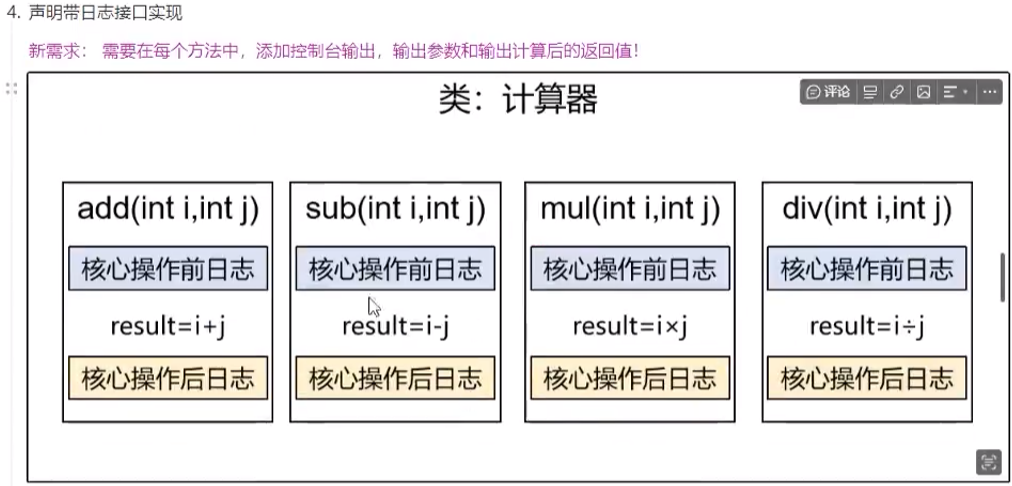
package com.atguigu.proxy; /** * 在每个方法中,输出传入的参数和计算后的返回结果! */ public class CalculatorLogImpl implements Calculator { @Override public int add(int i, int j) { System.out.println("参数是:" + i + "," + j); int result = i + j; System.out.println("方法内部 result = " + result); return result; } @Override public int sub(int i, int j) { System.out.println("参数是:" + i + "," + j); int result = i - j; System.out.println("方法内部 result = " + result); return result; } @Override public int mul(int i, int j) { System.out.println("参数是:" + i + "," + j); int result = i * j; System.out.println("方法内部 result = " + result); return result; } @Override public int div(int i, int j) { System.out.println("参数是:" + i + "," + j); int result = i / j; System.out.println("方法内部 result = " + result); return result; } } -
代码问题分析
-
代码缺陷
- 对核心业务功能有干扰,导致程序员在开发核心业务功能时分散了精力
- 附加功能代码重复,分散在各个业务功能方法中!冗余,且不方便统一维护!
-
解决思路
核心就是:解耦。我们需要把附加功能从业务功能代码中抽取出来。
将重复的代码统一提取,并且[[动态插入]]到每个业务方法!
-
技术困难
解决问题的困难:提取重复附加功能代码到一个类中,可以实现
但是如何将代码插入到各个方法中,我们不会,我们需要引用新技术!!!
-
上述代码实现思路
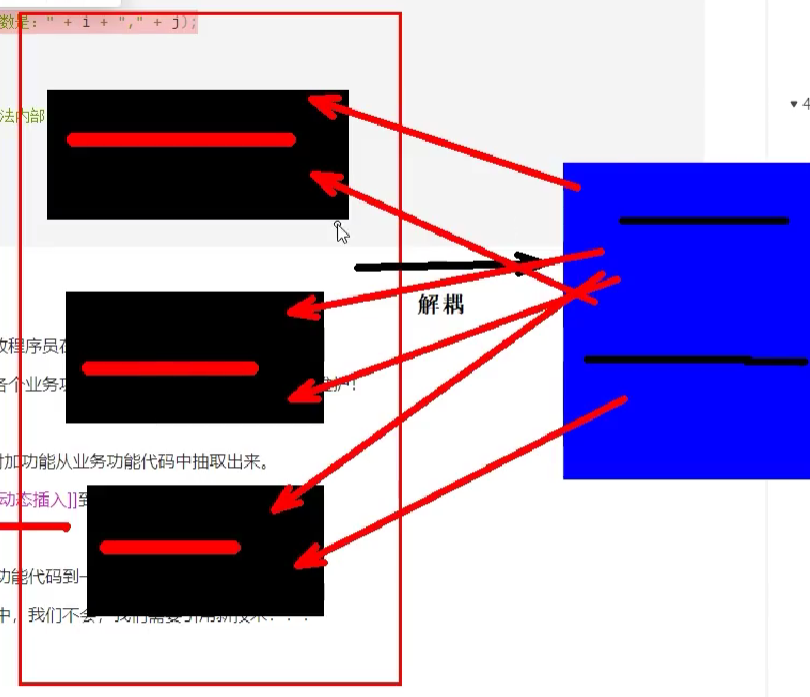
-
5.2 解决技术代理模式
-
代理模式
二十三种设计模式中的一种,属于结构型模式。它的作用就是通过提供一个代理类,让我们在调用目标方法的时候,不再是直接对目标方法进行调用,而是通过代理类间接调用。让不属于目标方法核心逻辑的代码从目标方法中剥离出来——解耦。调用目标方法时先调用代理对象的方法,减少对目标方法的调用和打扰,同时让附加功能能够集中在一起也有利于统一维护。
无代理场景:
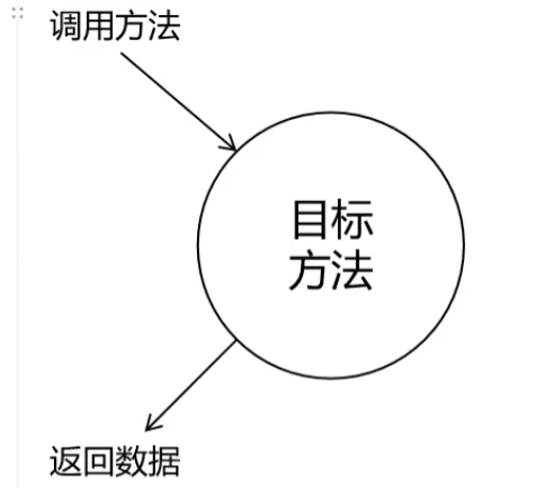
有代理场景:
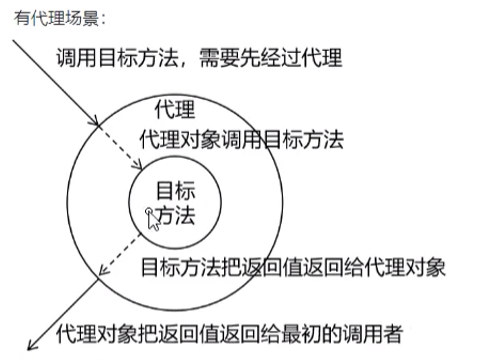

生活中的代理:
- 广告商找大明星拍广告需要经过经纪人
- 合作伙伴找大老板谈合作要约见面时间需要经过秘书
- 房产中介是买卖双方的代理
- 太监是大臣和皇上之间的代理
相关术语: - 代理:将非核心逻辑剥离出来以后,封装这些非核心逻辑的类、对象、方法。(中介)
- 动词:指做代理这个动作,或这项工作
- 名词:扮演代理这个角色的类、对象、方法
- 目标:被代理“套用”了核心逻辑代码的类、对象、方法。(房东)
代理在开发中实现的方式具体有两种:静态代理,[动态代理技术]
-
静态代理
主动创建代理类:
public class CalculatorStaticProxy implements Calculator { // 将被代理的目标对象声明为成员变量 private Calculator target; public CalculatorStaticProxy(Calculator target) { this.target = target; } @Override public int add(int i, int j) { // 附加功能由代理类中的代理方法来实现 System.out.println("参数是:" + i + "," + j); // 通过目标对象来实现核心业务逻辑 int addResult = target.add(i, j); System.out.println("方法内部 result = " + result); return addResult; } ……静态代理确实实现了解耦,但是由于代码都写死了,完全不具备任何的灵活性。就拿日志功能来说,将来其他地方也需要附加日志,那还得再声明更多个静态代理类,那就产生了大量重复的代码,日志功能还是分散的,没有统一管理。
提出进一步的需求:将日志功能集中到一个代理类中,将来有任何日志需求,都通过这一个代理类来实现。这就需要使用动态代理技术了。
-
动态代理
动态代理技术分类
- JDK动态代理:JDK原生的实现方式,需要被代理的目标类必须实现接口!他会根据目标类的接口动态生成一个代理对象!代理对象和目标对象有相同的接口!(拜把子)
- cglib:通过继承被代理的目标类实现代理,所以不需要目标类实现接口!(认干爹)
JDK动态代理技术实现(了解)
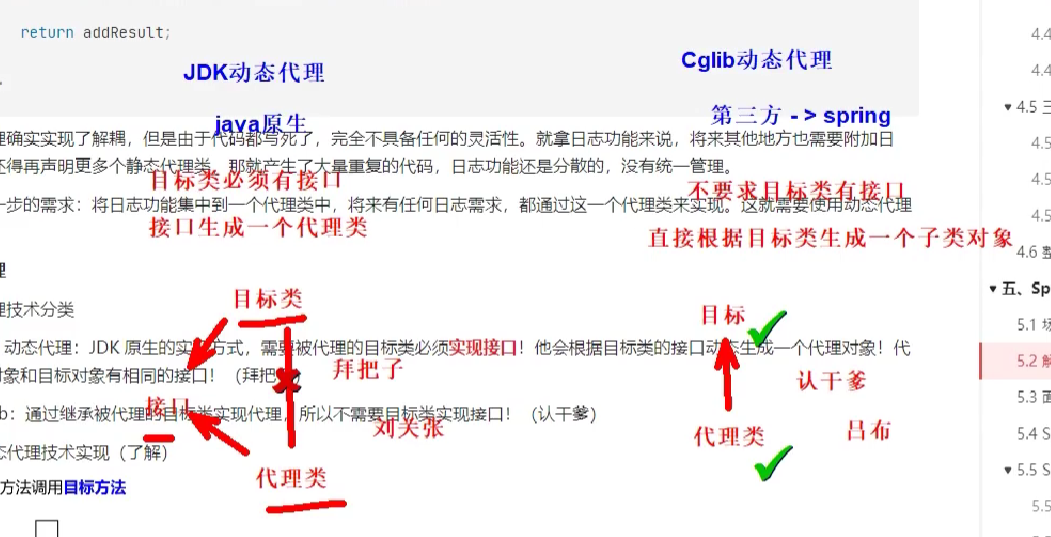
代理工程:基于jdk代理技术,生成代理对象
public class ProxyFactory { private Object target; public ProxyFactory(Object target) { this.target = target; } public Object getProxy(){ /** * newProxyInstance():创建一个代理实例 * 其中有三个参数: * 1、classLoader:加载动态生成的代理类的类加载器 * 2、interfaces:目标对象实现的所有接口的class对象所组成的数组 * 3、invocationHandler:设置代理对象实现目标对象方法的过程,即代理类中如何重写接口中的抽象方法 */ ClassLoader classLoader = target.getClass().getClassLoader(); Class<?>[] interfaces = target.getClass().getInterfaces(); InvocationHandler invocationHandler = new InvocationHandler() { @Override public Object invoke(Object proxy, Method method, Object[] args) throws Throwable { /** * proxy:代理对象 * method:代理对象需要实现的方法,即其中需要重写的方法 * args:method所对应方法的参数 */ Object result = null; try { System.out.println("[动态代理][日志] "+method.getName()+",参数:"+ Arrays.toString(args)); result = method.invoke(target, args); System.out.println("[动态代理][日志] "+method.getName()+",结果:"+ result); } catch (Exception e) { e.printStackTrace(); System.out.println("[动态代理][日志] "+method.getName()+",异常:"+e.getMessage()); } finally { System.out.println("[动态代理][日志] "+method.getName()+",方法执行完毕"); } return result; } }; return Proxy.newProxyInstance(classLoader, interfaces, invocationHandler); } }测试代码:
@Test public void testDynamicProxy(){ ProxyFactory factory = new ProxyFactory(new CalculatorLogImpl()); Calculator proxy = (Calculator) factory.getProxy(); proxy.div(1,0); //proxy.div(1,1); } -
代理总结
代理方式可以解决附加功能代码干扰核心代码和不方便统一维护的问题!
他主要是将附加功能代码提取到代理中执行,不干扰目标核心代码!
但是我们也发现,无论使用静态代理和动态代理(jdk,cglib),程序员的工作都比较繁琐!
需要自己编写代理工厂等!
但是,提前剧透,我们在实际开发中,不需要编写代理代码,我们可以使用[Spring AOP]框架,
他会简化动态代理的实现!!!
5.3 面向切面编程思维(AOP)
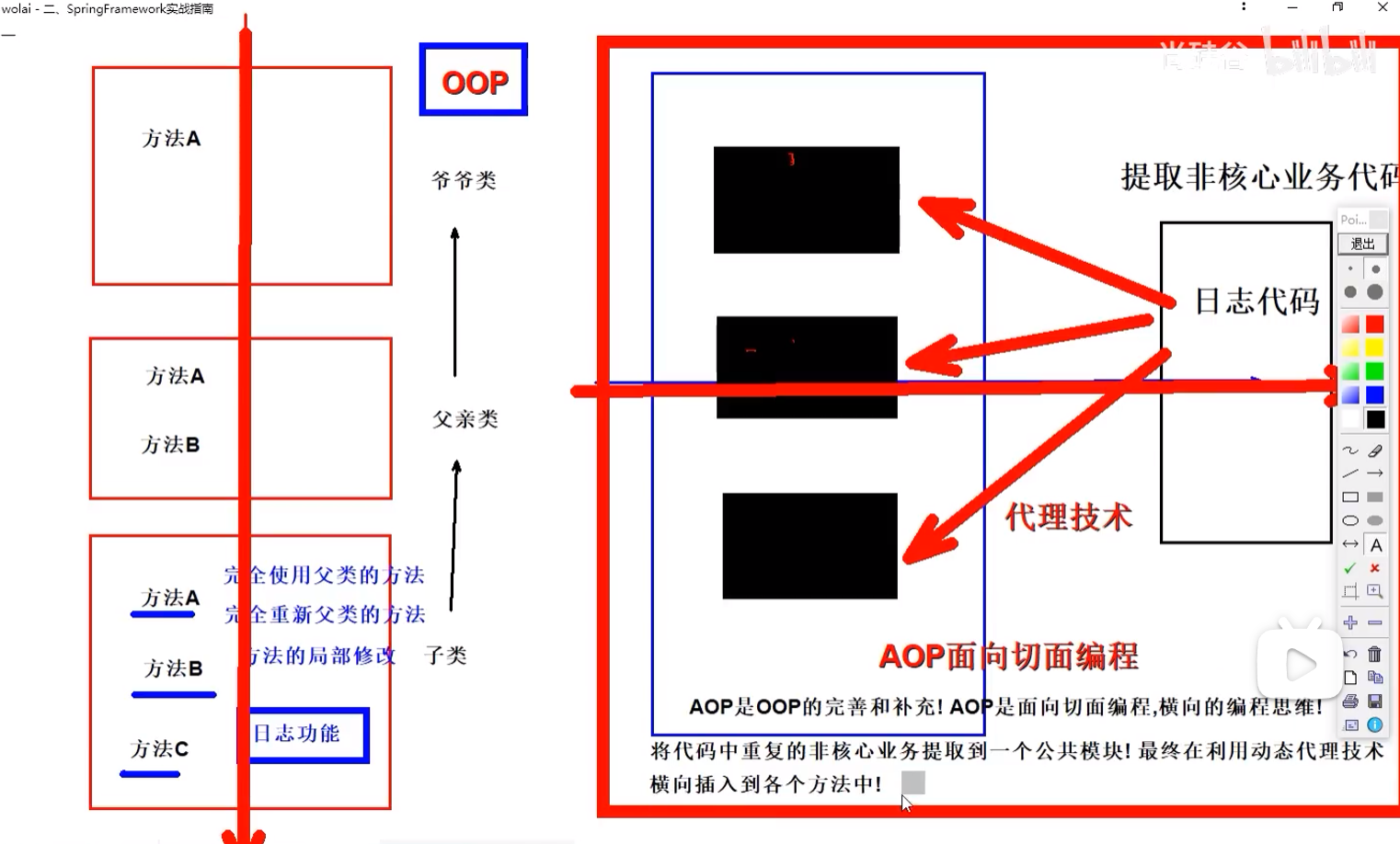
-
面向切面编程思想AOP
AOP:Aspect Oriented Programming面向切面编程
AOP可以说是OOP(Object Oriented Programming,面向对象编程)的补充和完善。OOP引入封装、继承、多态等概念来建立一种对象层次结构,用于模拟公共行为的一个集合。不过OOP允许开发者定义纵向的关系,但并不适合定义横向的关系,例如日志功能。日志代码往往横向地散布在所有对象层次中,而与它对应的对象的核心功能毫无关系对于其他类型的代码,如安全性、异常处理和透明的持续性也都是如此,这种散布在各处的无关的代码被称为横切(cross cutting),在OOP设计中,它导致了大量代码的重复,而不利于各个模块的重用。

AOP技术恰恰相反,它利用一种称为"横切"的技术,剖解开封装的对象内部,并将那些影响了多个类的公共行为封装到一个可重用模块,并将其命名为"Aspect",即切面。所谓"切面",简单说就是那些与业务无关,却为业务模块所共同调用的逻辑或责任封装起来,便于减少系统的重复代码,降低模块之间的耦合度,并有利于未来的可操作性和可维护性。
使用AOP,可以在不修改原来代码的基础上添加新功能。

-
AOP思想主要的应用场景
AOP(面向切面编程)是一种编程范式,它通过将通用的横切关注点(如日志、事务、权限控制等)与业务逻辑分离,使得代码更加清晰、简洁、易于维护。AOP可以应用于各种场景,以下是一些常见的AOP应用场景:
- 日志记录:在系统中记录日志是非常重要的,可以使用AOP来实现日志记录的功能,可以在方法执行前、执行后或异常抛出时记录日志。
- 事务处理:在数据库操作中使用事务可以保证数据的一致性,可以使用AOP来实现事务处理的功能,可以在方法开始前开启事务,在方法执行完毕后提交或回滚事务。
- 安全控制:在系统中包含某些需要安全控制的操作,如登录、修改密码、授权等,可以使用AOP来实现安全控制的功能。可以在方法执行前进行权限判断,如果用户没有权限,则抛出异常或转向到错误页面,以防止未经授权的访问。
- 性能监控:在系统运行过程中,有时需要对某些方法的性能进行监控,以找到系统的瓶颈并进行优化。可以使用AOP来实现性能监控的功能,可以在方法执行前记录时间戳,在方法执行完毕后计算方法执行时间并输出到日志中。
- 异常处理:系统中可能出现各种异常情况,如空指针异常、数据库连接异常等,可以使用AOP来实现异常处理的功能,在方法执行过程中,如果出现异常,则进行异常处理(如记录日志、发送邮件等)。
- 缓存控制:在系统中有些数据可以缓存起来以提高访问速度,可以使用AOP来实现缓存控制的功能,可以在方法执行前查询缓存中是否有数据,如果有则返回,否则执行方法并将方法返回值存入缓存中。
- 动态代理:AOP的实现方式之一是通过动态代理,可以代理某个类的所有方法,用于实现各种功能。
综上所述,AOP可以应用于各种场景,它的作用是将通用的横切关注点与业务逻辑分离,使得代码更加清晰、简洁、易于维护。
-
AOP术语名词介绍
1-横切关注点
从每个方法中抽取出来的同一类非核心业务。在同一个项目中,我们可以使用多个横切关注点对相关方法进行多个不同方面的增强。
这个概念不是语法层面天然存在的,而是根据附加功能的逻辑上的需要:有十个附加功能,就有十个横切关注点。

AOP把软件系统分为两个部分:核心关注点和横切关注点。业务处理的主要流程是核心关注点,与之关系不大的部分是横切关注点。横切关注点的一个特点是,他们经常发生在核心关注点的多处,而各处基本相似,比如权限认证、日志、事务、异常等。AOP的作用在于分离系统中的各种关注点,将核心关注点和横切关注点分离开来。
2-通知(增强)
每一个横切关注点上要做的事情都需要写一个方法来实现,这样的方法就叫通知方法。
- 前置通知:在被代理的目标方法前执行
- 返回通知:在被代理的目标方法成功结束后执行(寿终正寝)
- 异常通知:在被代理的目标方法异常结束后执行(死于非命)
- 后置通知:在被代理的目标方法最终结束后执行(盖棺定论)
- 环绕通知:使用try…catch…finally结构围绕整个被代理的目标方法,包括上面四种通知对应的所有位置
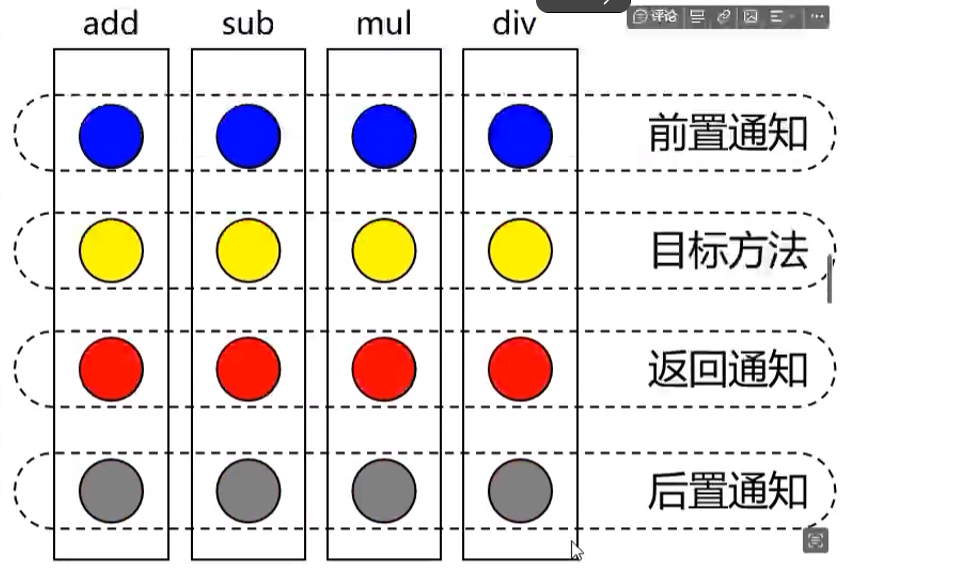
3-连接点 joinpoint
这也是一个纯逻辑概念,不是语法定义的。
指那些被拦截到的点。在 Spring 中,可以被动态代理拦截目标类的方法
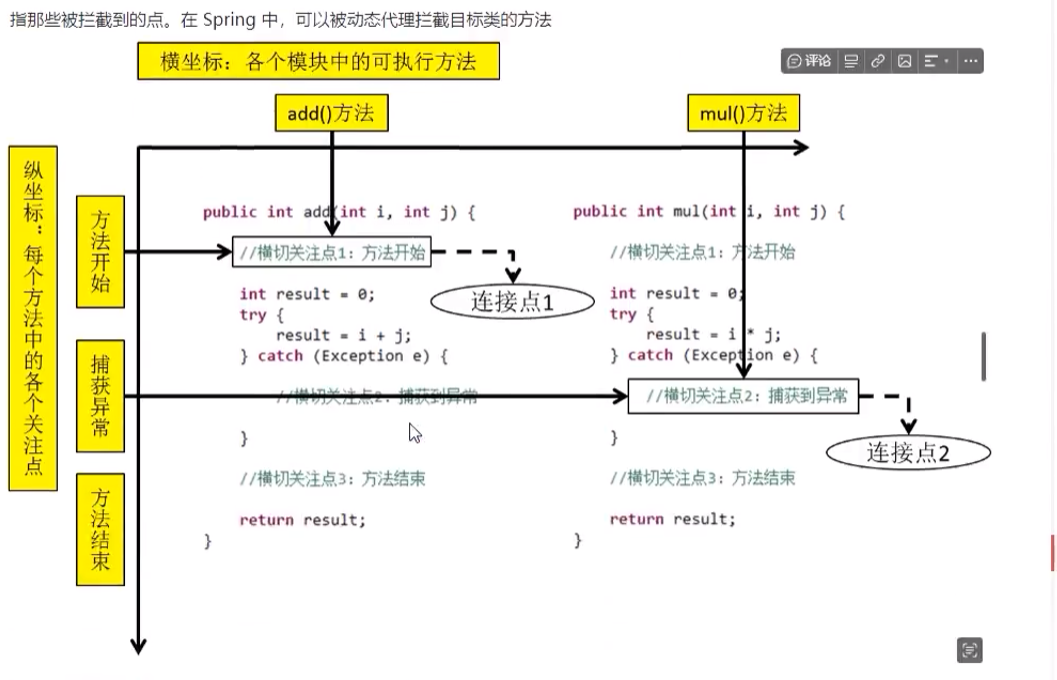
4-切入点 pointcut
定位连接点的方式,或者可以理解成被选中的连接点!
是一个表达式,比如execution(* com.spring.service.impl..(…))。符合条件的每个方法都是一个具体的连接点。
5-切面 aspect
切入点和通知的结合。是一个类。
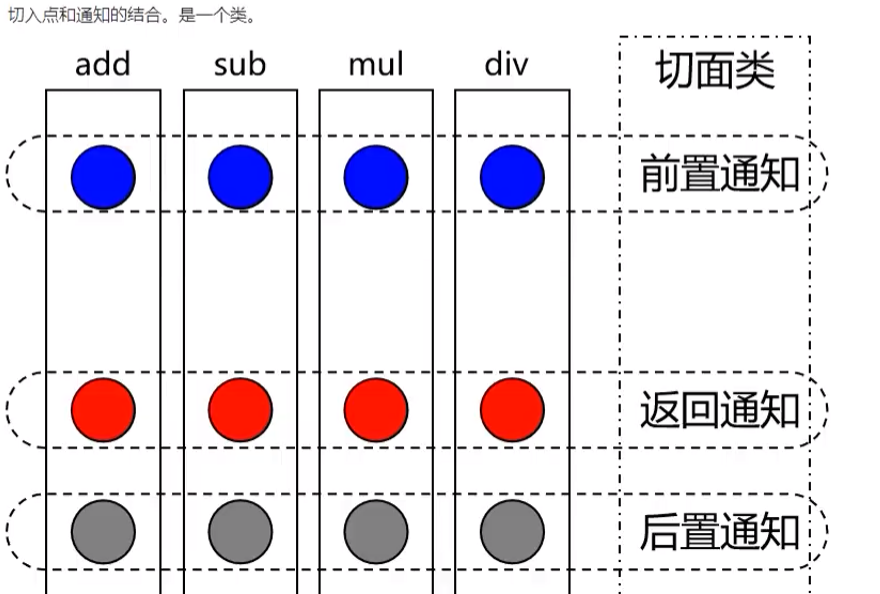
6-目标 target
被代理的目标对象。
7-代理 proxy
向目标对象应用通知之后创建的代理对象。
8-织入 weave
指把通知应用到目标上,生成代理对象的过程。可以在编译期织入,也可以在运行期织入,Spring采用后者。
5.4 Spring AOP框架介绍和关系梳理
- AOP一种区别于OOP的编程思维,用来完善和解决OOP的非核心代码冗余和不方便统一维护问题!
- 代理技术(动态代理|静态代理)是实现AOP思维编程的具体技术,但是自己使用动态代理实现代码比较繁琐!
- Spring AOP框架,基于AOP编程思维,封装动态代理技术,简化动态代理技术实现的框架!SpringAOP内部帮助我们实现动态代理,我们只需写少量的配置,指定生效范围即可,即可完成面向切面思维编程的实现!
5.5 Spring AOP基于注解方式实现和细节
5.5.1 Spring AOP底层技术组成
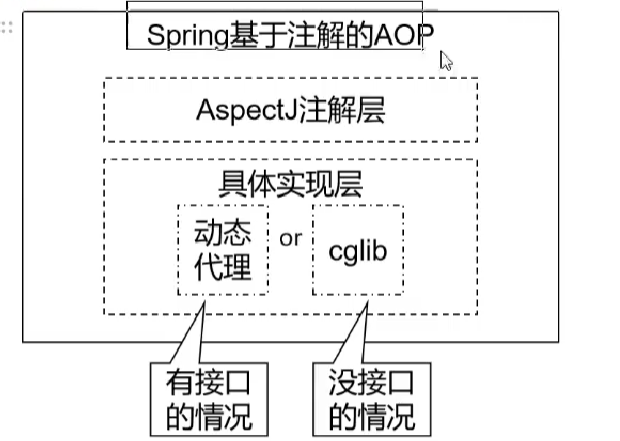

- 动态代理(InvocationHandler):JDK原生的实现方式,需要被代理的目标类必须实现接口。因为这个技术要求代理对象和目标对象实现同样的接口(兄弟两个拜把子模式)。
- cglib:通过继承被代理的目标类(认干爹模式)实现代理,所以不需要目标类实现接口。
- AspectJ:早期的AOP实现的框架,SpringAOP借用了AspectJ中的AOP注解。
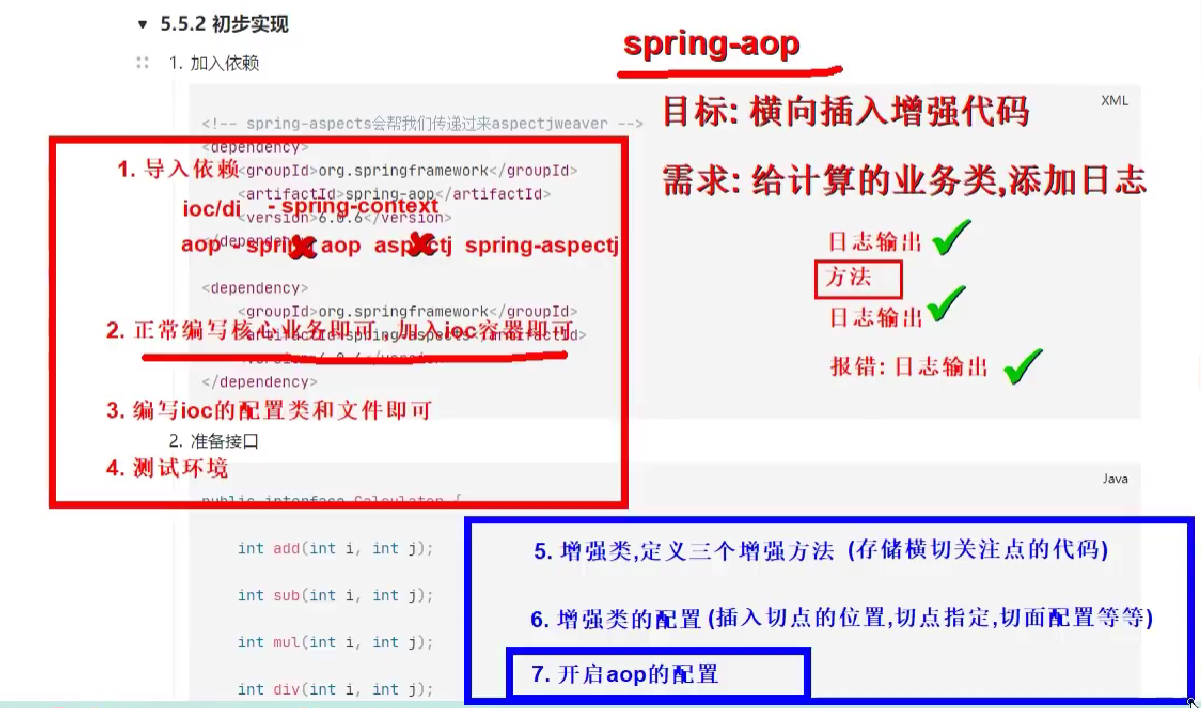
5.5.2 初步实现
- 加入依赖
<!-- spring-aspects会帮我们传递过来aspectjweaver --> <dependency> <groupId>org.springframework</groupId> <artifactId>spring-aop</artifactId> <version>6.0.6</version> </dependency> <dependency> <groupId>org.springframework</groupId> <artifactId>spring-aspects</artifactId> <version>6.0.6</version> </dependency> - 准备接口
public interface Calculator { int add(int i, int j); int sub(int i, int j); int mul(int i, int j); int div(int i, int j); } - 纯净实现类
package com.atguigu.proxy; /** * 实现计算接口,单纯添加 + - * / 实现! 掺杂其他功能! */ @Component public class CalculatorPureImpl implements Calculator { @Override public int add(int i, int j) { int result = i + j; return result; } @Override public int sub(int i, int j) { int result = i - j; return result; } @Override public int mul(int i, int j) { int result = i * j; return result; } @Override public int div(int i, int j) { int result = i / j; return result; } } - 声明切面类
package com.atguigu.advice; import org.aspectj.lang.annotation.*; import org.springframework.stereotype.Component; // @Aspect表示这个类是一个切面类 @Aspect // @Component注解保证这个切面类能够放入IOC容器 @Component public class LogAspect { // @Before注解:声明当前方法是前置通知方法 // value属性:指定切入点表达式,由切入点表达式控制当前通知方法要作用在哪一个目标方法上 @Before(value = "execution(public int com.atguigu.proxy.CalculatorPureImpl.add(int,int))") public void printLogBeforeCore() { System.out.println("[AOP前置通知] 方法开始了"); } @AfterReturning(value = "execution(public int com.atguigu.proxy.CalculatorPureImpl.add(int,int))") public void printLogAfterSuccess() { System.out.println("[AOP返回通知] 方法成功返回了"); } @AfterThrowing(value = "execution(public int com.atguigu.proxy.CalculatorPureImpl.add(int,int))") public void printLogAfterException() { System.out.println("[AOP异常通知] 方法抛异常了"); } @After(value = "execution(public int com.atguigu.proxy.CalculatorPureImpl.add(int,int))") public void printLogFinallyEnd() { System.out.println("[AOP后置通知] 方法最终结束了"); } } - 开启aspectj注解支持
- xml方式
<?xml version="1.0" encoding="UTF-8"?> <beans xmlns="http://www.springframework.org/schema/beans" xmlns:xsi="http://www.w3.org/2001/XMLSchema-instance" xmlns:context="http://www.springframework.org/schema/context" xmlns:aop="http://www.springframework.org/schema/aop" xsi:schemaLocation="http://www.springframework.org/schema/beans http://www.springframework.org/schema/beans/spring-beans.xsd http://www.springframework.org/schema/context https://www.springframework.org/schema/context/spring-context.xsd http://www.springframework.org/schema/aop https://www.springframework.org/schema/aop/spring-aop.xsd"> <!-- 进行包扫描--> <context:component-scan base-package="com.atguigu" /> <!-- 开启aspectj框架注解支持--> <aop:aspectj-autoproxy /> </beans> - 配置类方式
@Configuration @ComponentScan(basePackages = "com.atguigu") //作用等于 <aop:aspectj-autoproxy /> 配置类上开启 Aspectj注解支持! @EnableAspectJAutoProxy public class MyConfig { }
- xml方式
- 测试效果
输出结果://@SpringJUnitConfig(locations = "classpath:spring-aop.xml") @SpringJUnitConfig(value = {MyConfig.class}) public class AopTest { @Autowired private Calculator calculator; @Test public void testCalculator(){ calculator.add(1,1); } }"C:\Program Files\Java\jdk-17\bin\java.exe" -ea -Didea.test.cyclic.buffer.size=1048576 "-javaagent:D:\Program Files\JetBrains\IntelliJ IDEA 2022.3.2\lib\idea_rt.jar=65511:D:\Program Files\JetBrains\IntelliJ IDEA 2022.3.2\bin" -Dfile.encoding=UTF-8 -classpath "C:\Users\Jackiechan\.m2\repository\org\junit\platform\junit-platform-launcher\1.3.1\junit-platform-launcher-1.3.1.jar;C:\Users\Jackiechan\.m2\repository\org\apiguardian\apiguardian-api\1.0.0\apiguardian-api-1.0.0.jar;C:\Users\Jackiechan\.m2\repository\org\junit\platform\junit-platform-engine\1.3.1\junit-platform-engine-1.3.1.jar;C:\Users\Jackiechan\.m2\repository\org\junit\platform\junit-platform-commons\1.3.1\junit-platform-commons-1.3.1.jar;C:\Users\Jackiechan\.m2\repository\org\opentest4j\opentest4j\1.1.1\opentest4j-1.1.1.jar;C:\Users\Jackiechan\.m2\repository\org\junit\jupiter\junit-jupiter-engine\5.3.1\junit-jupiter-engine-5.3.1.jar;C:\Users\Jackiechan\.m2\repository\org\junit\jupiter\junit-jupiter-api\5.3.1\junit-jupiter-api-5.3.1.jar;D:\Program Files\JetBrains\IntelliJ IDEA 2022.3.2\lib\idea_rt.jar;D:\Program Files\JetBrains\IntelliJ IDEA 2022.3.2\plugins\junit\lib\junit5-rt.jar;D:\Program Files\JetBrains\IntelliJ IDEA 2022.3.2\plugins\junit\lib\junit-rt.jar;D:\javaprojects\backend-engineering\part01-spring\spring-aop-annotation\target\test-classes;D:\javaprojects\backend-engineering\part01-spring\spring-aop-annotation\target\classes;D:\repository\org\springframework\spring-context\6.0.6\spring-context-6.0.6.jar;D:\repository\org\springframework\spring-beans\6.0.6\spring-beans-6.0.6.jar;D:\repository\org\springframework\spring-core\6.0.6\spring-core-6.0.6.jar;D:\repository\org\springframework\spring-jcl\6.0.6\spring-jcl-6.0.6.jar;D:\repository\org\springframework\spring-expression\6.0.6\spring-expression-6.0.6.jar;D:\repository\org\junit\jupiter\junit-jupiter-api\5.3.1\junit-jupiter-api-5.3.1.jar;D:\repository\org\apiguardian\apiguardian-api\1.0.0\apiguardian-api-1.0.0.jar;D:\repository\org\opentest4j\opentest4j\1.1.1\opentest4j-1.1.1.jar;D:\repository\org\junit\platform\junit-platform-commons\1.3.1\junit-platform-commons-1.3.1.jar;D:\repository\org\springframework\spring-test\6.0.6\spring-test-6.0.6.jar;D:\repository\jakarta\annotation\jakarta.annotation-api\2.1.1\jakarta.annotation-api-2.1.1.jar;D:\repository\mysql\mysql-connector-java\8.0.25\mysql-connector-java-8.0.25.jar;D:\repository\com\google\protobuf\protobuf-java\3.11.4\protobuf-java-3.11.4.jar;D:\repository\com\alibaba\druid\1.2.8\druid-1.2.8.jar;D:\repository\javax\annotation\javax.annotation-api\1.3.2\javax.annotation-api-1.3.2.jar;D:\repository\org\springframework\spring-aop\6.0.6\spring-aop-6.0.6.jar;D:\repository\org\springframework\spring-aspects\6.0.6\spring-aspects-6.0.6.jar;D:\repository\org\aspectj\aspectjweaver\1.9.9.1\aspectjweaver-1.9.9.1.jar" com.intellij.rt.junit.JUnitStarter -ideVersion5 -junit5 com.atguigu.test.AopTest,testCalculator [AOP前置通知] 方法开始了 [AOP返回通知] 方法成功返回了 [AOP后置通知] 方法最终结束了
5.5.3 获取通知细节信息
-
JointPoint接口
需要获取方法签名、传入的实参等信息时,可以在通知方法声明JoinPoint类型的形参。
- 要点1:JoinPoint 接口通过 getSignature() 方法获取目标方法的签名(方法声明时的完整信息)
- 要点2:通过目标方法签名对象获取方法名
- 要点3:通过 JoinPoint 对象获取外界调用目标方法时传入的实参列表组成的数组
// @Before注解标记前置通知方法 // value属性:切入点表达式,告诉Spring当前通知方法要套用到哪个目标方法上 // 在前置通知方法形参位置声明一个JoinPoint类型的参数,Spring就会将这个对象传入 // 根据JoinPoint对象就可以获取目标方法名称、实际参数列表 @Before(value = "execution(public int com.atguigu.aop.api.Calculator.add(int,int))") public void printLogBeforeCore(JoinPoint joinPoint) { // 1.通过JoinPoint对象获取目标方法签名对象 // 方法的签名:一个方法的全部声明信息 Signature signature = joinPoint.getSignature(); // 2.通过方法的签名对象获取目标方法的详细信息 String methodName = signature.getName(); System.out.println("methodName = " + methodName); int modifiers = signature.getModifiers(); System.out.println("modifiers = " + modifiers); String declaringTypeName = signature.getDeclaringTypeName(); System.out.println("declaringTypeName = " + declaringTypeName); // 3.通过JoinPoint对象获取外界调用目标方法时传入的实参列表 Object[] args = joinPoint.getArgs(); // 4.由于数组直接打印看不到具体数据,所以转换为List集合 List<Object> argList = Arrays.asList(args); System.out.println("[AOP前置通知] " + methodName + "方法开始了,参数列表:" + argList); } -
方法返回值
在返回通知中,通过 @AfterReturning注解的returning属性获取目标方法的返回值!
// @AfterReturning注解标记返回通知方法 // 在返回通知中获取目标方法返回值分两步: // 第一步:在@AfterReturning注解中通过returning属性设置一个名称 // 第二步:使用returning属性设置的名称在通知方法中声明一个对应的形参 @AfterReturning( value = "execution(public int com.atguigu.aop.api.Calculator.add(int,int))", returning = "targetMethodReturnValue" ) public void printLogAfterCoreSuccess(JoinPoint joinPoint, Object targetMethodReturnValue) { String methodName = joinPoint.getSignature().getName(); System.out.println("[AOP返回通知] "+methodName+"方法成功结束了,返回值是:" + targetMethodReturnValue); } -
异常对象捕捉
在异常通知中,通过@AfterThrowing注解的throwing属性获取目标方法抛出的异常对象
// @AfterThrowing注解标记异常通知方法 // 在异常通知中获取目标方法抛出的异常分两步: // 第一步:在@AfterThrowing注解中声明一个throwing属性设定形参名称 // 第二步:使用throwing属性指定的名称在通知方法声明形参,Spring会将目标方法抛出的异常对象从这里传给我们 @AfterThrowing( value = "execution(public int com.atguigu.aop.api.Calculator.add(int,int))", throwing = "targetMethodException" ) public void printLogAfterCoreException(JoinPoint joinPoint, Throwable targetMethodException) { String methodName = joinPoint.getSignature().getName(); System.out.println("[AOP异常通知] "+methodName+"方法抛异常了,异常类型是:" + targetMethodException.getClass().getName()); }
5.5.4 切点表达式语法
-
切点表达式作用
AOP切点表达式(Pointcut Expression)是一种用于指定切点的语言,它可以通过定义匹配规则,来选择需要被切入的目标对象。
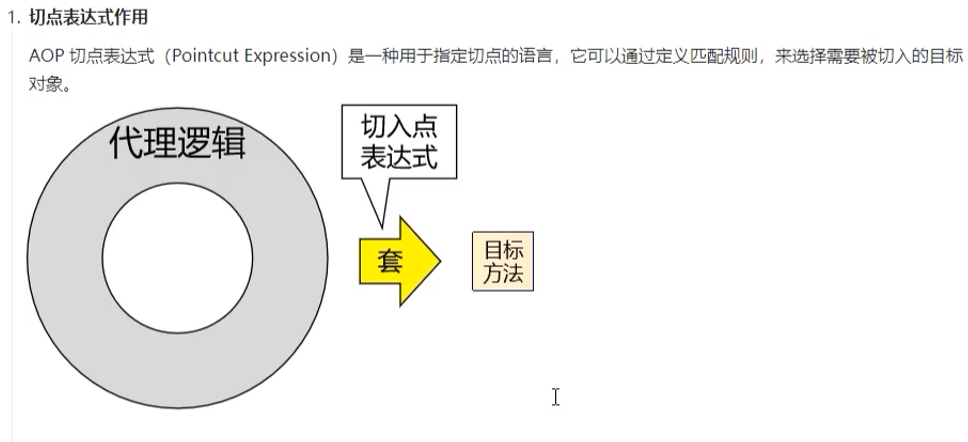
-
切点表达式语法
切点表达式总结
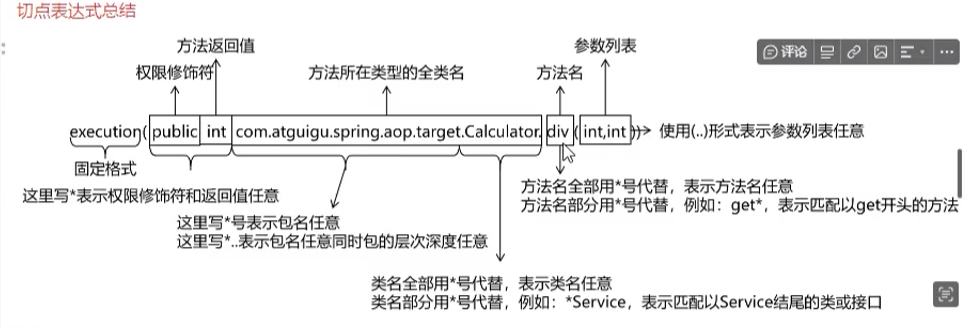
语法细节
-
第一位:execution( ) 固定开头
-
第二位:方法访问修饰符
public private 直接描述对应修饰符即可 -
第三位:方法返回值
int String void 直接描述返回值类型注意:
特殊情况 不考虑 访问修饰符和返回值
execution(* * ) 这是错误语法
execution( *) == 你只要考虑返回值 或者 不考虑访问修饰符 相当于全部不考虑了
-
第四位:指定包的地址
固定的包: com.atguigu.api | service | dao 单层的任意命名: com.atguigu.* = com.atguigu.api com.atguigu.dao * = 任意一层的任意命名 任意层任意命名: com.. = com.atguigu.api.erdaye com.a.a.a.a.a.a.a ..任意层,任意命名 用在包上! 注意: ..不能用作包开头 public int .. 错误语法 com.. 找到任何包下: *.. -
第五位:指定类名称
固定名称: UserService 任意类名: * 部分任意: com..service.impl.*Impl 任意包任意类: *..* -
第六位:指定方法名称
语法和类名一致 任意访问修饰符,任意类的任意方法: * *..*.* -
第七位:方法参数
第七位: 方法的参数描述 具体值: (String,int) != (int,String) 没有参数 () 模糊值: 任意参数 有 或者 没有 (..) ..任意参数的意识 部分具体和模糊: 第一个参数是字符串的方法 (String..) 最后一个参数是字符串 (..String) 字符串开头,int结尾 (String..int) 包含int类型(..int..)
-
-
切点表达式案例
1.查询某包某类下,访问修饰符是公有,返回值是int的全部方法 2.查询某包下类中第一个参数是String的方法 3.查询全部包下,无参数的方法! 4.查询com包下,以int参数类型结尾的方法 5.查询指定包下,Service开头类的私有返回值int的无参数方法
5.5.5 复用(提取)切点表达式
-
重用切点表达式优点
// @Before注解:声明当前方法是前置通知方法 // value属性:指定切入点表达式,由切入点表达式控制当前通知方法要作用在哪一个目标方法上 @Before(value = "execution(public int com.atguigu.proxy.CalculatorPureImpl.add(int,int))") public void printLogBeforeCore() { System.out.println("[AOP前置通知] 方法开始了"); } @AfterReturning(value = "execution(public int com.atguigu.proxy.CalculatorPureImpl.add(int,int))") public void printLogAfterSuccess() { System.out.println("[AOP返回通知] 方法成功返回了"); } @AfterThrowing(value = "execution(public int com.atguigu.proxy.CalculatorPureImpl.add(int,int))") public void printLogAfterException() { System.out.println("[AOP异常通知] 方法抛异常了"); } @After(value = "execution(public int com.atguigu.proxy.CalculatorPureImpl.add(int,int))") public void printLogFinallyEnd() { System.out.println("[AOP后置通知] 方法最终结束了"); }上面案例,是我们之前编写切点表达式的方式,发现, 所有增强方法的切点表达式相同!
出现了冗余,如果需要切换也不方便统一维护!
我们可以将切点提取,在增强上进行引用即可!
-
同一类内部引用
提取
// 切入点表达式重用 @Pointcut("execution(public int com.atguigu.aop.api.Calculator.add(int,int)))") public void declarPointCut() {}注意:提取切点注解使用@Pointcut(切点表达式) , 需要添加到一个无参数无返回值方法上即可!
引用
@Before(value = "declarPointCut()") public void printLogBeforeCoreOperation(JoinPoint joinPoint) { -
不同类中引用
不同类在引用切点,只需要添加类的全限定符+方法名即可!
@Before(value = "com.atguigu.spring.aop.aspect.LogAspect.declarPointCut()") public Object roundAdvice(ProceedingJoinPoint joinPoint) { -
切点统一管理
建议:将切点表达式统一存储到一个类中进行集中管理和维护!
@Component public class AtguiguPointCut { @Pointcut(value = "execution(public int *..Calculator.sub(int,int))") public void atguiguGlobalPointCut(){} @Pointcut(value = "execution(public int *..Calculator.add(int,int))") public void atguiguSecondPointCut(){} @Pointcut(value = "execution(* *..*Service.*(..))") public void transactionPointCut(){} }
5.5.6 环绕通知
环绕通知对应整个 try…catch…finally 结构,包括前面四种通知的所有功能。
// 使用@Around注解标明环绕通知方法
@Around(value = "com.atguigu.aop.aspect.AtguiguPointCut.transactionPointCut()")
public Object manageTransaction(
// 通过在通知方法形参位置声明ProceedingJoinPoint类型的形参,
// Spring会将这个类型的对象传给我们
ProceedingJoinPoint joinPoint) {
// 通过ProceedingJoinPoint对象获取外界调用目标方法时传入的实参数组
Object[] args = joinPoint.getArgs();
// 通过ProceedingJoinPoint对象获取目标方法的签名对象
Signature signature = joinPoint.getSignature();
// 通过签名对象获取目标方法的方法名
String methodName = signature.getName();
// 声明变量用来存储目标方法的返回值
Object targetMethodReturnValue = null;
try {
// 在目标方法执行前:开启事务(模拟)
log.debug("[AOP 环绕通知] 开启事务,方法名:" + methodName + ",参数列表:" + Arrays.asList(args));
// 过ProceedingJoinPoint对象调用目标方法
// 目标方法的返回值一定要返回给外界调用者
targetMethodReturnValue = joinPoint.proceed(args);
// 在目标方法成功返回后:提交事务(模拟)
log.debug("[AOP 环绕通知] 提交事务,方法名:" + methodName + ",方法返回值:" + targetMethodReturnValue);
}catch (Throwable e){
// 在目标方法抛异常后:回滚事务(模拟)
log.debug("[AOP 环绕通知] 回滚事务,方法名:" + methodName + ",异常:" + e.getClass().getName());
}finally {
// 在目标方法最终结束后:释放数据库连接
log.debug("[AOP 环绕通知] 释放数据库连接,方法名:" + methodName);
}
return targetMethodReturnValue;
}
5.5.7 切面优先级设置
相同目标方法上同时存在多个切面时,切面的优先级控制切面的内外嵌套顺序。
- 优先级高的切面:外面
- 优先级低的切面:里面
使用 @Order 注解可以控制切面的优先级:
- @Order(较小的数):优先级高
- @Order(较大的数):优先级低
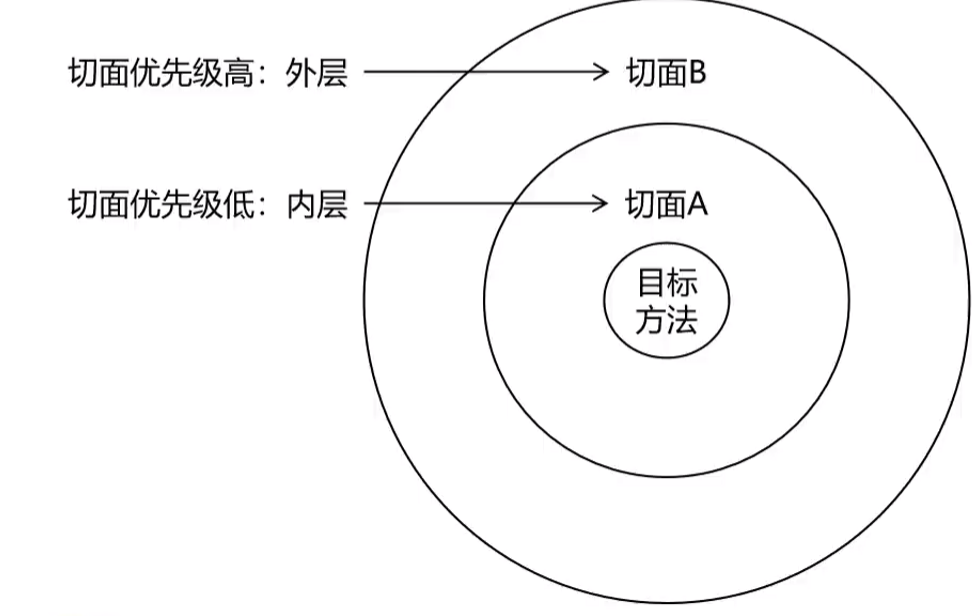
实际意义
实际开发时,如果有多个切面嵌套的情况,要慎重考虑。例如:如果事务切面优先级高,那么在缓存中命中数据的情况下,事务切面的操作都浪费了。

此时应该将缓存切面的优先级提高,在事务操作之前先检查缓存中是否存在目标数据。

5.5.8 CGLib动态代理生效
在目标类没有实现任何接口的情况下,Spring会自动使用cglib技术实现代理。为了证明这一点,我们做下面的测试:
@Service
public class EmployeeService {
public void getEmpList() {
System.out.print("方法内部 com.atguigu.aop.imp.EmployeeService.getEmpList");
}
}
测试:
@Autowired
private EmployeeService employeeService;
@Test
public void testNoInterfaceProxy() {
employeeService.getEmpList();
}
没有接口:

有接口:

使用总结:
a. 如果目标类有接口,选择使用jdk动态代理
b. 如果目标类没有接口,选择cglib动态代理
c. 如果有接口,接口接值
d. 如果没有接口,类进行接值
5.5.9 注解实现小结
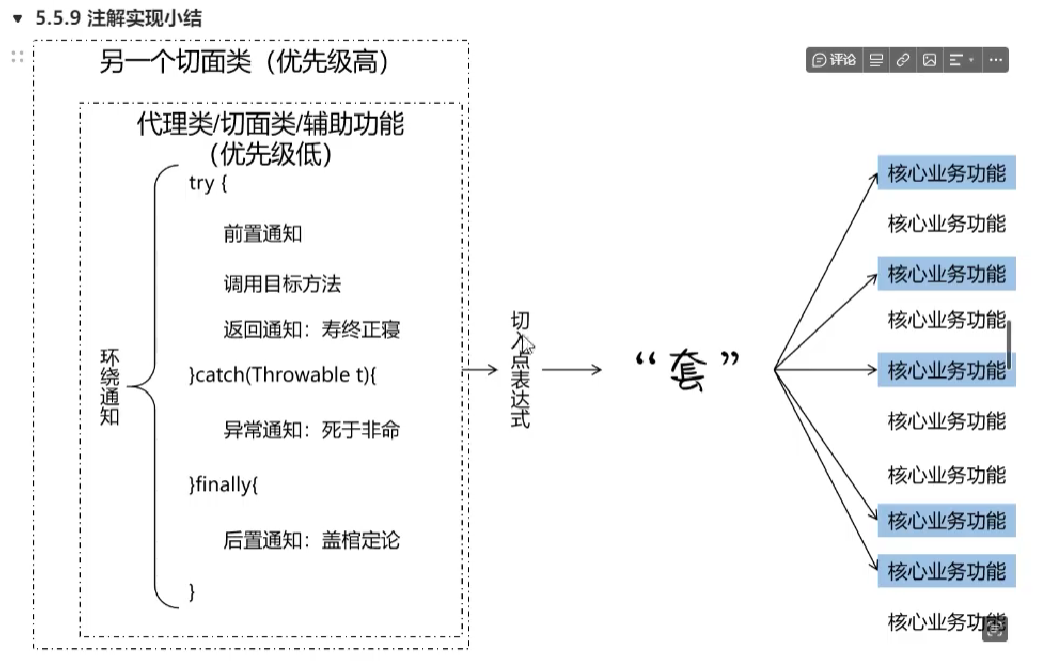
5.6 Spring AOP基于XML方式实现(了解)
-
准备工作
加入依赖
和基于注解的 AOP 时一样。
准备代码
把测试基于注解功能时的Java类复制到新module中,去除所有注解。
-
配置Spring配置文件
<!-- 配置目标类的bean --> <bean id="calculatorPure" class="com.atguigu.aop.imp.CalculatorPureImpl"/> <!-- 配置切面类的bean --> <bean id="logAspect" class="com.atguigu.aop.aspect.LogAspect"/> <!-- 配置AOP --> <aop:config> <!-- 配置切入点表达式 --> <aop:pointcut id="logPointCut" expression="execution(* *..*.*(..))"/> <!-- aop:aspect标签:配置切面 --> <!-- ref属性:关联切面类的bean --> <aop:aspect ref="logAspect"> <!-- aop:before标签:配置前置通知 --> <!-- method属性:指定前置通知的方法名 --> <!-- pointcut-ref属性:引用切入点表达式 --> <aop:before method="printLogBeforeCore" pointcut-ref="logPointCut"/> <!-- aop:after-returning标签:配置返回通知 --> <!-- returning属性:指定通知方法中用来接收目标方法返回值的参数名 --> <aop:after-returning method="printLogAfterCoreSuccess" pointcut-ref="logPointCut" returning="targetMethodReturnValue"/> <!-- aop:after-throwing标签:配置异常通知 --> <!-- throwing属性:指定通知方法中用来接收目标方法抛出异常的异常对象的参数名 --> <aop:after-throwing method="printLogAfterCoreException" pointcut-ref="logPointCut" throwing="targetMethodException"/> <!-- aop:after标签:配置后置通知 --> <aop:after method="printLogCoreFinallyEnd" pointcut-ref="logPointCut"/> <!-- aop:around标签:配置环绕通知 --> <!--<aop:around method="……" pointcut-ref="logPointCut"/>--> </aop:aspect> </aop:config> -
测试
@SpringJUnitConfig(locations = "classpath:spring-aop.xml") public class AopTest { @Autowired private Calculator calculator; @Test public void testCalculator(){ System.out.println(calculator); calculator.add(1,1); } }
5.7 Spring AOP对获取Bean的影响理解
5.7.1 根据类型装配 bean
- 情景一
- bean 对应的类没有实现任何接口
- 根据 bean 本身的类型获取 bean
-
测试:IOC容器中同类型的 bean 只有一个
正常获取到 IOC 容器中的那个 bean 对象
-
测试:IOC 容器中同类型的 bean 有多个
会抛出 NoUniqueBeanDefinitionException 异常,表示 IOC 容器中这个类型的 bean 有多个
-
- 情景二
- bean 对应的类实现了接口,这个接口也只有这一个实现类
- 测试:根据接口类型获取 bean
- 测试:根据类获取 bean
- 结论:上面两种情况其实都能够正常获取到 bean,而且是同一个对象
- bean 对应的类实现了接口,这个接口也只有这一个实现类
- 情景三
- 声明一个接口
- 接口有多个实现类
- 接口所有实现类都放入 IOC 容器
-
测试:根据接口类型获取 bean
会抛出 NoUniqueBeanDefinitionException 异常,表示 IOC 容器中这个类型的 bean 有多个
-
测试:根据类获取bean
正常
-
- 情景四
-
声明一个接口
-
接口有一个实现类
-
创建一个切面类,对上面接口的实现类应用通知
-
测试:根据接口类型获取bean
正常
-
测试:根据类获取bean
无法获取
原因分析:
-
-
应用了切面后,真正放在IOC容器中的是代理类的对象
-
目标类并没有被放到IOC容器中,所以根据目标类的类型从IOC容器中是找不到的

-
- 情景五
-
声明一个类
-
创建一个切面类,对上面的类应用通知
- 测试:根据类获取 bean,能获取到
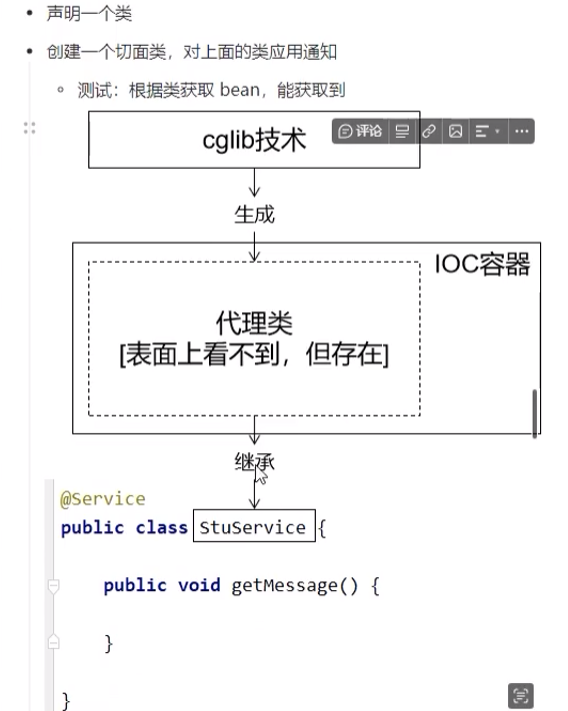
debug查看实际类型:
- 测试:根据类获取 bean,能获取到
-
5.7.2 使用总结
对实现了接口的类应用切面
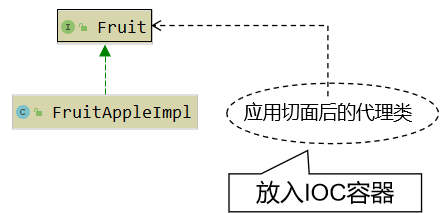
对没实现接口的类应用切面new

如果使用AOP技术,目标类有接口,必须使用接口类型接收IoC容器中代理组件!
六、Spring 声明式事务
6.1 声明式事务概念
6.1.1 编程式事务
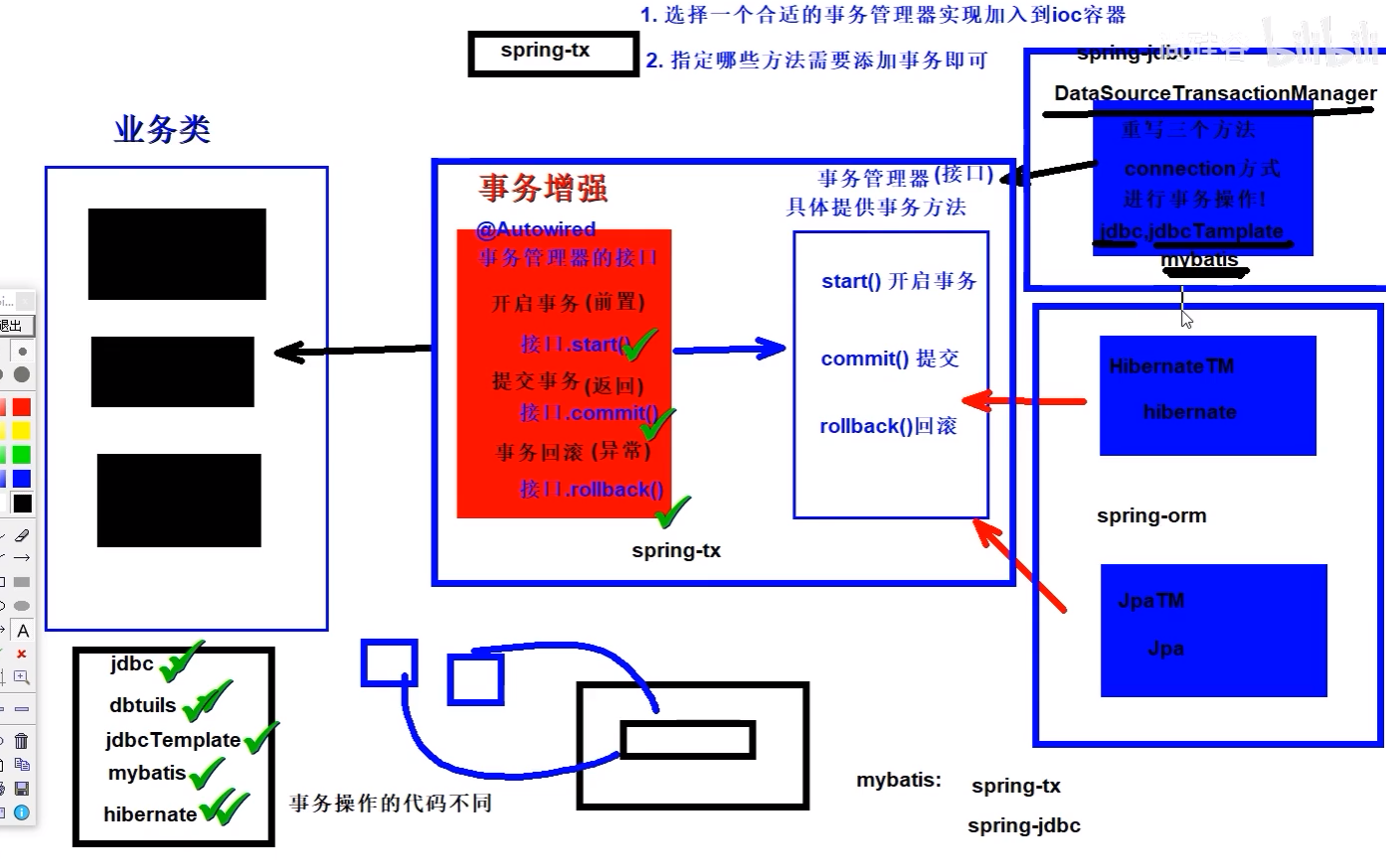
编程式事务是指手动编写程序来管理事务,即通过编写代码的方式直接控制事务的提交和回滚。在 Java 中,通常使用事务管理器(如 Spring 中的 PlatformTransactionManager)来实现编程式事务。
编程式事务的主要优点是灵活性高,可以按照自己的需求来控制事务的粒度、模式等等。但是,编写大量的事务控制代码容易出现问题,对代码的可读性和可维护性有一定影响。
Connection conn = ...;
try {
// 开启事务:关闭事务的自动提交
conn.setAutoCommit(false);
// 核心操作
// 业务代码
// 提交事务
conn.commit();
}catch(Exception e){
// 回滚事务
conn.rollBack();
}finally{
// 释放数据库连接
conn.close();
}
编程式的实现方式存在缺陷:
- 细节没有被屏蔽:具体操作过程中,所有细节都需要程序员自己来完成,比较繁琐。
- 代码复用性不高:如果没有有效抽取出来,每次实现功能都需要自己编写代码,代码就没有得到复用。
6.1.2 声明式事务
声明式事务是指使用注解或 XML 配置的方式来控制事务的提交和回滚。
开发者只需要添加配置即可, 具体事务的实现由第三方框架实现,避免我们直接进行事务操作!
使用声明式事务可以将事务的控制和业务逻辑分离开来,提高代码的可读性和可维护性。
区别:
- 编程式事务需要手动编写代码来管理事务
- 而声明式事务可以通过配置文件或注解来控制事务。
6.1.3 Spring事务管理器
-
Spring声明式事务对应依赖
- spring-tx: 包含声明式事务实现的基本规范(事务管理器规范接口和事务增强等等)
- spring-jdbc: 包含DataSource方式事务管理器实现类DataSourceTransactionManager
- spring-orm: 包含其他持久层框架的事务管理器实现类例如:Hibernate/Jpa等
-
Spring声明式事务对应事务管理器接口

我们现在要使用的事务管理器是org.springframework.jdbc.datasource.DataSourceTransactionManager,将来整合 JDBC方式、JdbcTemplate方式、Mybatis方式的事务实现!
DataSourceTransactionManager类中的主要方法:
- doBegin():开启事务
- doSuspend():挂起事务
- doResume():恢复挂起的事务
- doCommit():提交事务
- doRollback():回滚事务
汇总回顾
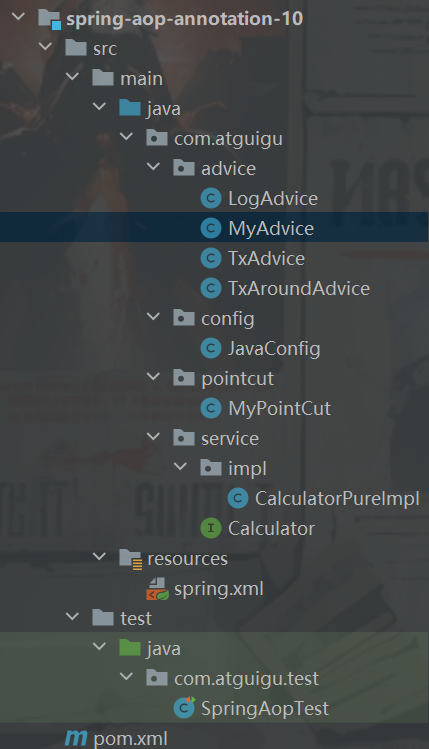
导入依赖
service层创建
package com.jovey.service;
public interface Calculator {
int add(int i, int j);
int sub(int i, int j);
int mul(int i, int j);
int div(int i, int j);
}
package com.jovey.service.impl;
import com.jovey.service.Calculator;
import org.springframework.stereotype.Component;
/**
* 实现计算接口,单纯添加 + - * / 实现! 掺杂其他功能!
*
* aop - 只针对ioc容器的对象 - 创建代理对象 -> 代理对象存储到ioc容器
*
*/
@Component
public class CalculatorPureImpl {
public int add(int i, int j) {
int result = i + j;
return result;
}
public int sub(int i, int j) {
int result = i - j;
return result;
}
public int mul(int i, int j) {
int result = i * j;
return result;
}
public int div(int i, int j) {
int result = i / j;
return result;
}
}
两中方法一种xml,一种配置类
<?xml version="1.0" encoding="UTF-8"?>
<beans xmlns="http://www.springframework.org/schema/beans"
xmlns:xsi="http://www.w3.org/2001/XMLSchema-instance"
xmlns:context="http://www.springframework.org/schema/context"
xsi:schemaLocation="http://www.springframework.org/schema/beans http://www.springframework.org/schema/beans/spring-beans.xsd http://www.springframework.org/schema/context https://www.springframework.org/schema/context/spring-context.xsd">
<context:component-scan base-package="com.jovey.service" />
</beans>
配置类
package com.jovey.config;
import org.springframework.context.annotation.ComponentScan;
import org.springframework.context.annotation.Configuration;
import org.springframework.context.annotation.EnableAspectJAutoProxy;
/**
* projectName: com.atguigu.config
*
* @author: 赵伟风
* description: 配置类
*/
@Configuration
@ComponentScan("com.jovey")
@EnableAspectJAutoProxy //开启aspectj的注解 <aop:aspectj-autoproxy />
public class JavaConfig {
}
测试类
package com.jovey.test;
import com.jovey.config.JavaConfig;
import com.jovey.service.impl.CalculatorPureImpl;
import org.junit.jupiter.api.Test;
import org.springframework.beans.factory.annotation.Autowired;
import org.springframework.test.context.junit.jupiter.SpringJUnitConfig;
@SpringJUnitConfig(value = JavaConfig.class)
public class SpringAopTest {
// aop - 代理 - jdk - 接口 - 代理类 - 代理对象和目标对象 拜把子 兄弟关系 - 接口接值
// aop - ioc - 代理对象
@Autowired
private CalculatorPureImpl calculator;
@Test
public void test(){
int add = calculator.div(1, 1);
System.out.println("add = " + add);
}
}
增强类
package com.atguigu.advice;
import org.aspectj.lang.annotation.*;
import org.springframework.core.annotation.Order;
import org.springframework.stereotype.Component;
/**
* projectName: com.atguigu.advice
*
* @author: 赵伟风
* description: 增强类的内部要存储增强代码
*
* 1. 定义方法存储增强代码
* 具体定义几个方法,根据插入的位置决定!
* 2. 使用注解配置 指定插入目标方法的位置
* 前置 @Before
* 后置 @AfterReturning
* 异常 @AfterThrowing
* 最后 @After
* 环绕 @Around
*
* try{
* 前置
* 目标方法执行
* 后置
* }catch(){
* 异常
* }finally{
* 最后
* }
*
* 3. 配置切点表达式 [选中插入的方法 切点]
*
* 4.补全注解
* 加入ioc容器 @Component
* 配置切面 @Aspect = 切点 + 增强
*
* spring aop 重点是 配置 -> jdk | cglib
*
* 5.开启aspect注解的支持
*
*
*/
@Component
@Aspect
@Order(20)
public class LogAdvice {
/**
* TODO: 切点表达式
* 固定语法 execution(1 2 3.4.5(6))
* 1. 访问修饰符
* public / private
* 2. 方法的返回参数类型
* String int void
* 如果不考虑访问修饰符和返回值! 这两位整合成一起写 *
* 如果要是不考虑,必须两个都不考虑! 不能出现 * String
* 3. 包的位置
* 具体包: com.atguigu.service.impl
* 单层模糊: com.atguigu.service.* * 单层模糊
* 多层模糊: com..impl ..任意层的模糊
* 细节: ..不能开头
* 找所有impl包: com..impl 不能写..impl 写成: *..impl
* 4. 类的名称
* 具体: CalculatorPureImpl
* 模糊: *
* 不分模糊: *Impl
* 5. 方法名 语法和类名一致
* 6. (6)形参数列表
* 没有参数: ()
* 有具体参数: (String) (String,int)
* 模糊参数: (..) 有没有参数都可以,有多个也可以!
* 不分模糊: (String..) String 后面有没有无所谓
* (..int) 最后一个参数是int
* (String..int)
*
* TODO: 实战
* 1.查询某包某类下,访问修饰符是公有,返回值是int的全部方法
* public int xx.xx.jj.*(..)
* 2.查询某包下类中第一个参数是String的方法
* * xx.xx.jj.*(String..)
* 3.查询全部包下,无参数的方法!
* * *..*.*()
* 4.查询com包下,以int参数类型结尾的方法
* * com..*.*(..int)
* 5.查询指定包下,Service开头类的私有返回值int的无参数方法
* private int xx.xx.Service*.*()
*
*/
/**
* TODO: 切点表达式的提取和复用
* 1. 当前类中提取
* 定义一个空方法
* 注解 @Pointcut()
* 增强注解中引用切点表达式的方法即可 直接调用方法
* 2. 创建一个存储切点的类
* 单独维护切点表达式
* 其他类的切点方法 类的全限定符号.方法名()
*/
@Before("com.atguigu.pointcut.MyPointCut.pc()")
public void start(){
System.out.println("方法开始了");
}
@After("com.atguigu.pointcut.MyPointCut.pc()")
public void after(){
System.out.println("方法结束了");
}
@AfterThrowing("com.atguigu.pointcut.MyPointCut.pc()")
public void error(){
System.out.println("方法报错了");
}
}
然后开启注解配置
xml中
<!-- 支持aspectj的注解配置 -->
<aop:aspectj-autoproxy />
配置类中
@EnableAspectJAutoProxy //开启aspectj的注解 <aop:aspectj-autoproxy />
切面详细信息
package com.atguigu.advice;
import org.aspectj.lang.JoinPoint;
import org.aspectj.lang.annotation.*;
import org.springframework.stereotype.Component;
import java.lang.reflect.Modifier;
/**
* projectName: com.atguigu.advice
*
* @author: 赵伟风
* description: 定义四个增强方法,获取目标方法的信息 返回值 异常对象
*
* 1.定义方法 - 增强代码
* 2.使用注解指定对应的位置
* 3.配置切点表达式选中方法
* 4.切面和ioc的配置
* 5.开启aspectj注解的支持
*
* TODO: 增强方法中获取目标方法信息
* 1. 全部增强方法中,获取目标方法的信息(方法名,参数,访问修饰符,所属的类的信息...)
* (JoinPoint jointPoint) import org.aspectj.lang.JoinPoint;
* joinPoint包含目标方法的信息!
* 2. 返回的结果 - @AfterReturning
* (Object result) result接收返回结果
* @AfterReturning(value = "execution(* com..impl.*.*(..))",returning = "形参名即可")
* 3. 异常的信息 - @AfterThrowing
* (Throwable t) t接收异常信息
* @AfterThrowing(value = "execution(* com..impl.*.*(..))",throwing = "形参名即可")
*/
//@Component
//@Aspect
public class MyAdvice {
@Before("com.atguigu.pointcut.MyPointCut.myPc()")
public void before(JoinPoint jointPoint){
//1.获取方法属于的类的信息
String simpleName = jointPoint.getTarget().getClass().getSimpleName();
//2.获取方法名称
int modifiers = jointPoint.getSignature().getModifiers();//获取访问修饰符
String s = Modifier.toString(modifiers);
String name = jointPoint.getSignature().getName(); //获取方法名
//3.获取参数列表
Object[] args = jointPoint.getArgs(); //获取目标方法参数
}
@AfterReturning(value = "com.atguigu.pointcut.MyPointCut.myPc()",returning = "result")
public void afterReturning(JoinPoint jointPoint,Object result){
}
@After("com.atguigu.pointcut.MyPointCut.myPc()")
public void after(JoinPoint jointPoint){
}
@AfterThrowing(value = "execution(* com..impl.*.*(..))",throwing = "throwable")
public void afterThrowing(JoinPoint jointPoint,Throwable throwable){
}
}
环绕通知
package com.atguigu.advice;
import org.aspectj.lang.ProceedingJoinPoint;
import org.aspectj.lang.annotation.Around;
import org.aspectj.lang.annotation.Aspect;
import org.springframework.core.annotation.Order;
import org.springframework.stereotype.Component;
/**
* projectName: com.atguigu.advice
*
* @author: 赵伟风
* description:
*/
//@Component
//@Aspect
public class TxAroundAdvice {
/**
* 环绕通知,需要你在通知中,定义目标方法的执行!
*
*
* @param joinPoint 目标方法 (获取目标方法信息,多了一个执行方法)
* @return 目标方法的返回值
*
*/
@Around("com.atguigu.pointcut.MyPointCut.pc()")
public Object transaction(ProceedingJoinPoint joinPoint){
//保证目标方法被执行即可
Object[] args = joinPoint.getArgs();
Object result = null;
try {
//增强代码 -> before
System.out.println("开启事务");
result = joinPoint.proceed(args);
System.out.println("结束事务");
} catch (Throwable e) {
System.out.println("事务回滚");
throw new RuntimeException(e);
}finally {
}
return result;
}
}
aop步骤流程
正常业务代码 service层,写增强带码,advice层,然后再写相应的增强方法
6.2 基于注解的声明式事务
6.2.1 准备工作
-
准备项目
<dependencies> <!--spring context依赖--> <!--当你引入Spring Context依赖之后,表示将Spring的基础依赖引入了--> <dependency> <groupId>org.springframework</groupId> <artifactId>spring-context</artifactId> <version>6.0.6</version> </dependency> <!--junit5测试--> <dependency> <groupId>org.junit.jupiter</groupId> <artifactId>junit-jupiter-api</artifactId> <version>5.3.1</version> </dependency> <dependency> <groupId>org.springframework</groupId> <artifactId>spring-test</artifactId> <version>6.0.6</version> <scope>test</scope> </dependency> <dependency> <groupId>jakarta.annotation</groupId> <artifactId>jakarta.annotation-api</artifactId> <version>2.1.1</version> </dependency> <!-- 数据库驱动 和 连接池--> <dependency> <groupId>mysql</groupId> <artifactId>mysql-connector-java</artifactId> <version>8.0.25</version> </dependency> <dependency> <groupId>com.alibaba</groupId> <artifactId>druid</artifactId> <version>1.2.8</version> </dependency> <!-- spring-jdbc --> <dependency> <groupId>org.springframework</groupId> <artifactId>spring-jdbc</artifactId> <version>6.0.6</version> </dependency> <!-- 声明式事务依赖--> <dependency> <groupId>org.springframework</groupId> <artifactId>spring-tx</artifactId> <version>6.0.6</version> </dependency> <dependency> <groupId>org.springframework</groupId> <artifactId>spring-aop</artifactId> <version>6.0.6</version> </dependency> <dependency> <groupId>org.springframework</groupId> <artifactId>spring-aspects</artifactId> <version>6.0.6</version> </dependency> </dependencies> -
外部配置文件
jdbc.properties
atguigu.url=jdbc:mysql://localhost:3306/studb atguigu.driver=com.mysql.cj.jdbc.Driver atguigu.username=root atguigu.password=root -
spring配置文件
@Configuration @ComponentScan("com.atguigu") @PropertySource("classpath:jdbc.properties") public class JavaConfig { @Value("${atguigu.driver}") private String driver; @Value("${atguigu.url}") private String url; @Value("${atguigu.username}") private String username; @Value("${atguigu.password}") private String password; //druid连接池 @Bean public DataSource dataSource(){ DruidDataSource dataSource = new DruidDataSource(); dataSource.setDriverClassName(driver); dataSource.setUrl(url); dataSource.setUsername(username); dataSource.setPassword(password); return dataSource; } @Bean //jdbcTemplate public JdbcTemplate jdbcTemplate(DataSource dataSource){ JdbcTemplate jdbcTemplate = new JdbcTemplate(); jdbcTemplate.setDataSource(dataSource); return jdbcTemplate; } } -
准备dao/service层
dao
@Repository public class StudentDao { @Autowired private JdbcTemplate jdbcTemplate; public void updateNameById(String name,Integer id){ String sql = "update students set name = ? where id = ? ;"; int rows = jdbcTemplate.update(sql, name, id); } public void updateAgeById(Integer age,Integer id){ String sql = "update students set age = ? where id = ? ;"; jdbcTemplate.update(sql,age,id); } }service
@Service public class StudentService { @Autowired private StudentDao studentDao; public void changeInfo(){ studentDao.updateAgeById(100,1); System.out.println("-----------"); studentDao.updateNameById("test1",1); } } -
测试环境搭建
/** * projectName: com.atguigu.test * * description: */ @SpringJUnitConfig(JavaConfig.class) public class TxTest { @Autowired private StudentService studentService; @Test public void testTx(){ studentService.changeInfo(); } }
6.2.2 基本事务控制
-
配置事务管理器
数据库相关的配置
/** * projectName: com.atguigu.config * * description: 数据库和连接池配置类 */ @Configuration @ComponenScan("com.atguigu") @PropertySource(value = "classpath:jdbc.properties") @EnableTransactionManagement public class DataSourceConfig { /** * 实例化dataSource加入到ioc容器 * @param url * @param driver * @param username * @param password * @return */ @Bean public DataSource dataSource(@Value("${atguigu.url}")String url, @Value("${atguigu.driver}")String driver, @Value("${atguigu.username}")String username, @Value("${atguigu.password}")String password){ DruidDataSource dataSource = new DruidDataSource(); dataSource.setDriverClassName(driver); dataSource.setUrl(url); dataSource.setUsername(username); dataSource.setPassword(password); return dataSource; } /** * 实例化JdbcTemplate对象,需要使用ioc中的DataSource * @param dataSource * @return */ @Bean public JdbcTemplate jdbcTemplate(DataSource dataSource){ JdbcTemplate jdbcTemplate = new JdbcTemplate(); jdbcTemplate.setDataSource(dataSource); return jdbcTemplate; } /** * 装配事务管理实现对象 * @param dataSource * @return */ @Bean public TransactionManager transactionManager(DataSource dataSource){ return new DataSourceTransactionManager(dataSource); } } -
使用声明事务注解@Transactional
/** * projectName: com.atguigu.service * */ @Service public class StudentService { @Autowired private StudentDao studentDao; @Transactional public void changeInfo(){ studentDao.updateAgeById(100,1); System.out.println("-----------"); int i = 1/0; studentDao.updateNameById("test1",1); } } -
测试事务效果
/** * projectName: com.atguigu.test * * description: */ //@SpringJUnitConfig(locations = "classpath:application.xml") @SpringJUnitConfig(classes = DataSourceConfig.class) public class TxTest { @Autowired private StudentService studentService; @Test public void testTx(){ studentService.changeInfo(); } }
6.2.3 事务属性:只读
-
只读介绍
对一个查询操作来说,如果我们把它设置成只读,就能够明确告诉数据库,这个操作不涉及写操作。这样数据库就能够针对查询操作来进行优化。
-
设置方式
// readOnly = true把当前事务设置为只读 默认是false! @Transactional(readOnly = true) -
针对DML动作设置只读模式
会抛出下面异常:
Caused by: java.sql.SQLException: Connection is read-only. Queries leading to data modification are not allowed
-
@Transactional注解放在类上
-
生效原则
如果一个类中每一个方法上都使用了 @Transactional 注解,那么就可以将 @Transactional 注解提取到类上。反过来说:@Transactional 注解在类级别标记,会影响到类中的每一个方法。同时,类级别标记的 @Transactional 注解中设置的事务属性也会延续影响到方法执行时的事务属性。除非在方法上又设置了 @Transactional 注解。
对一个方法来说,离它最近的 @Transactional 注解中的事务属性设置生效。
-
用法举例
在类级别@Transactional注解中设置只读,这样类中所有的查询方法都不需要设置@Transactional注解了。因为对查询操作来说,其他属性通常不需要设置,所以使用公共设置即可。
然后在这个基础上,对增删改方法设置@Transactional注解 readOnly 属性为 false。
@Service @Transactional(readOnly = true) public class EmpService { // 为了便于核对数据库操作结果,不要修改同一条记录 @Transactional(readOnly = false) public void updateTwice(……) { …… } // readOnly = true把当前事务设置为只读 // @Transactional(readOnly = true) public String getEmpName(Integer empId) { …… } } -
6.2.4 事务属性:超时时间
-
需求
事务在执行过程中,有可能因为遇到某些问题,导致程序卡住,从而长时间占用数据库资源。而长时间占用资源,大概率是因为程序运行出现了问题(可能是Java程序或MySQL数据库或网络连接等等)。
此时这个很可能出问题的程序应该被回滚,撤销它已做的操作,事务结束,把资源让出来,让其他正常程序可以执行。
概括来说就是一句话:超时回滚,释放资源。
-
设置超时时间
@Service public class StudentService { @Autowired private StudentDao studentDao; /** * timeout设置事务超时时间,单位秒! 默认: -1 永不超时,不限制事务时间! */ @Transactional(readOnly = false,timeout = 3) public void changeInfo(){ studentDao.updateAgeById(100,1); //休眠4秒,等待方法超时! try { Thread.sleep(4000); } catch (InterruptedException e) { throw new RuntimeException(e); } studentDao.updateNameById("test1",1); } } -
测试超时效果
执行抛出事务超时异常
org.springframework.transaction.TransactionTimedOutException: Transaction timed out: deadline was Wed May 24 09:10:43 IRKT 2023 at org.springframework.transaction.support.ResourceHolderSupport.checkTransactionTimeout(ResourceHolderSupport.java:155) at org.springframework.transaction.support.ResourceHolderSupport.getTimeToLiveInMillis(ResourceHolderSupport.java:144) at org.springframework.transaction.support.ResourceHolderSupport.getTimeToLiveInSeconds(ResourceHolderSupport.java:128) at org.springframework.jdbc.datasource.DataSourceUtils.applyTimeout(DataSourceUtils.java:341) at org.springframework.jdbc.core.JdbcTemplate.applyStatementSettings(JdbcTemplate.java:1467)
6.2.5 事务属性:事务异常
-
默认情况
默认只针对运行时异常回滚,编译时异常不回滚。情景模拟代码如下:
@Service public class StudentService { @Autowired private StudentDao studentDao; /** * timeout设置事务超时时间,单位秒! 默认: -1 永不超时,不限制事务时间! * rollbackFor = 指定哪些异常才会回滚,默认是 RuntimeException and Error 异常方可回滚! * noRollbackFor = 指定哪些异常不会回滚, 默认没有指定,如果指定,应该在rollbackFor的范围内! */ @Transactional(readOnly = false,timeout = 3) public void changeInfo() throws FileNotFoundException { studentDao.updateAgeById(100,1); //主动抛出一个检查异常,测试! 发现不会回滚,因为不在rollbackFor的默认范围内! new FileInputStream("xxxx"); studentDao.updateNameById("test1",1); } } -
设置回滚异常
rollbackFor属性:指定哪些异常类才会回滚,默认是 RuntimeException and Error 异常方可回滚!
/** * timeout设置事务超时时间,单位秒! 默认: -1 永不超时,不限制事务时间! * rollbackFor = 指定哪些异常才会回滚,默认是 RuntimeException and Error 异常方可回滚! * noRollbackFor = 指定哪些异常不会回滚, 默认没有指定,如果指定,应该在rollbackFor的范围内! */ @Transactional(readOnly = false,timeout = 3,rollbackFor = Exception.class) public void changeInfo() throws FileNotFoundException { studentDao.updateAgeById(100,1); //主动抛出一个检查异常,测试! 发现不会回滚,因为不在rollbackFor的默认范围内! new FileInputStream("xxxx"); studentDao.updateNameById("test1",1); } -
设置不回滚的异常
在默认设置和已有设置的基础上,再指定一个异常类型,碰到它不回滚。
noRollbackFor属性:指定哪些异常不会回滚, 默认没有指定,如果指定,应该在rollbackFor的范围内!
@Service public class StudentService { @Autowired private StudentDao studentDao; /** * timeout设置事务超时时间,单位秒! 默认: -1 永不超时,不限制事务时间! * rollbackFor = 指定哪些异常才会回滚,默认是 RuntimeException and Error 异常方可回滚! * noRollbackFor = 指定哪些异常不会回滚, 默认没有指定,如果指定,应该在rollbackFor的范围内! */ @Transactional(readOnly = false,timeout = 3,rollbackFor = Exception.class,noRollbackFor = FileNotFoundException.class) public void changeInfo() throws FileNotFoundException { studentDao.updateAgeById(100,1); //主动抛出一个检查异常,测试! 发现不会回滚,因为不在rollbackFor的默认范围内! new FileInputStream("xxxx"); studentDao.updateNameById("test1",1); } }
6.2.6 事务属性:事务隔离级别
-
事务隔离级别
数据库事务的隔离级别是指在多个事务并发执行时,数据库系统为了保证数据一致性所遵循的规定。常见的隔离级别包括:
- 读未提交(Read Uncommitted):事务可以读取未被提交的数据,容易产生脏读、不可重复读和幻读等问题。实现简单但不太安全,一般不用。
- 读已提交(Read Committed):事务只能读取已经提交的数据,可以避免脏读问题,但可能引发不可重复读和幻读。
- 可重复读(Repeatable Read):在一个事务中,相同的查询将返回相同的结果集,不管其他事务对数据做了什么修改。可以避免脏读和不可重复读,但仍有幻读的问题。
- 串行化(Serializable):最高的隔离级别,完全禁止了并发,只允许一个事务执行完毕之后才能执行另一个事务。可以避免以上所有问题,但效率较低,不适用于高并发场景。
不同的隔离级别适用于不同的场景,需要根据实际业务需求进行选择和调整。
-
事务隔离级别设置
package com.atguigu.service; import com.atguigu.dao.StudentDao; import org.springframework.beans.factory.annotation.Autowired; import org.springframework.stereotype.Service; import org.springframework.transaction.annotation.Isolation; import org.springframework.transaction.annotation.Transactional; import java.io.FileInputStream; import java.io.FileNotFoundException; /** * projectName: com.atguigu.service */ @Service public class StudentService { @Autowired private StudentDao studentDao; /** * timeout设置事务超时时间,单位秒! 默认: -1 永不超时,不限制事务时间! * rollbackFor = 指定哪些异常才会回滚,默认是 RuntimeException and Error 异常方可回滚! * noRollbackFor = 指定哪些异常不会回滚, 默认没有指定,如果指定,应该在rollbackFor的范围内! * isolation = 设置事务的隔离级别,mysql默认是repeatable read! */ @Transactional(readOnly = false, timeout = 3, rollbackFor = Exception.class, noRollbackFor = FileNotFoundException.class, isolation = Isolation.REPEATABLE_READ) public void changeInfo() throws FileNotFoundException { studentDao.updateAgeById(100,1); //主动抛出一个检查异常,测试! 发现不会回滚,因为不在rollbackFor的默认范围内! new FileInputStream("xxxx"); studentDao.updateNameById("test1",1); } }
6.2.7 事务属性:事务传播行为
-
事务传播行为要研究的问题
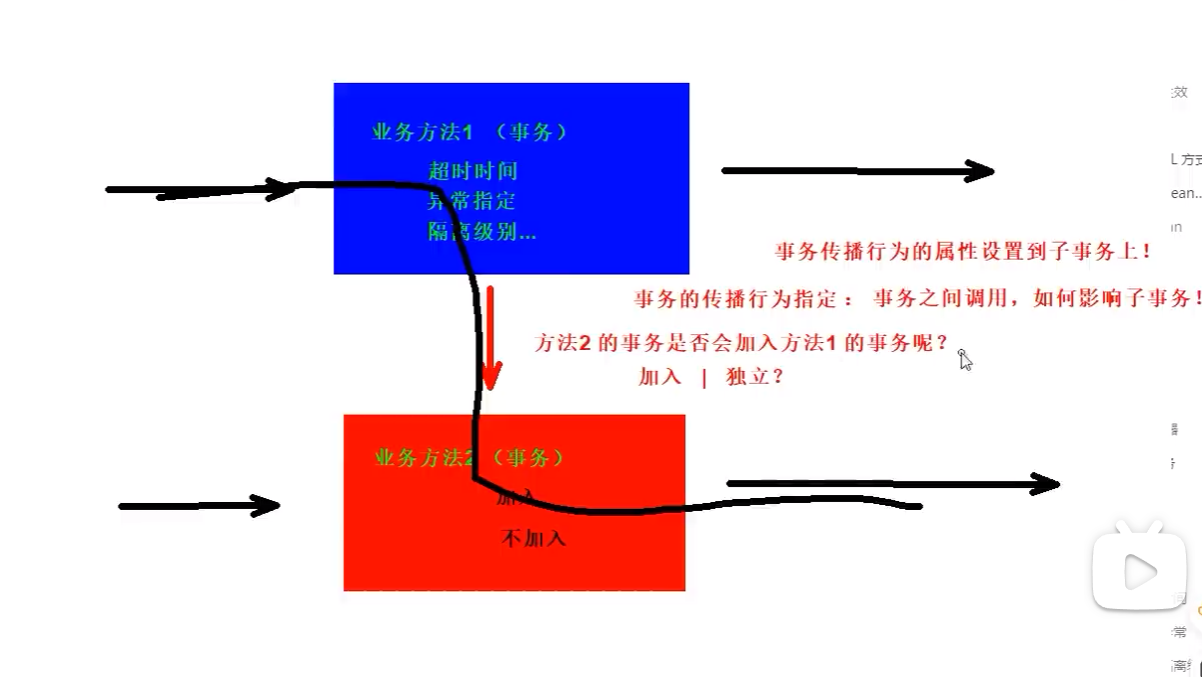
举例代码:
@Transactional public void MethodA(){ // ... MethodB(); // ... } //在被调用的子方法中设置传播行为,代表如何处理调用的事务! 是加入,还是新事务等! @Transactional(propagation = Propagation.REQUIRES_NEW) public void MethodB(){ // ... } -
propagation属性
@Transactional 注解通过 propagation 属性设置事务的传播行为。它的默认值是:
Propagation propagation() default Propagation.REQUIRED;propagation 属性的可选值由 org.springframework.transaction.annotation.Propagation 枚举类提供:
名称 含义 REQUIRED 默认值 如果父方法有事务,就加入,如果没有就新建自己独立! REQUIRES_NEW 不管父方法是否有事务,我都新建事务,都是独立的! -
测试
- 声明两个业务方法
@Service public class StudentService { @Autowired private StudentDao studentDao; /** * timeout设置事务超时时间,单位秒! 默认: -1 永不超时,不限制事务时间! * rollbackFor = 指定哪些异常才会回滚,默认是 RuntimeException and Error 异常方可回滚! * noRollbackFor = 指定哪些异常不会回滚, 默认没有指定,如果指定,应该在rollbackFor的范围内! * isolation = 设置事务的隔离级别,mysql默认是repeatable read! */ @Transactional(readOnly = false, timeout = 3, rollbackFor = Exception.class, noRollbackFor = FileNotFoundException.class, isolation = Isolation.REPEATABLE_READ) public void changeInfo() throws FileNotFoundException { studentDao.updateAgeById(100,1); //主动抛出一个检查异常,测试! 发现不会回滚,因为不在rollbackFor的默认范围内! new FileInputStream("xxxx"); studentDao.updateNameById("test1",1); } /** * 声明两个独立修改数据库的事务业务方法 */ @Transactional(propagation = Propagation.REQUIRED) public void changeAge(){ studentDao.updateAgeById(99,1); } @Transactional(propagation = Propagation.REQUIRED) public void changeName(){ studentDao.updateNameById("test2",1); int i = 1/0; } } - 声明一个整合业务方法
@Service public class TopService { @Autowired private StudentService studentService; @Transactional public void topService(){ studentService.changeAge(); studentService.changeName(); } } - 添加传播行为测试
注意:@SpringJUnitConfig(classes = AppConfig.class) public class TxTest { @Autowired private StudentService studentService; @Autowired private TopService topService; @Test public void testTx() throws FileNotFoundException { topService.topService(); } }
在同一个类中,对于@Transactional注解的方法调用,事务传播行为不会生效。这是因为Spring框架中使用代理模式实现了事务机制,在同一个类中的方法调用并不经过代理,而是通过对象的方法调用,因此@Transactional注解的设置不会被代理捕获,也就不会产生任何事务传播行为的效果。
- 声明两个业务方法
-
其他传播行为值(了解)
- Propagation.REQUIRED:如果当前存在事务,则加入当前事务,否则创建一个新事务。
- Propagation.REQUIRES_NEW:创建一个新事务,并在新事务中执行。如果当前存在事务,则挂起当前事务,即使新事务抛出异常,也不会影响当前事务。
- Propagation.NESTED:如果当前存在事务,则在该事务中嵌套一个新事务,如果没有事务,则与Propagation.REQUIRED一样。
- Propagation.SUPPORTS:如果当前存在事务,则加入该事务,否则以非事务方式执行。
- Propagation.NOT_SUPPORTED:以非事务方式执行,如果当前存在事务,挂起该事务。
- Propagation.MANDATORY:必须在一个已有的事务中执行,否则抛出异常。
- Propagation.NEVER:必须在没有事务的情况下执行,否则抛出异常。
汇总回顾
Spring 声明式事务
spring事务声明 即是对AOP的二次封装
使用过程基本还是那个步骤
dao层创建
package com.jovey.dao;
import org.springframework.beans.factory.annotation.Autowired;
import org.springframework.jdbc.core.JdbcTemplate;
import org.springframework.stereotype.Repository;
@Repository
public class StudentDao {
@Autowired
private JdbcTemplate jdbcTemplate;
public void updateNameById(String name,Integer id){
String sql = "update students set name = ? where id = ? ;";
int rows = jdbcTemplate.update(sql, name, id);
}
public void updateAgeById(Integer age,Integer id){
String sql = "update students set age = ? where id = ? ;";
jdbcTemplate.update(sql,age,id);
}
}
配置类编写
package com.jovey.config;
import com.alibaba.druid.pool.DruidDataSource;
import org.springframework.beans.factory.annotation.Value;
import org.springframework.context.annotation.Bean;
import org.springframework.context.annotation.ComponentScan;
import org.springframework.context.annotation.Configuration;
import org.springframework.context.annotation.PropertySource;
import org.springframework.jdbc.core.JdbcTemplate;
import org.springframework.jdbc.datasource.DataSourceTransactionManager;
import org.springframework.transaction.TransactionManager;
import javax.sql.DataSource;
@Configuration
@ComponentScan("com.jovey")
@PropertySource("classpath:jdbc.properties")
public class JavaConfig {
@Value("${jovey.driver}")
private String driver;
@Value("${jovey.url}")
private String url;
@Value("${jovey.username}")
private String username;
@Value("${jovey.password}")
private String password;
//druid连接池
@Bean
public DataSource dataSource(){
DruidDataSource dataSource = new DruidDataSource();
dataSource.setDriverClassName(driver);
dataSource.setUrl(url);
dataSource.setUsername(username);
dataSource.setPassword(password);
return dataSource;
}
@Bean
//jdbcTemplate
public JdbcTemplate jdbcTemplate(DataSource dataSource){
JdbcTemplate jdbcTemplate = new JdbcTemplate();
jdbcTemplate.setDataSource(dataSource);
return jdbcTemplate;
}
@Bean
public TransactionManager transactionManager(DataSource dataSource){
//内部要进行事务的操作,基于的连接池
DataSourceTransactionManager dataSourceTransactionManager = new DataSourceTransactionManager();
//需要连接池对象
dataSourceTransactionManager.setDataSource(dataSource);
return dataSourceTransactionManager;
}
}
service层业务编写
package com.jovey.service;
import com.jovey.dao.StudentDao;
import org.springframework.beans.factory.annotation.Autowired;
import org.springframework.stereotype.Service;
import org.springframework.transaction.annotation.Isolation;
import org.springframework.transaction.annotation.Propagation;
import org.springframework.transaction.annotation.Transactional;
import java.io.FileInputStream;
import java.io.FileNotFoundException;
@Transactional(timeout = 3)
@Service
public class StudentService {
@Autowired
private StudentDao studentDao;
/**
* 添加事务:
* @Transactional
* 位置: 方法 | 类上
* 方法: 当前方法有事务
* 类上: 类下的所有方法都有事务
*
* 1.只读模式
* 只读模式可以提升查询事务的效率! 推荐事务中只有查询代码,使用只读模式!
* 默认: boolean readOnly() default false;
* 解释: 一般情况下,都是通过类添加注解添加事务!
* 类下的所有方法都有事务!
* 查询方法可以通过再次添加注解,设置为只读模式,提高效率!
*
* 2.超时时间
* 默认: 永远不超时 -1
* 设置 timeout = 时间 秒数 超过时间,就会回滚事务和释放异常! TransactionTimedOutException
* 如果类上设置事务属性,方法也设置了事务注解! 方法会不会生效??
* 不会生效: 方法上的注解覆盖了类上的注解!
*
* 3.指定异常回滚和指定异常不回滚:
* 默认情况下,指定发生运行时异常事务才会回滚!
* 我们可以指定Exception异常来控制所有异常都回滚!
* rollbackFor = Exception.class
* noRollbackFor = 回滚异常范围内,控制某个异常不回滚!
*
* 4.隔离级别设置
* 推荐设置第二个隔离级别!
* isolation = Isolation.READ_COMMITTED
*
*/
@Transactional(readOnly = false ,rollbackFor = Exception.class , noRollbackFor = FileNotFoundException.class
,isolation = Isolation.READ_COMMITTED)
public void changeInfo() throws FileNotFoundException {
studentDao.updateAgeById(99,1);
new FileInputStream("xxxx");
studentDao.updateNameById("test3",1);
}
/**
* 声明两个独立修改数据库的事务业务方法
*
* propagation = Propagation.REQUIRED 父方法有事务,我们就加入到父方法的事务!
* 最终是同一个事务! 推荐使用默认值!!
*
* propagation = Propagation.REQUIRES_NEW
* 不管父方法是否有事务,我都是独立的事务!
* 两个事务或者三个事务!
*
*/
@Transactional(propagation = Propagation.REQUIRES_NEW)
public void changeAge(){
studentDao.updateAgeById(998,1);
}
@Transactional(propagation = Propagation.REQUIRES_NEW)
public void changeName(){
studentDao.updateNameById("二狗子",1);
int i = 1/0; //报错
}
@Transactional(readOnly = true)
public void getStudentInfo(){
//查询 没有必要添加事务!
//获取学生信息 查询数据库 不修改
}
}
最后进行测试
七、Spring核心掌握总结
| 核心点 | 掌握目标 |
|---|---|
| spring框架理解 | spring家族和spring framework框架 |
| spring核心功能 | ioc/di , aop , tx |
| spring ioc / di | 组件管理、ioc容器、ioc/di , 三种配置方式 |
| spring aop | aop和aop框架和代理技术、基于注解的aop配置 |
| spring tx | 声明式和编程式事务、动态事务管理器、事务注解、属性 |
